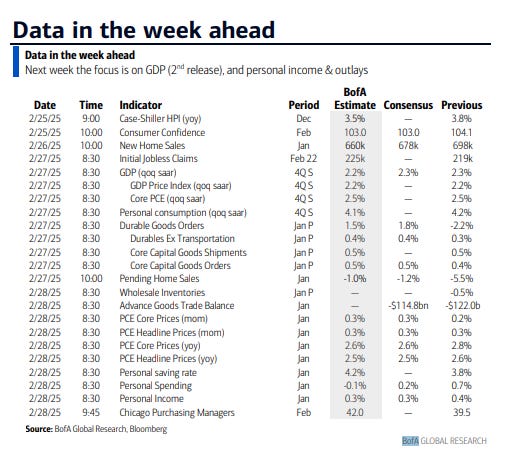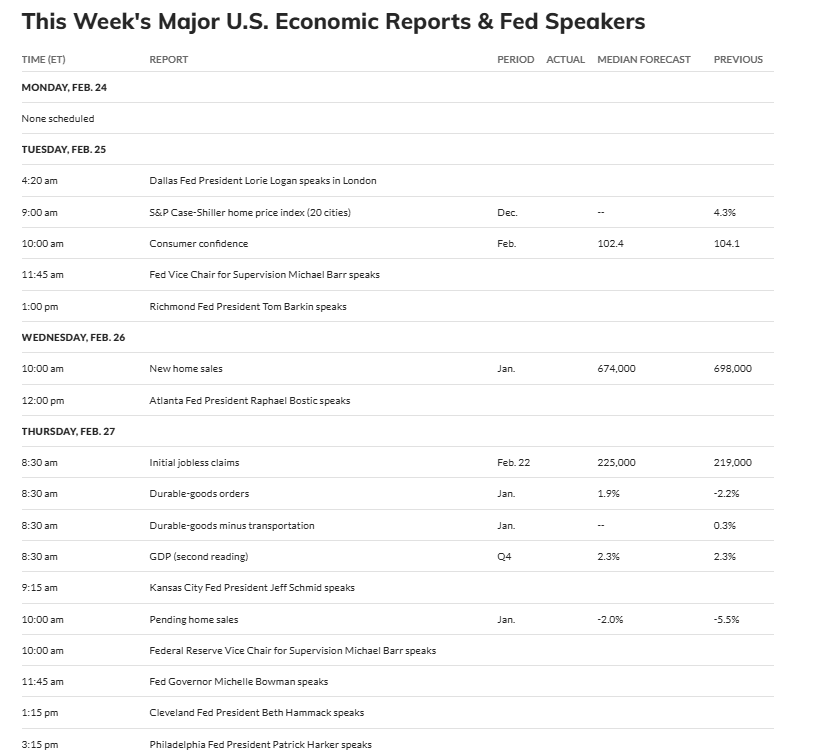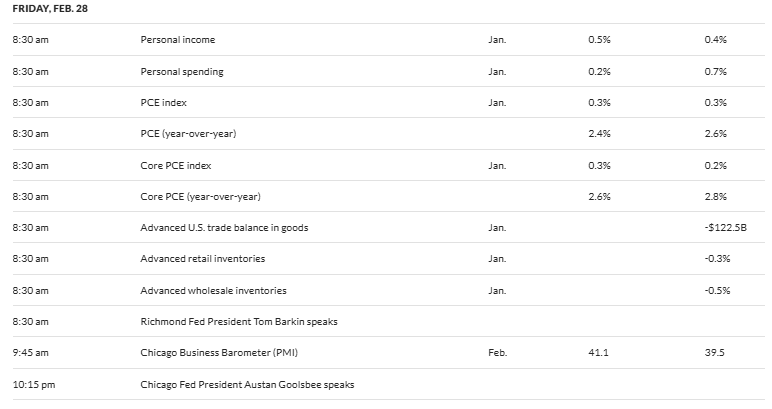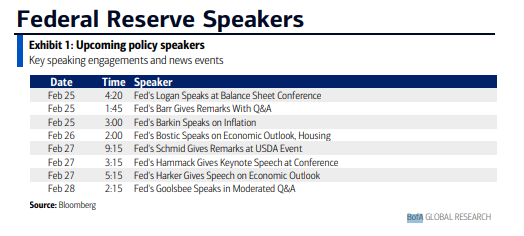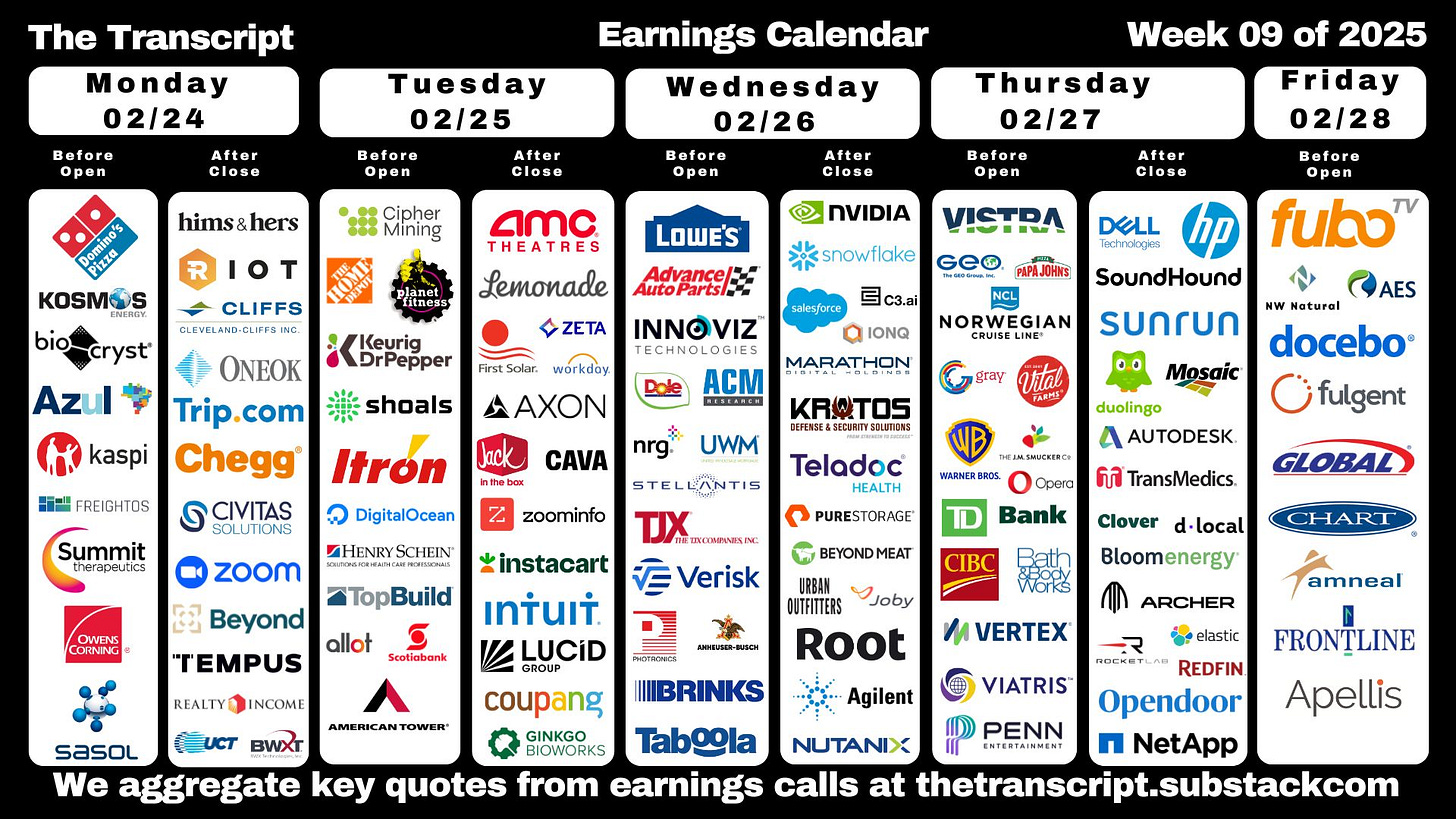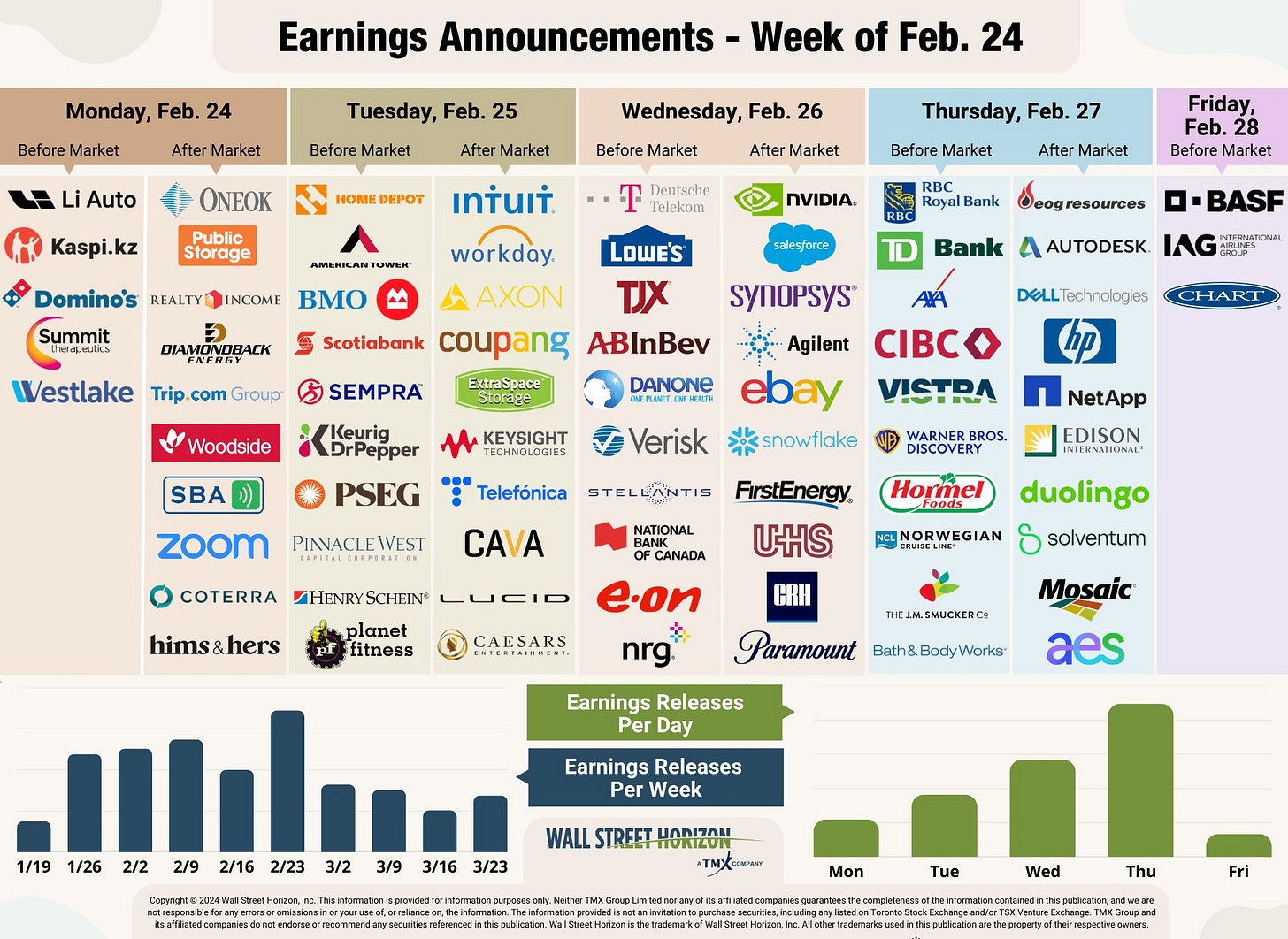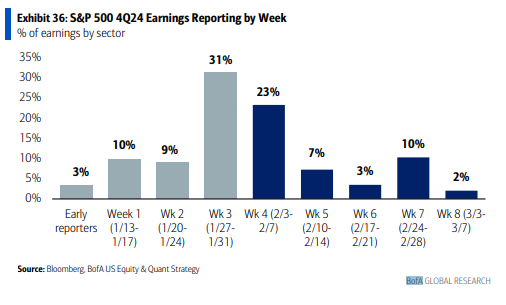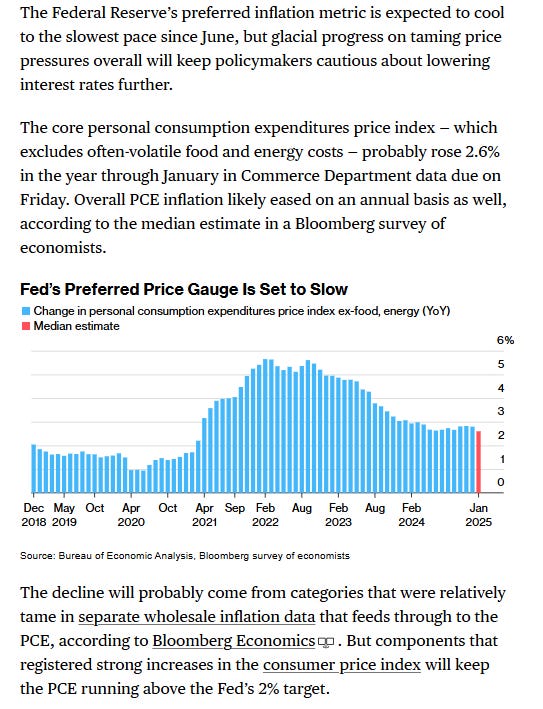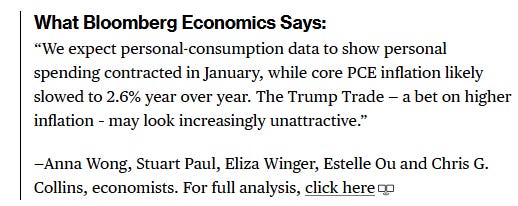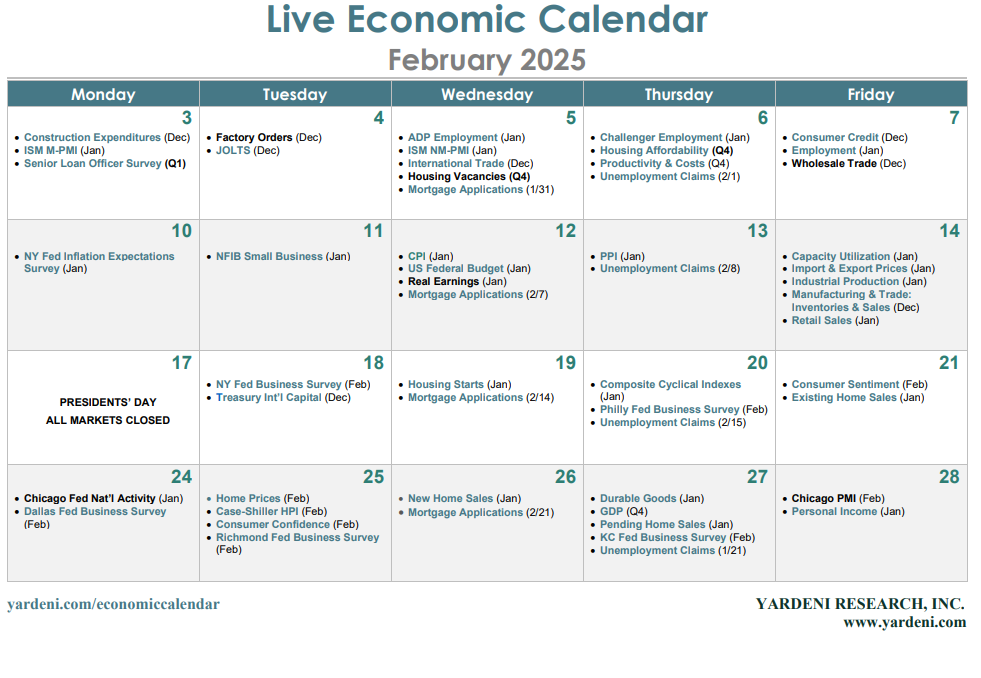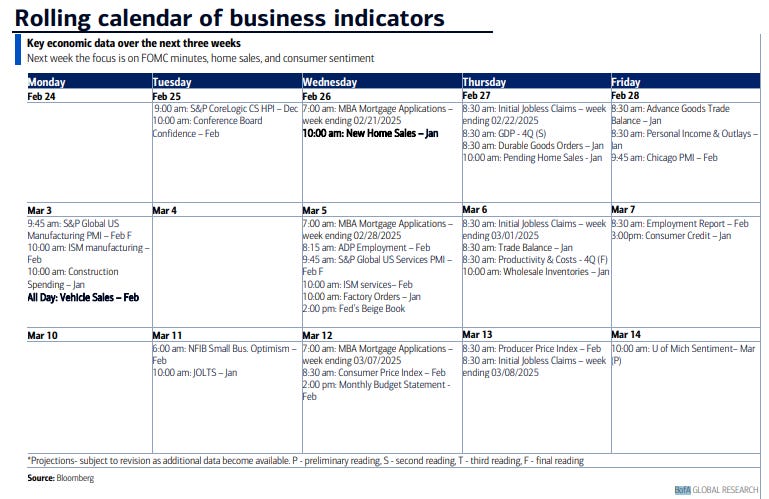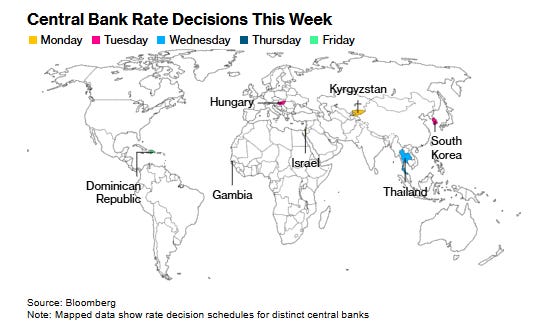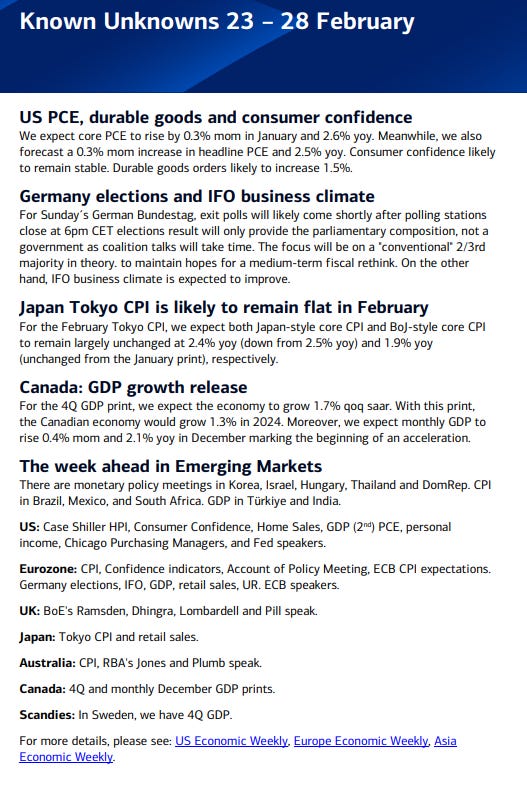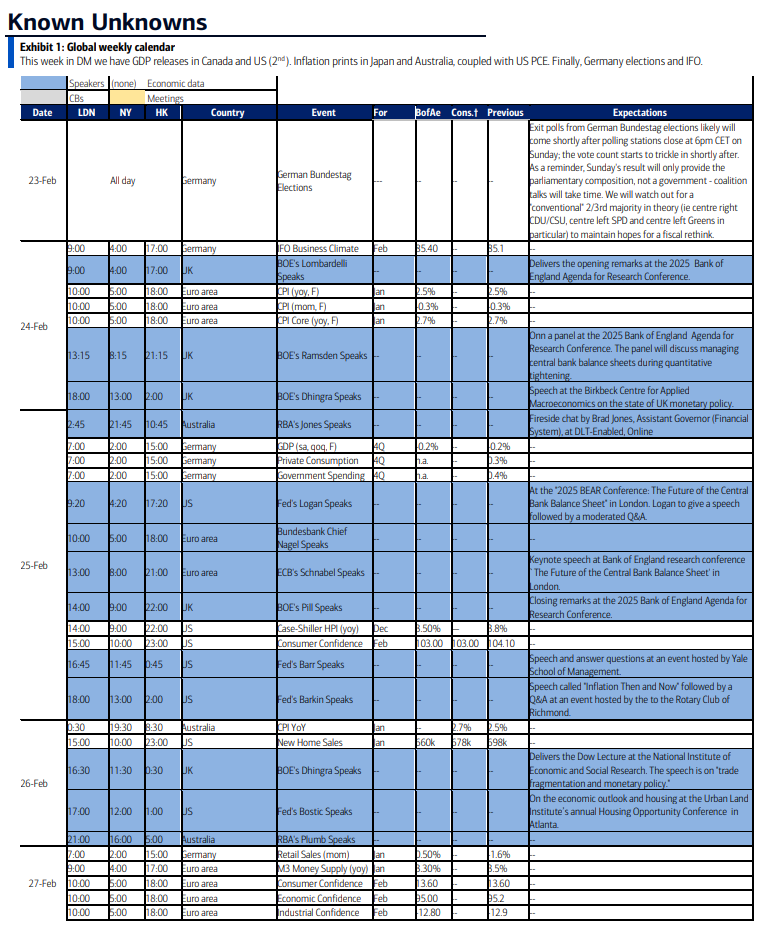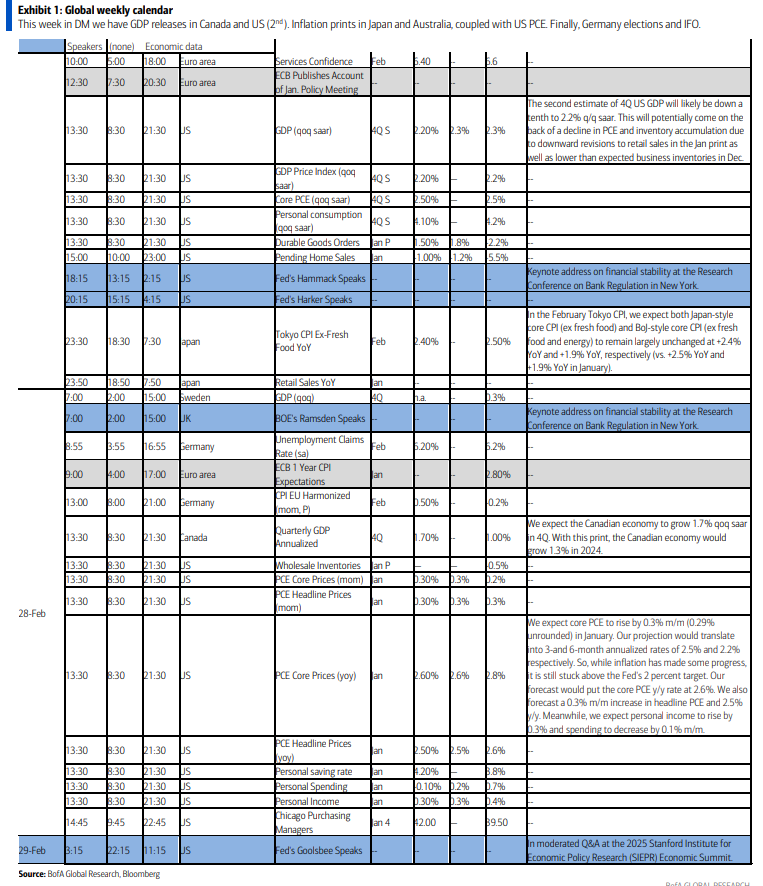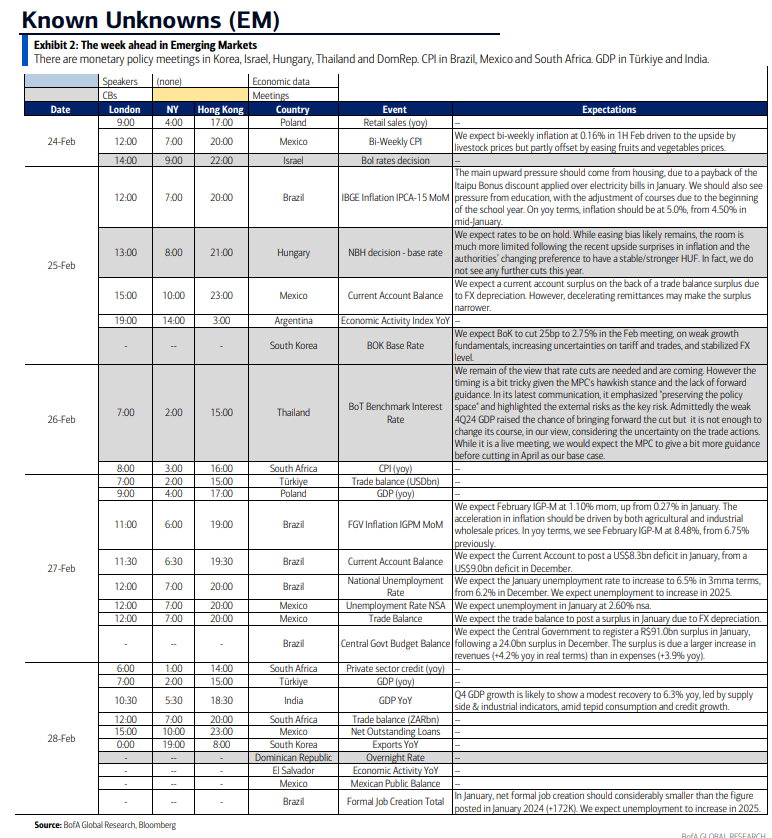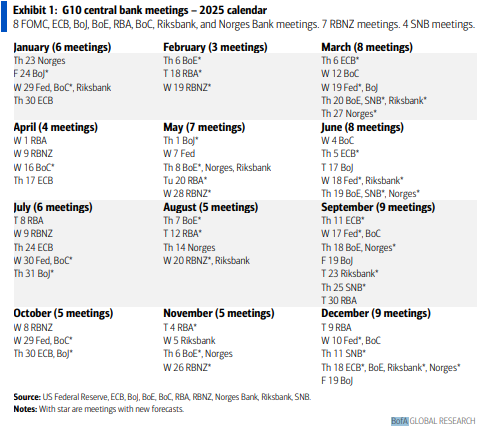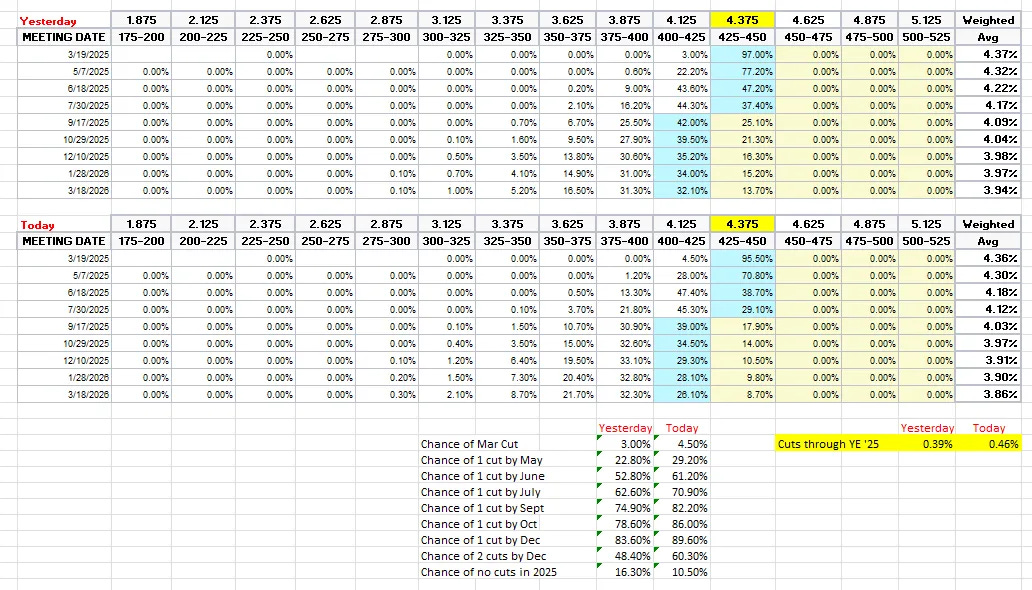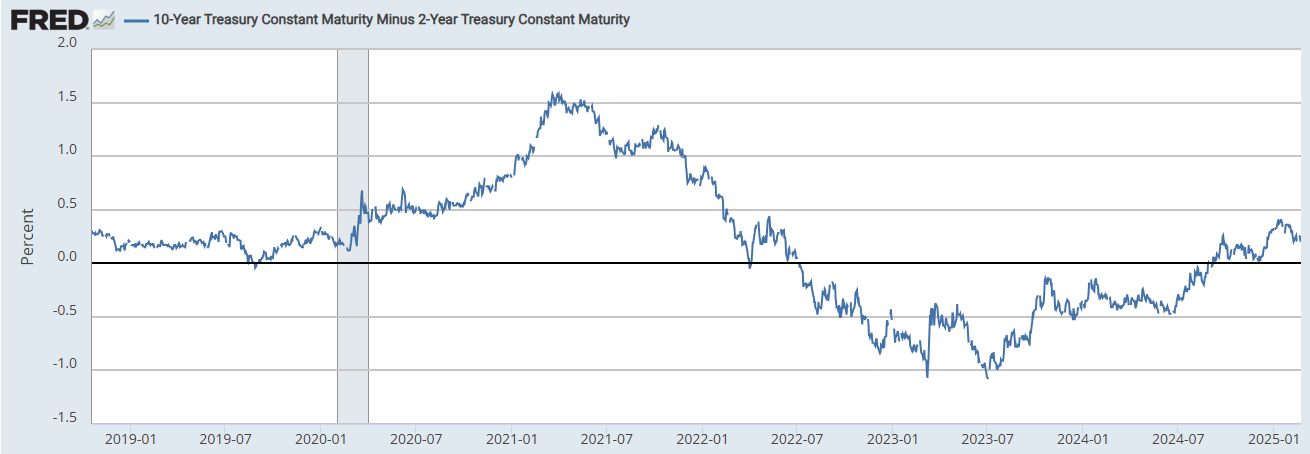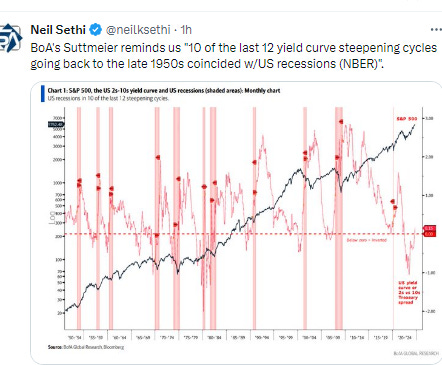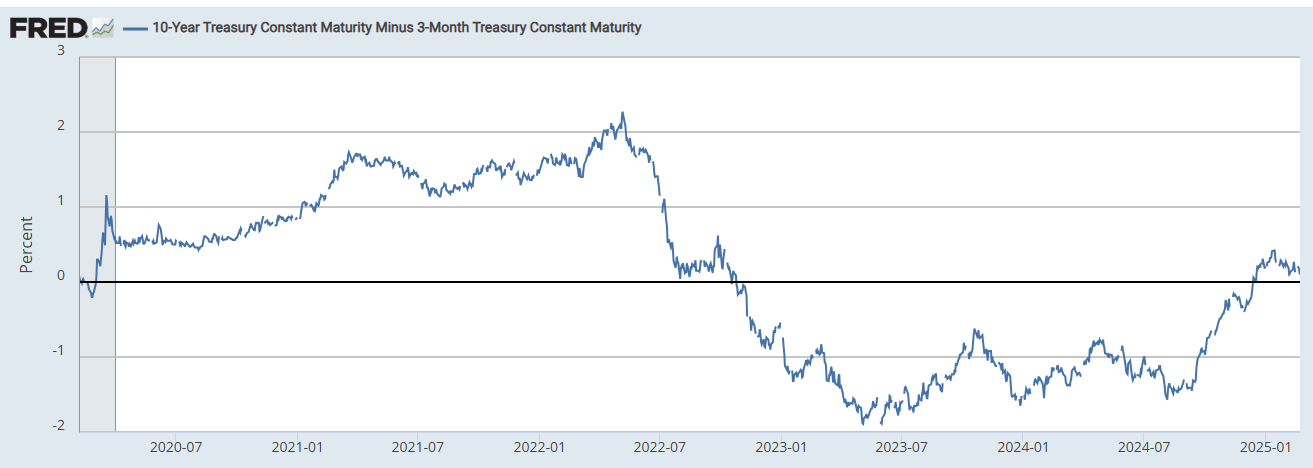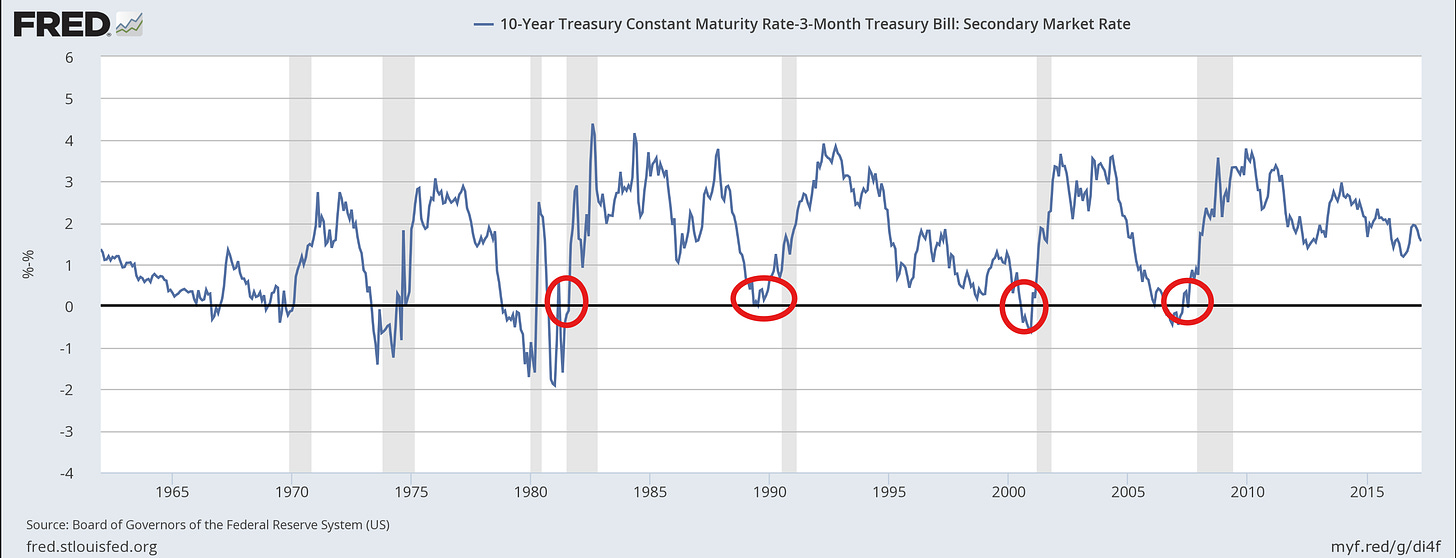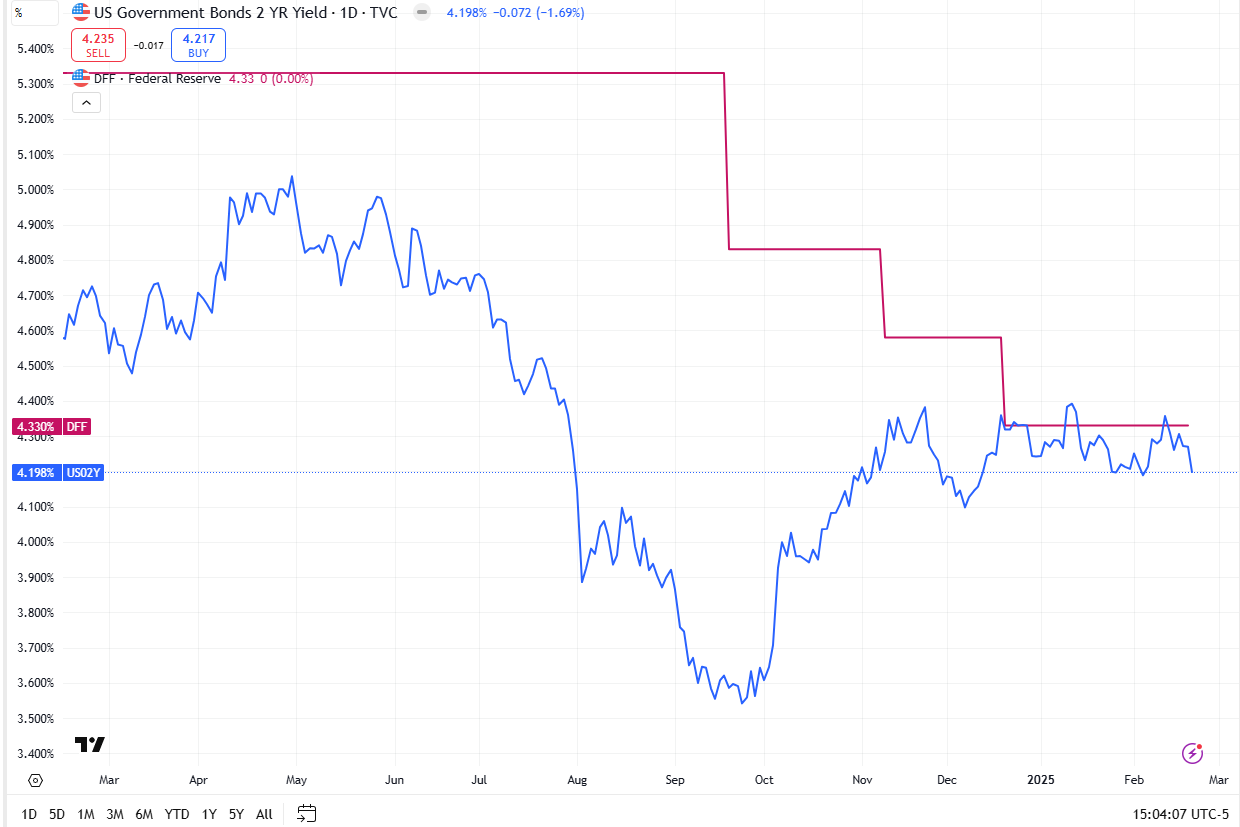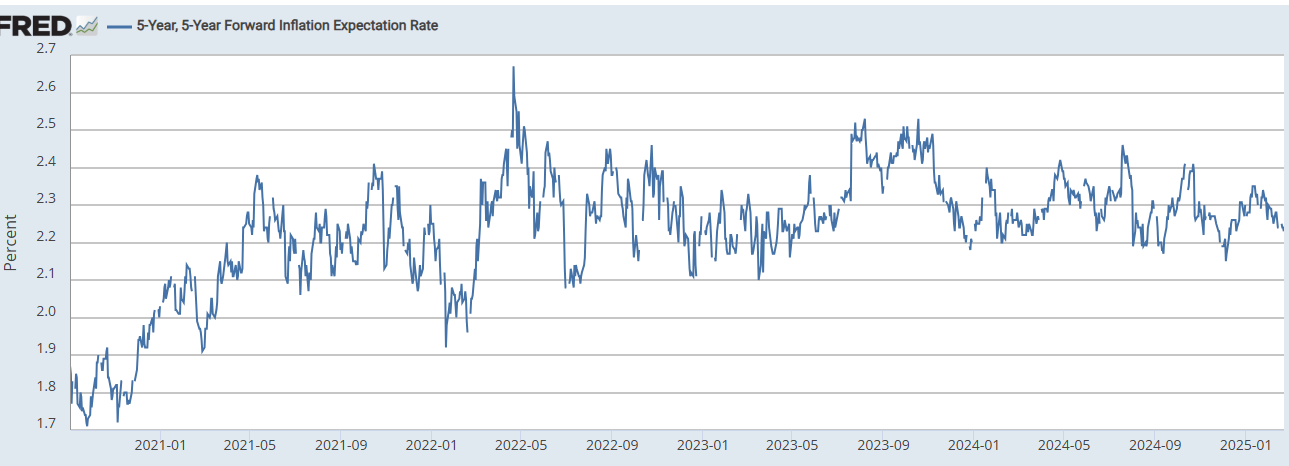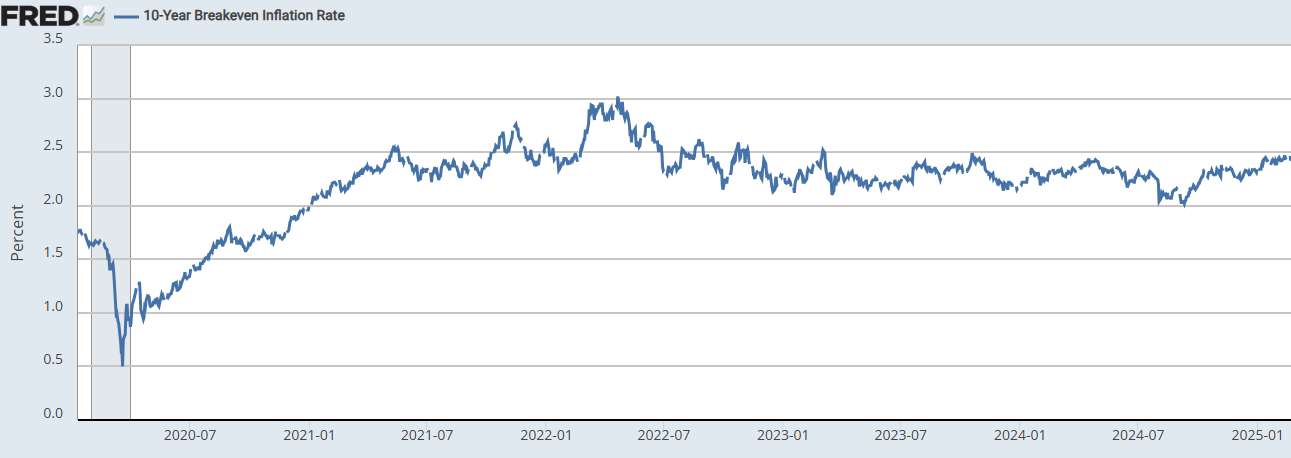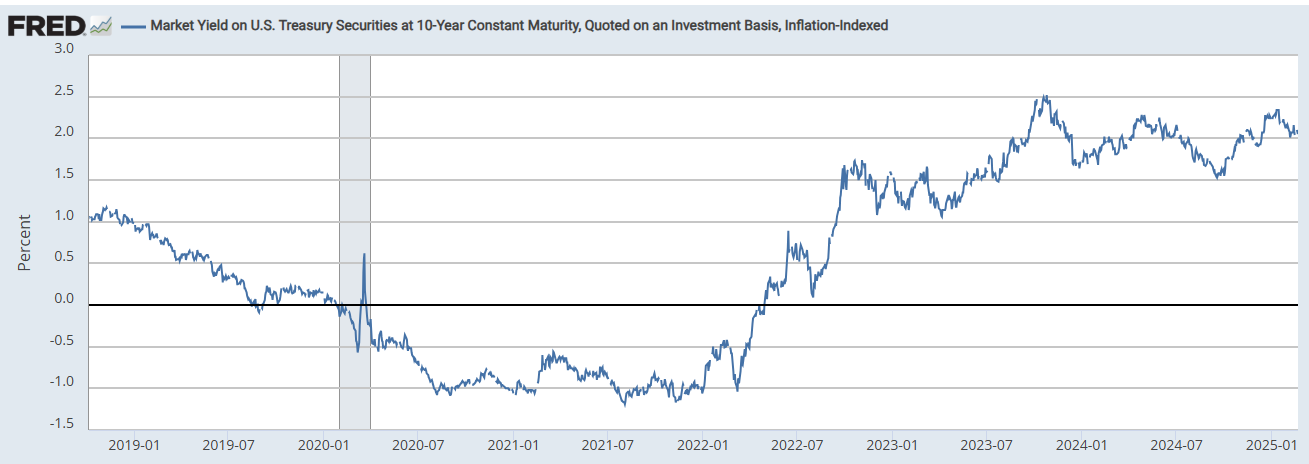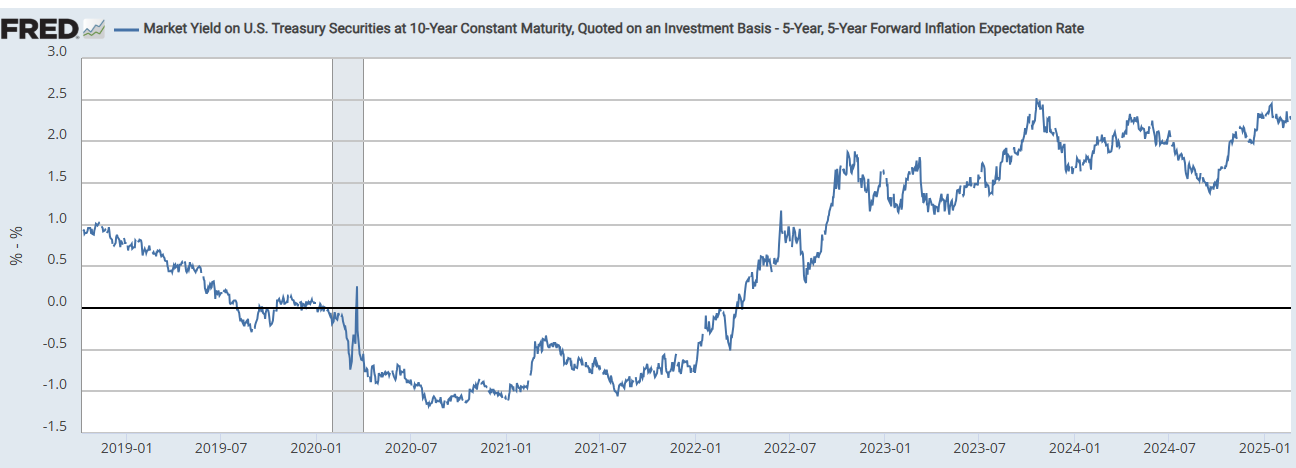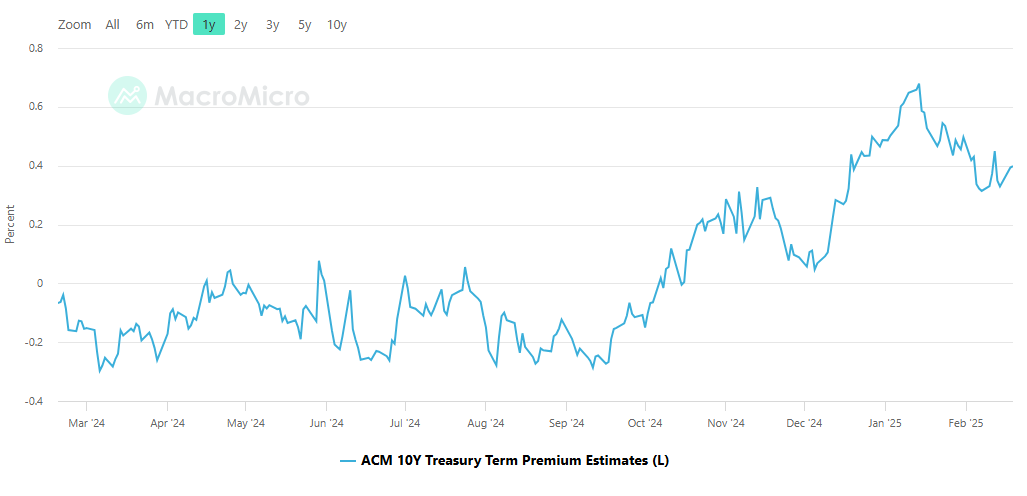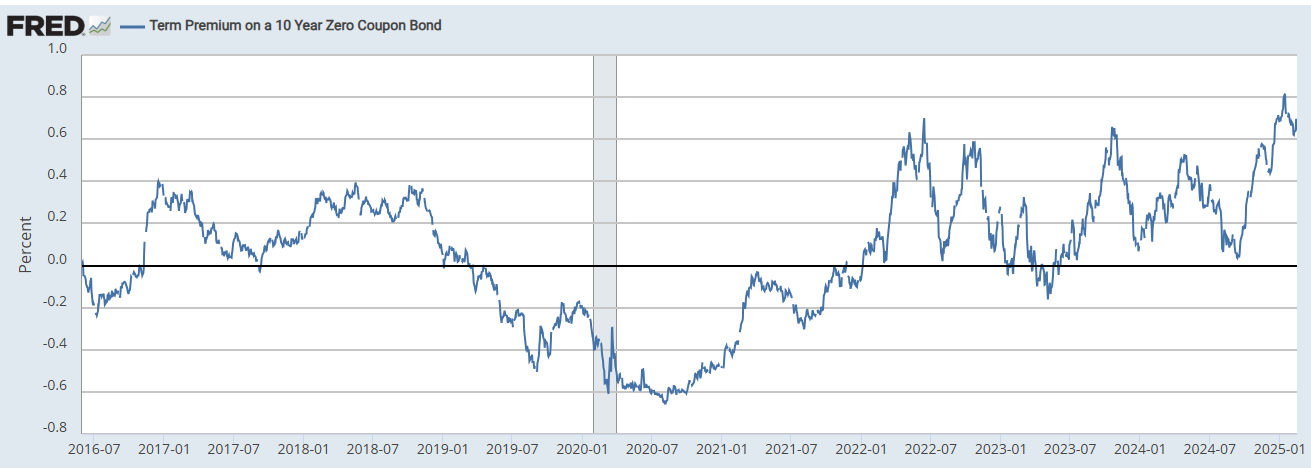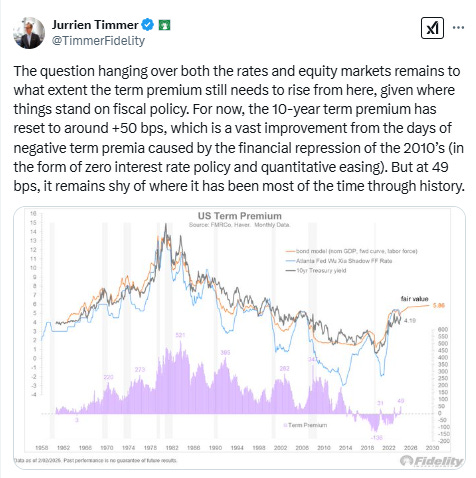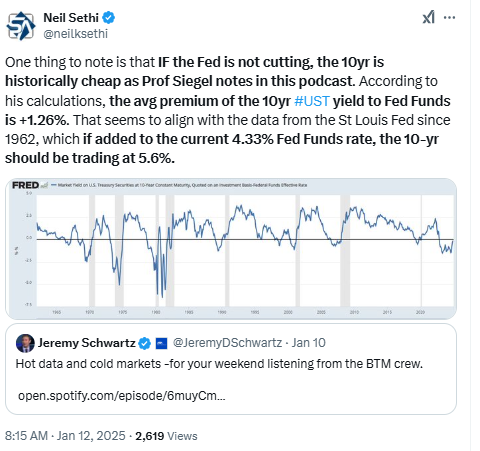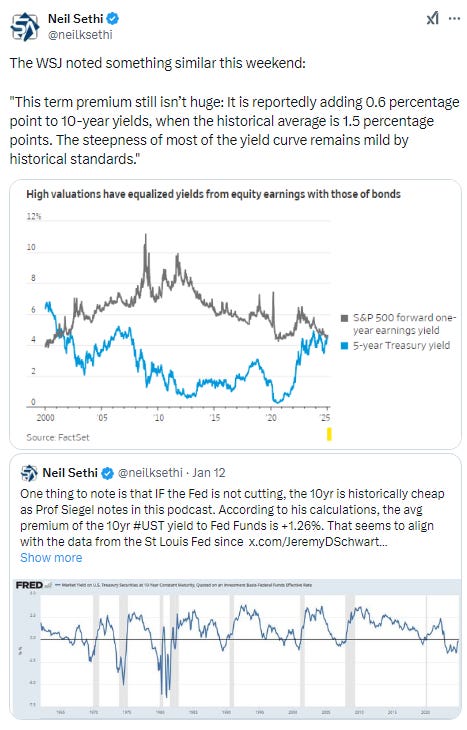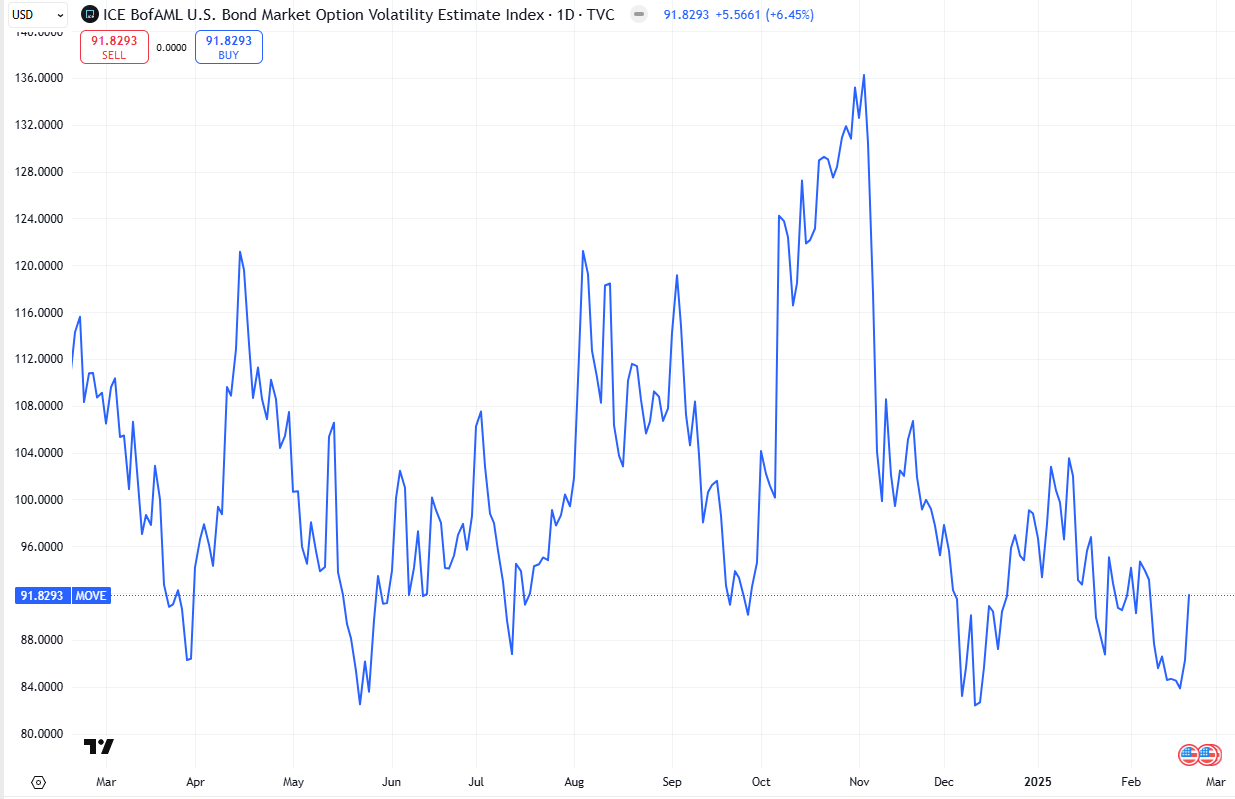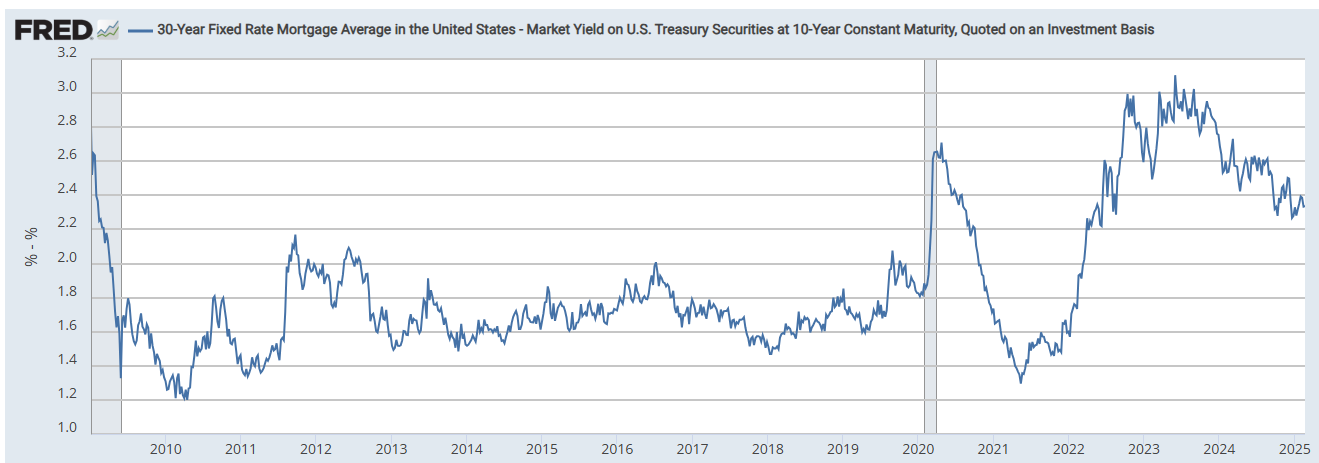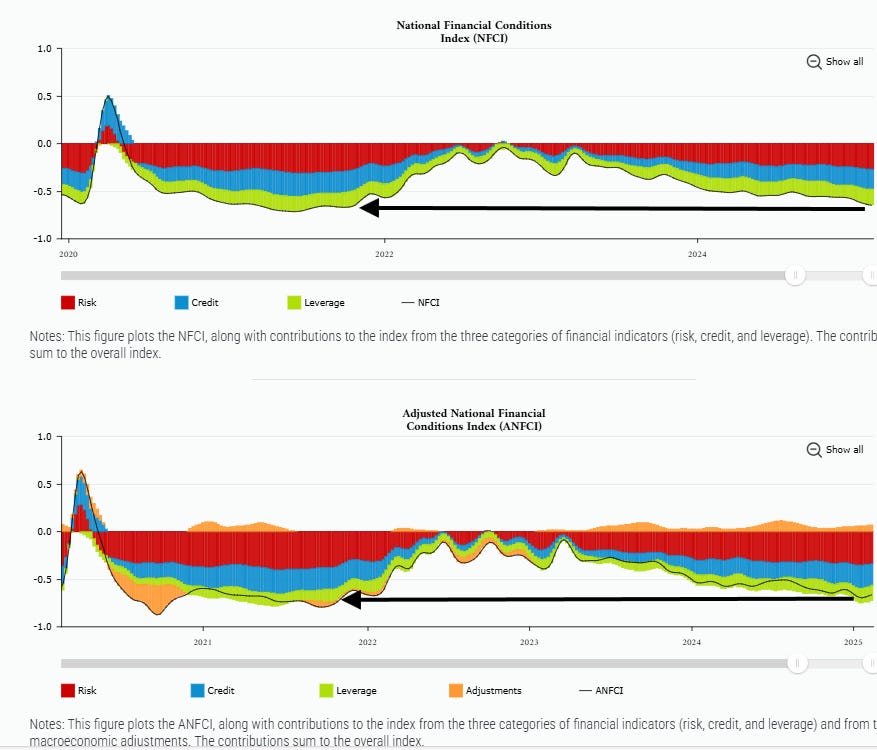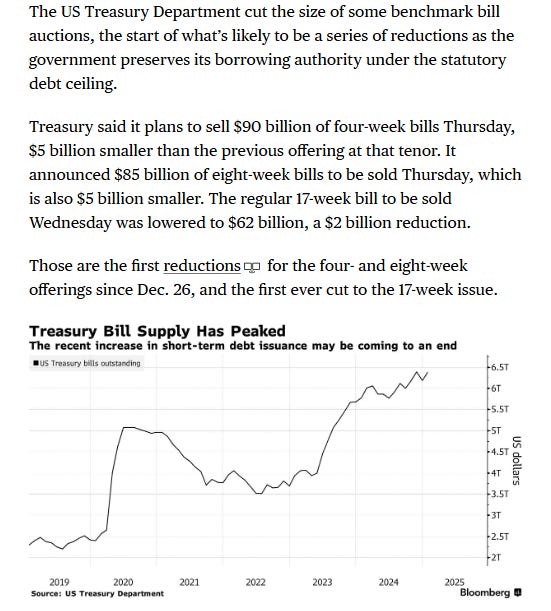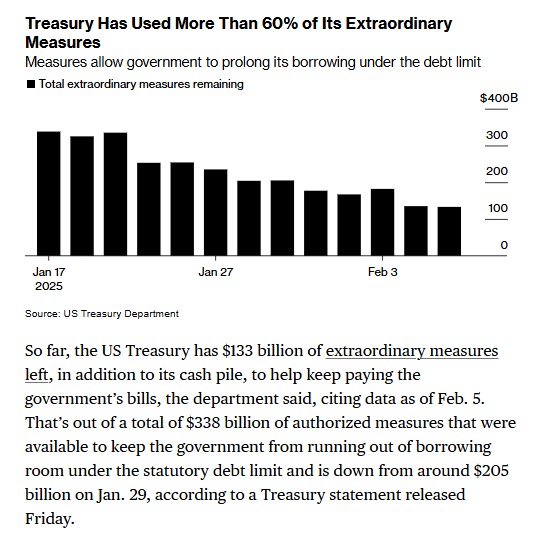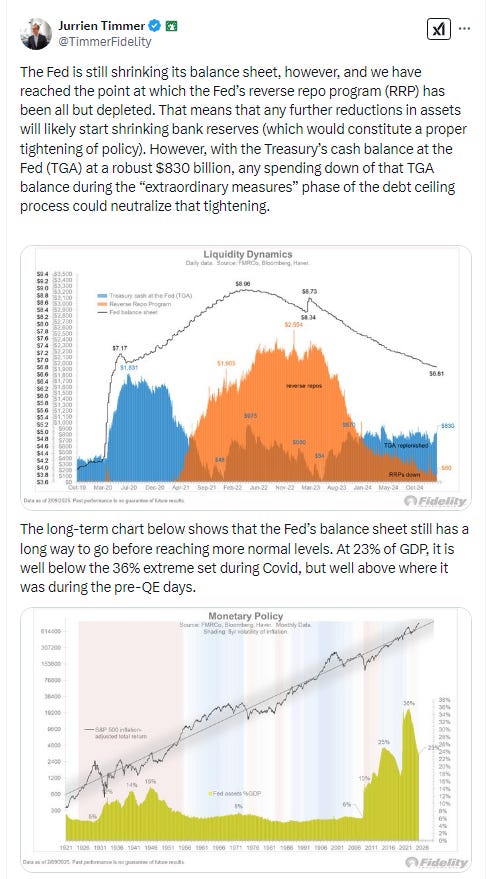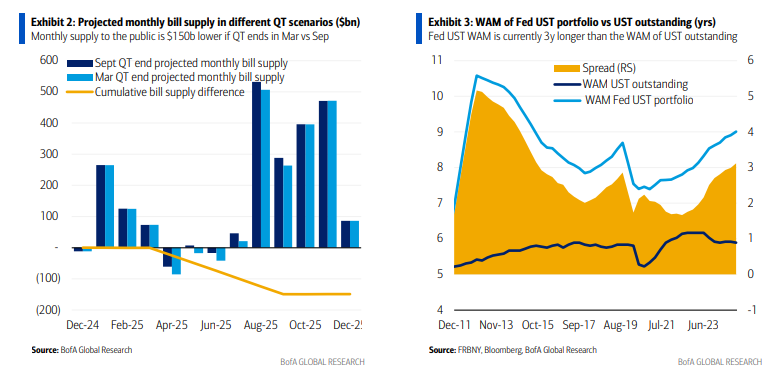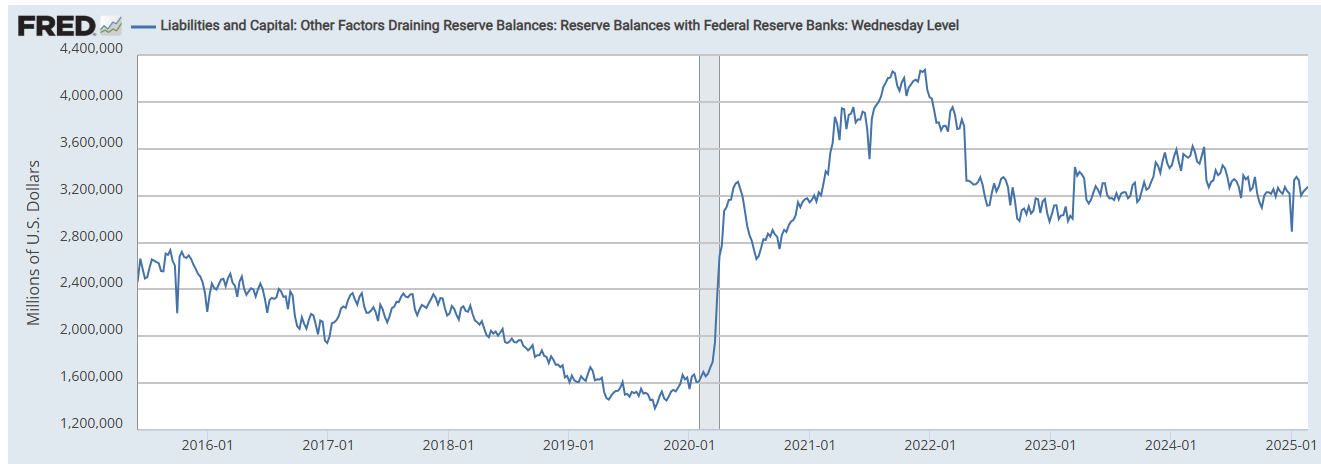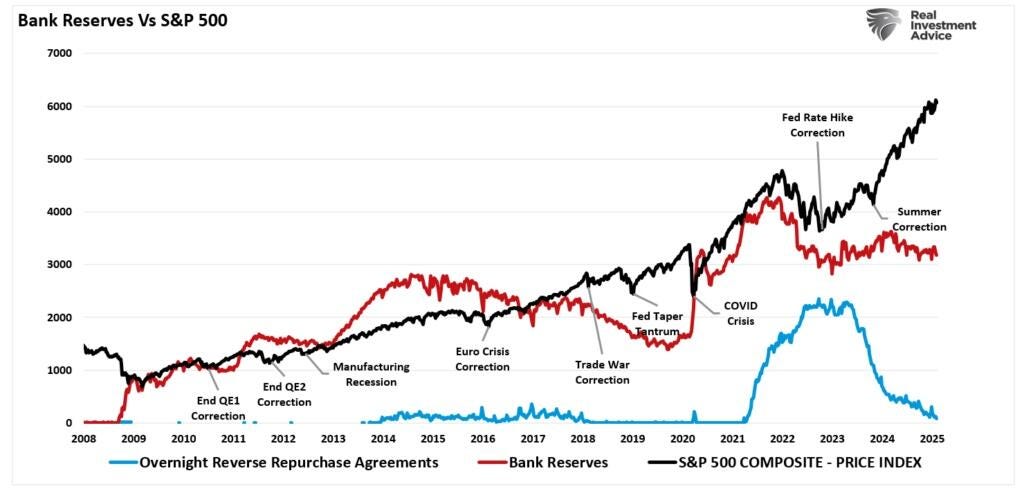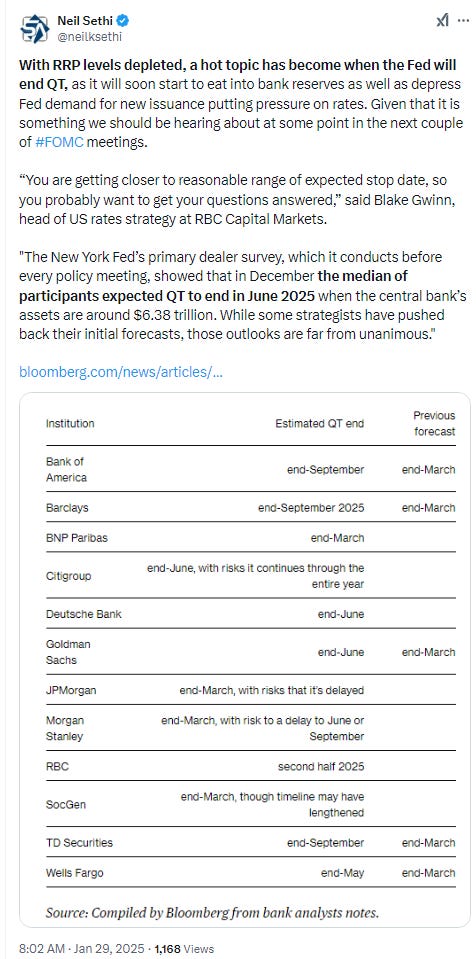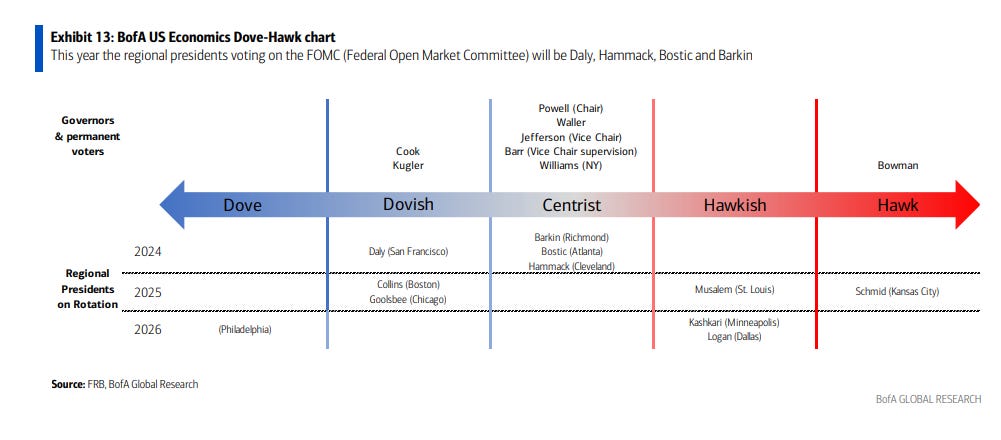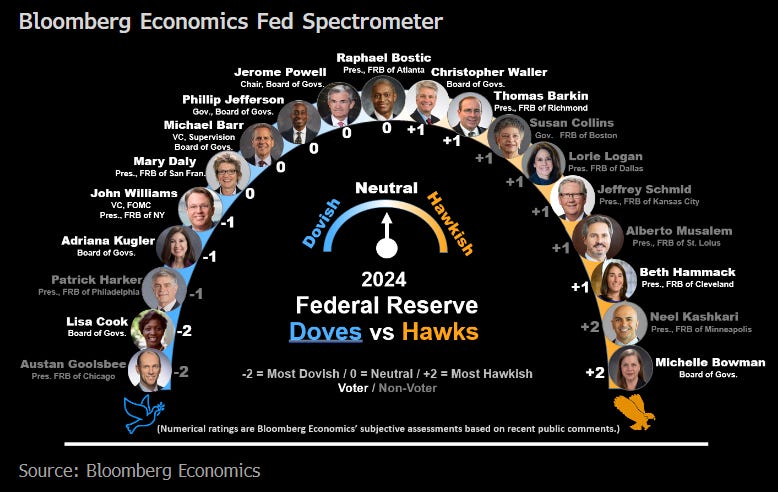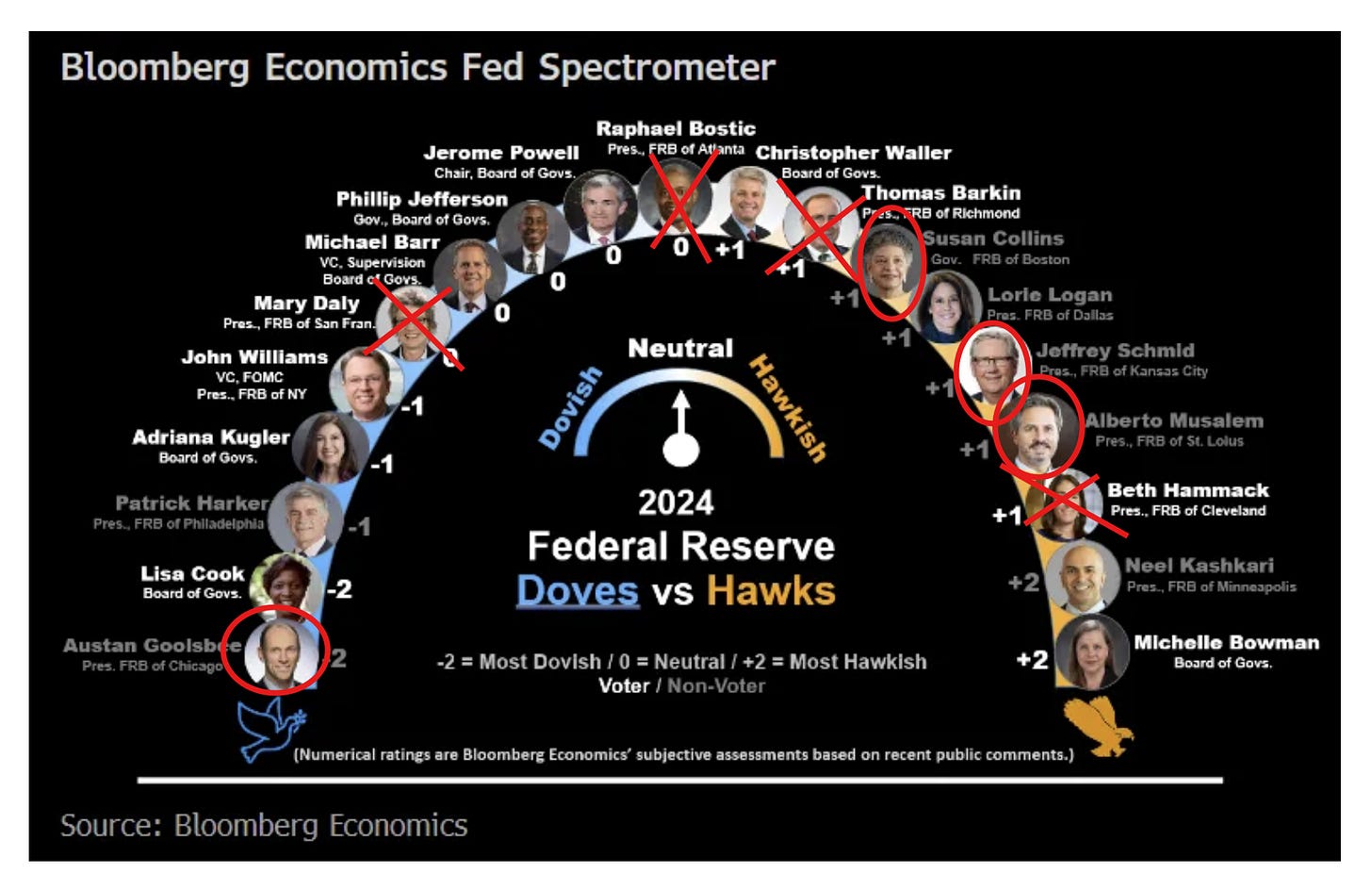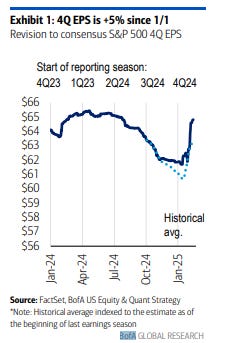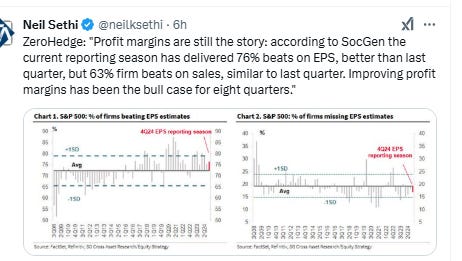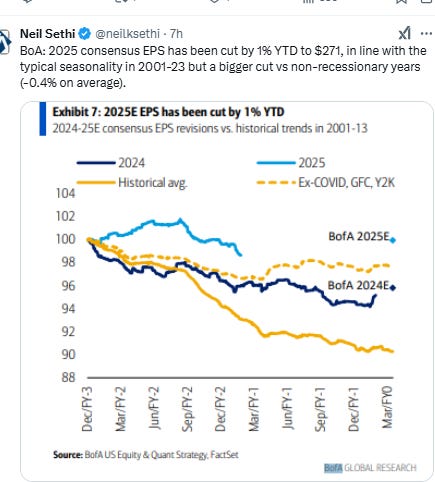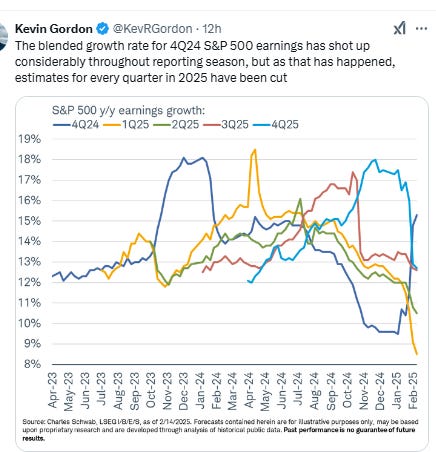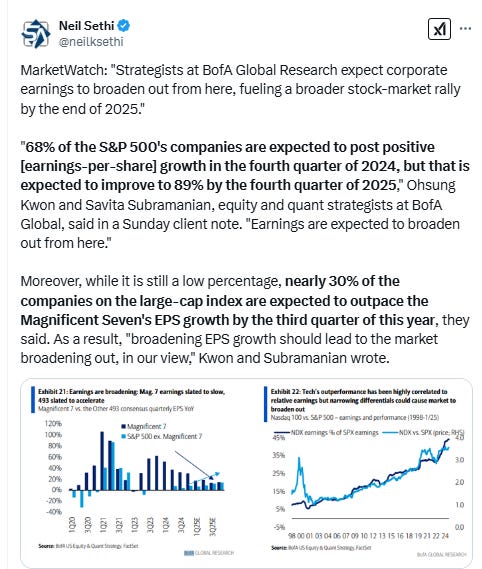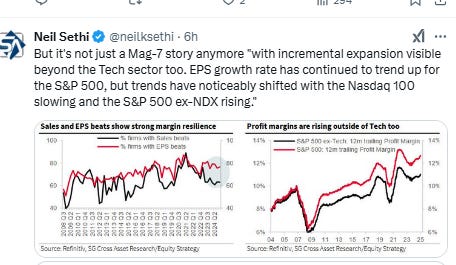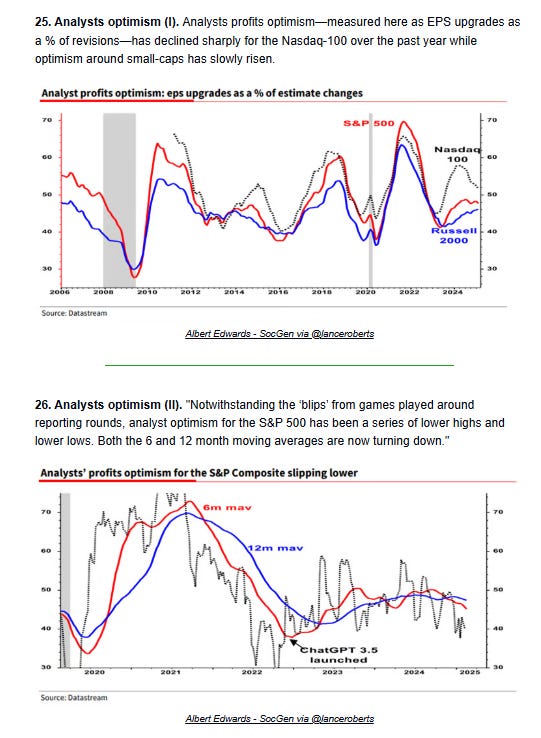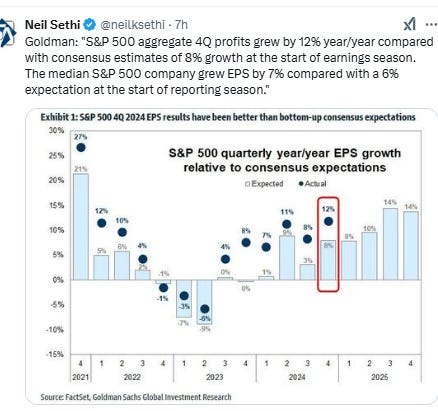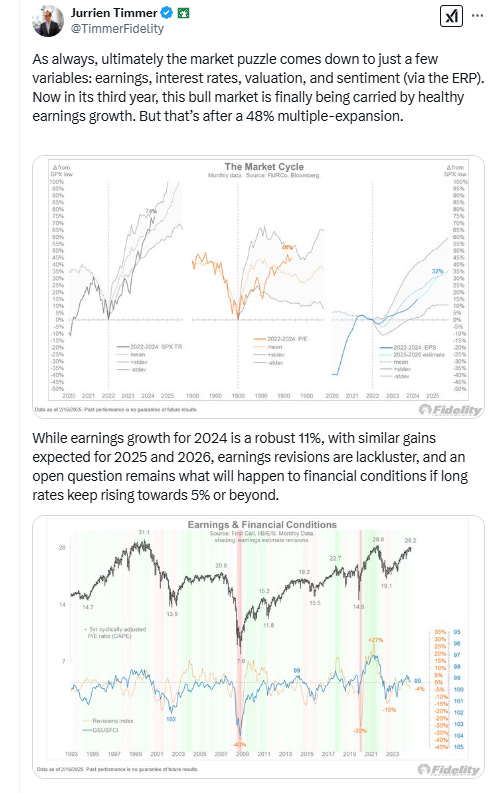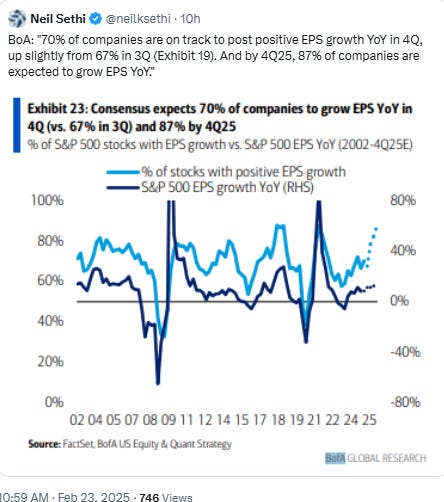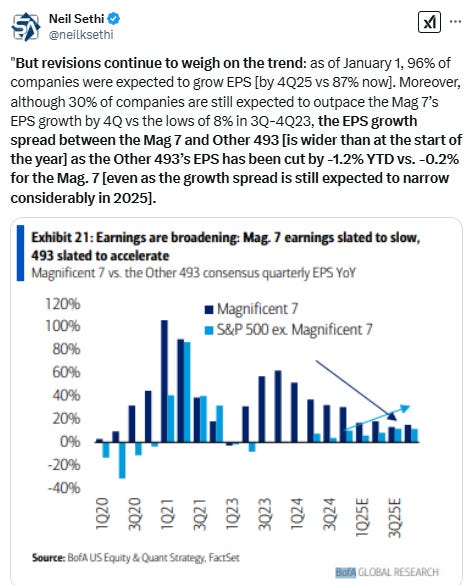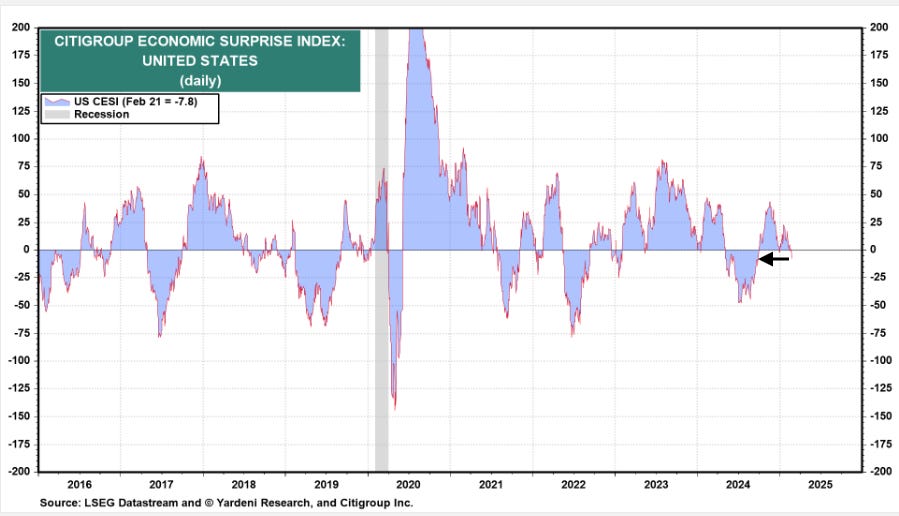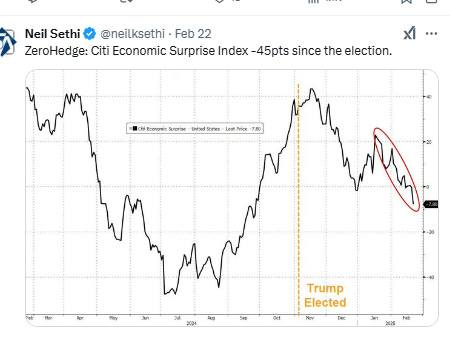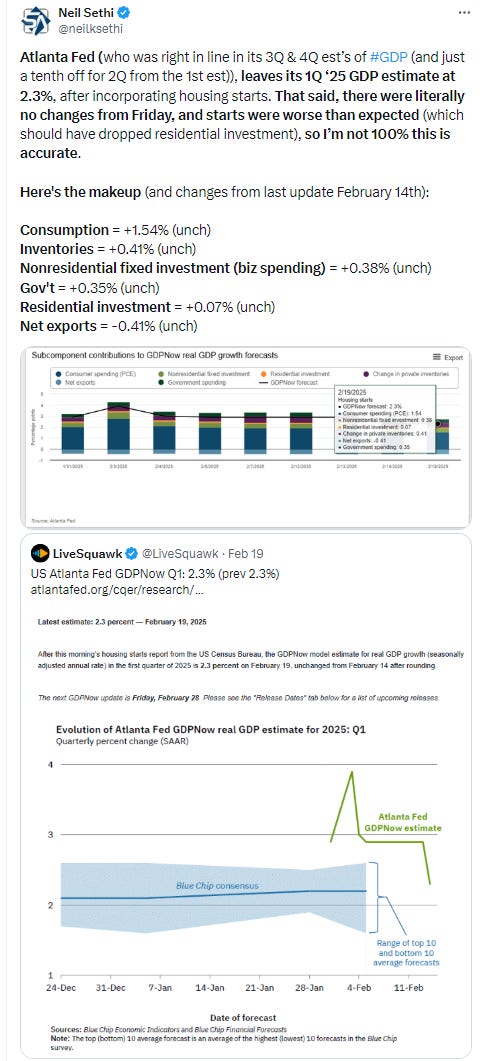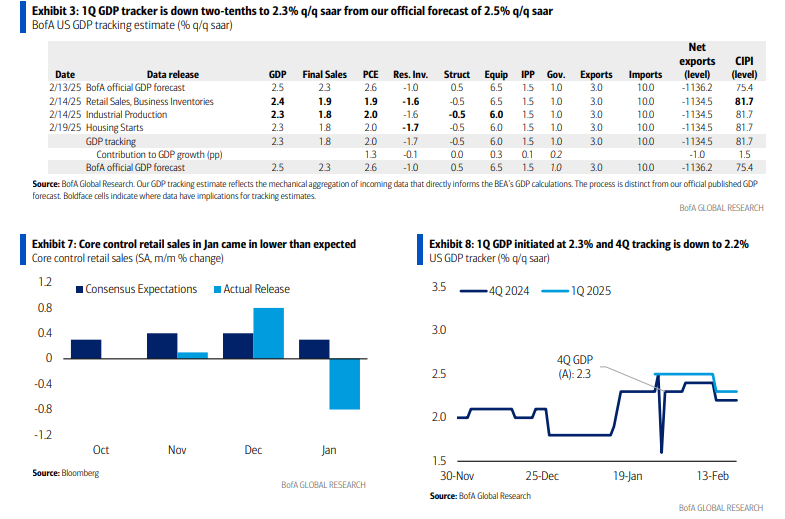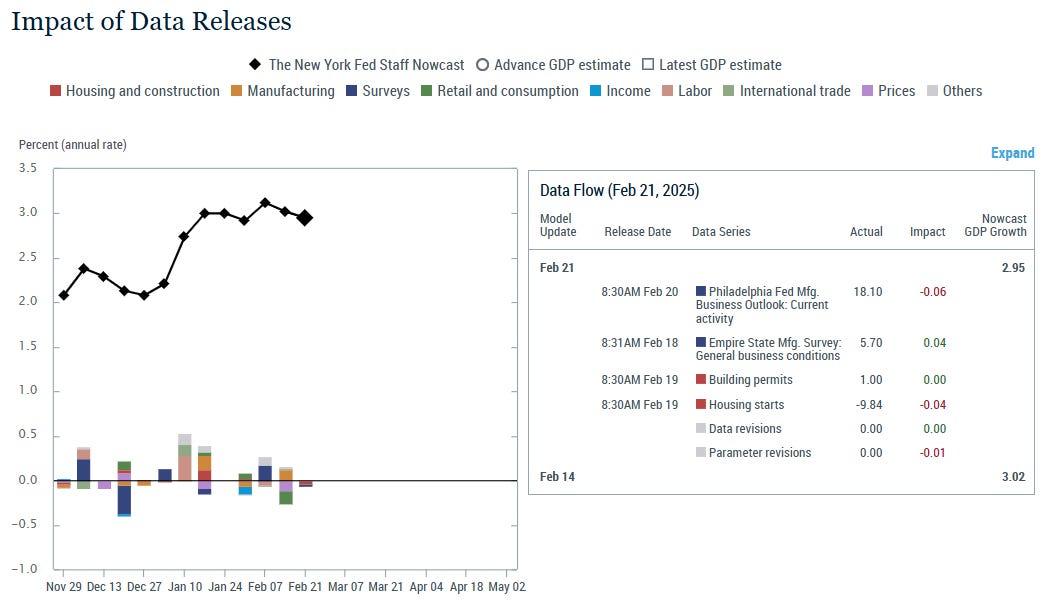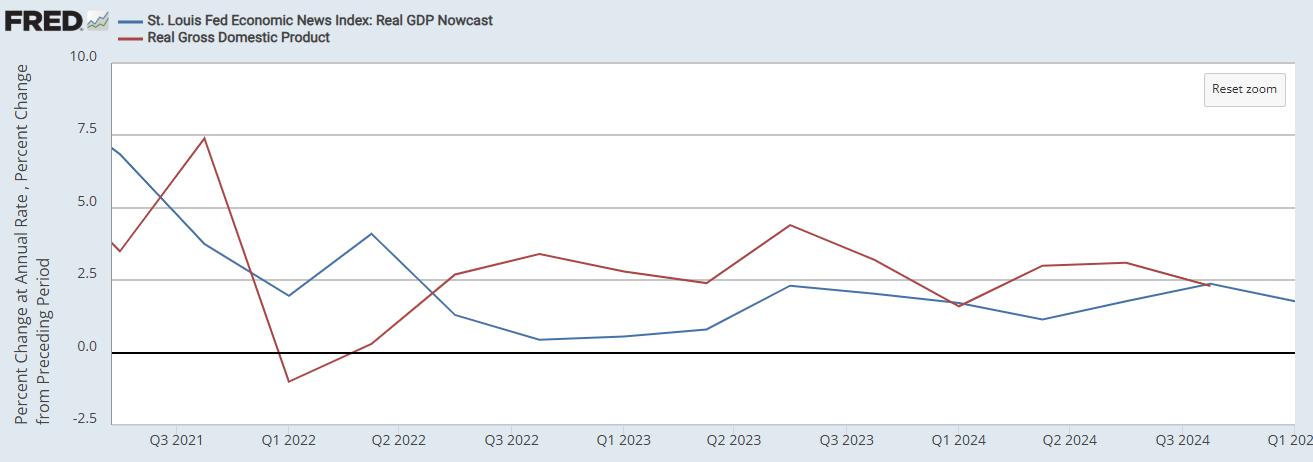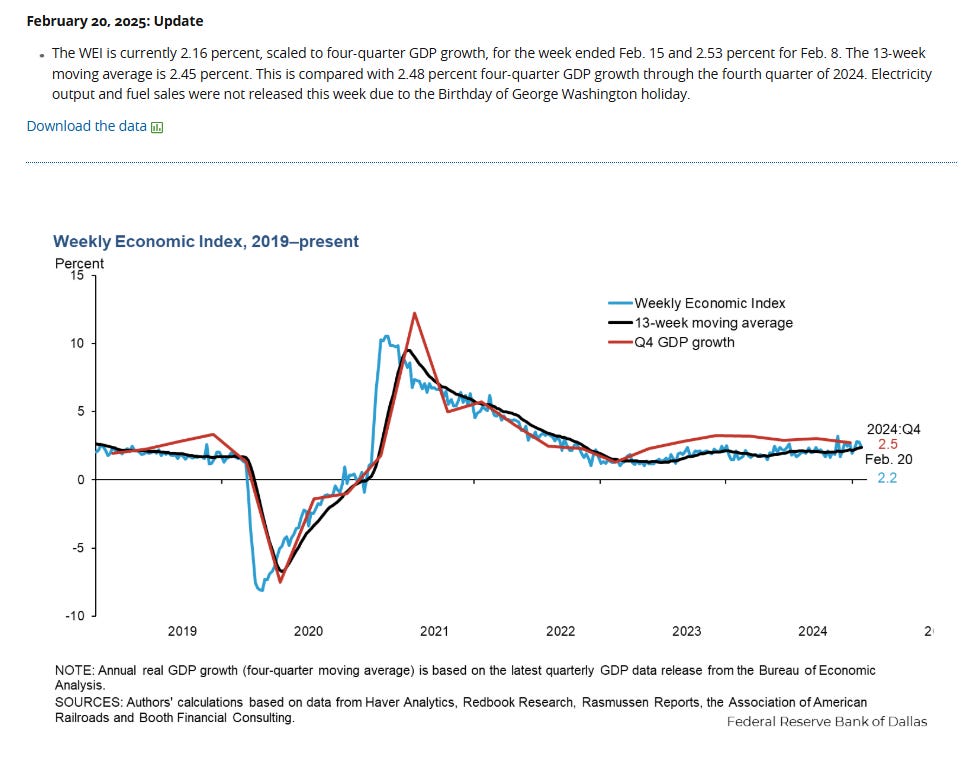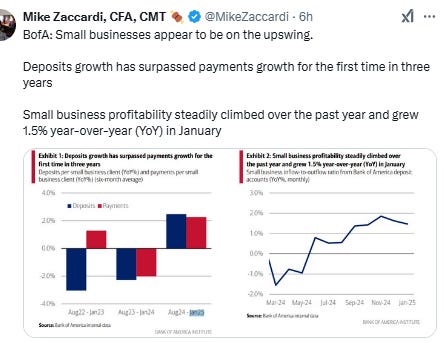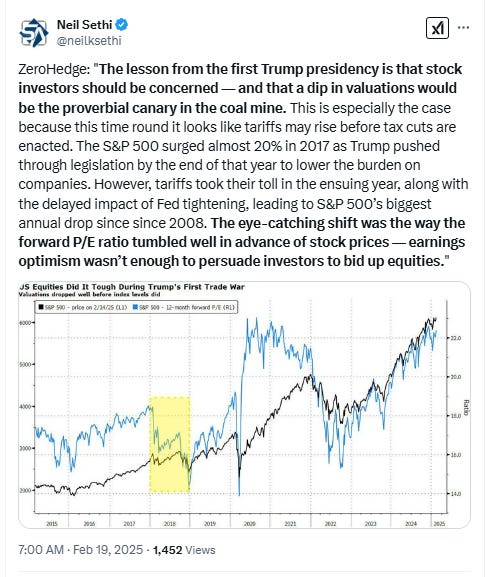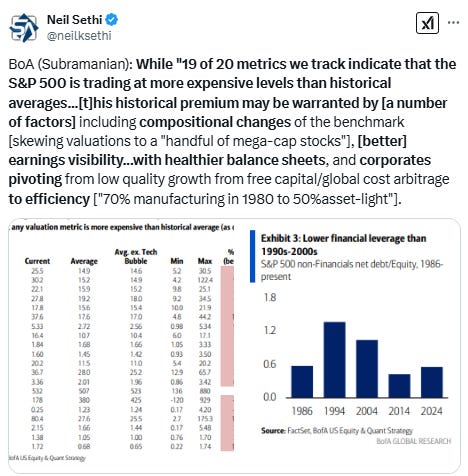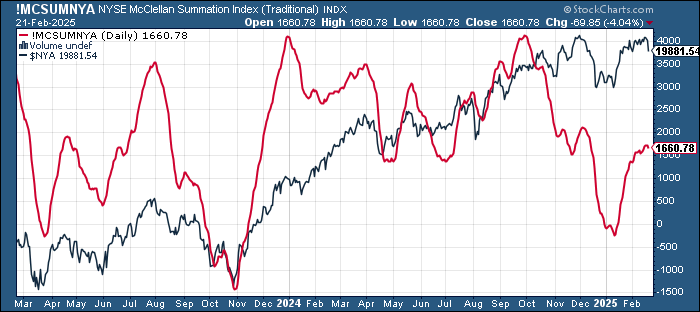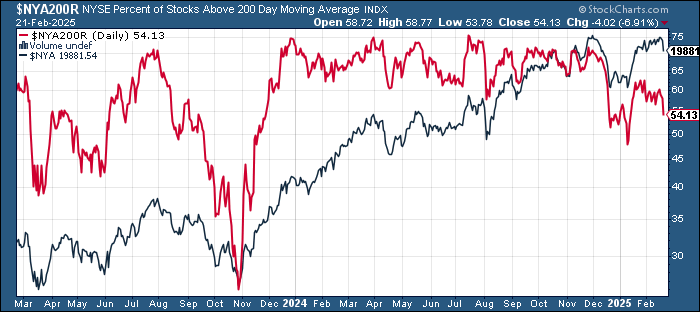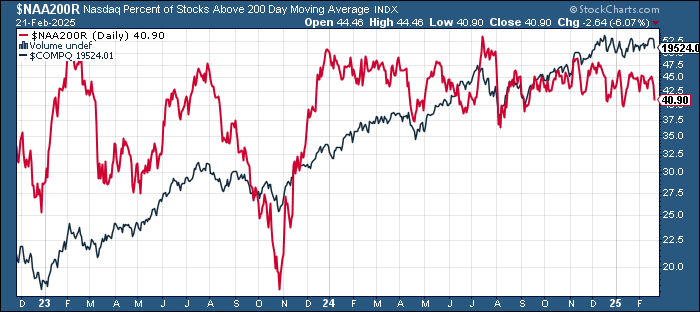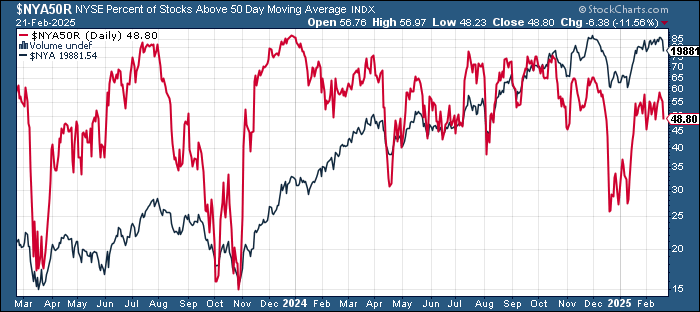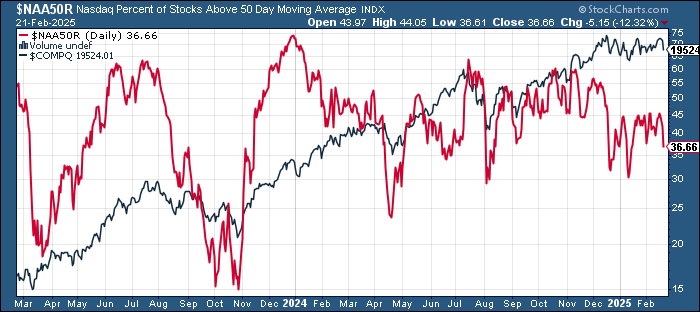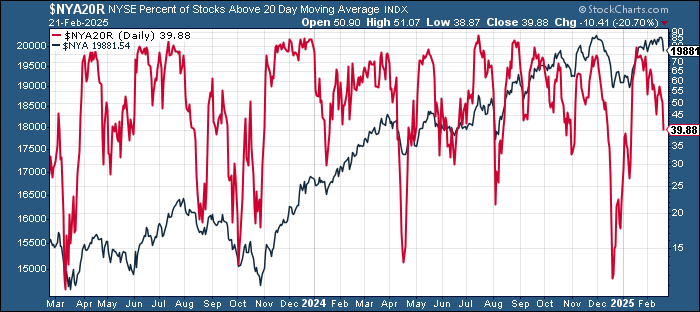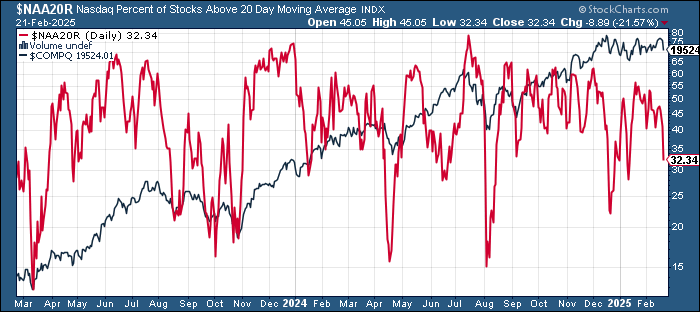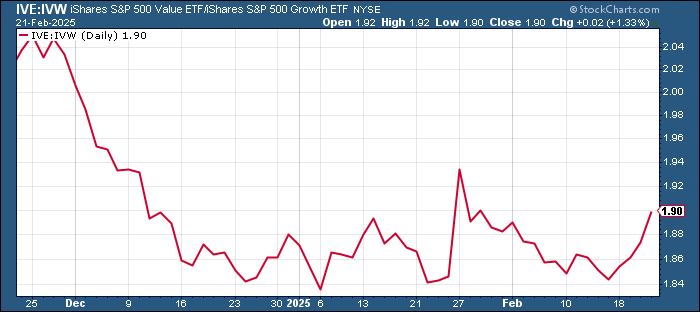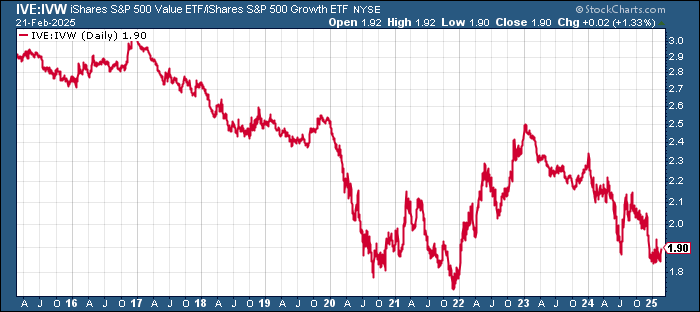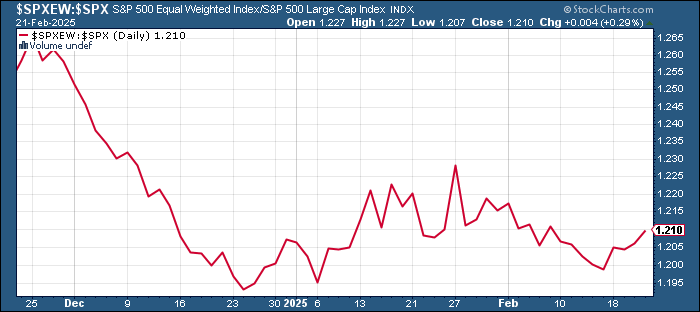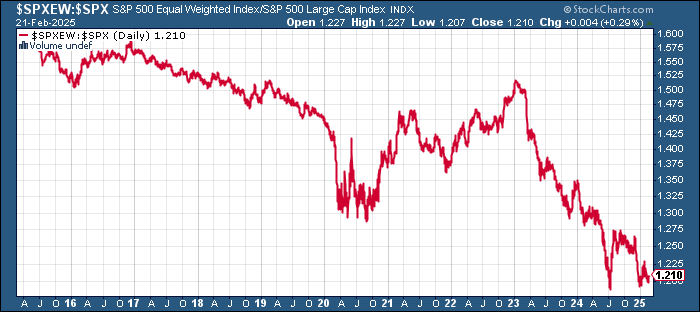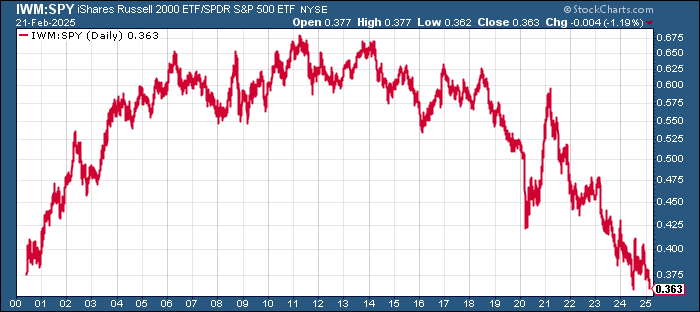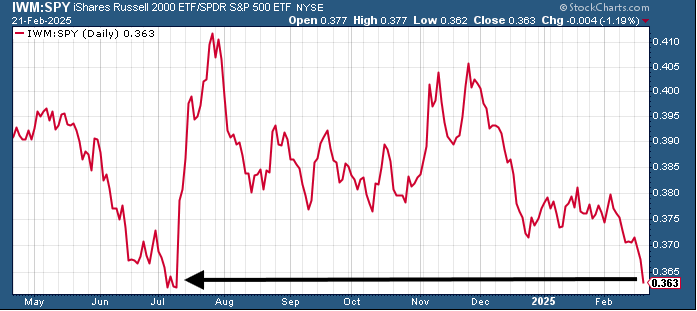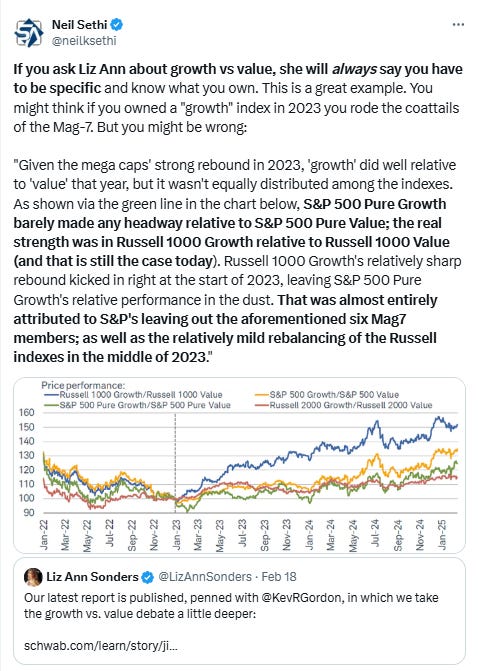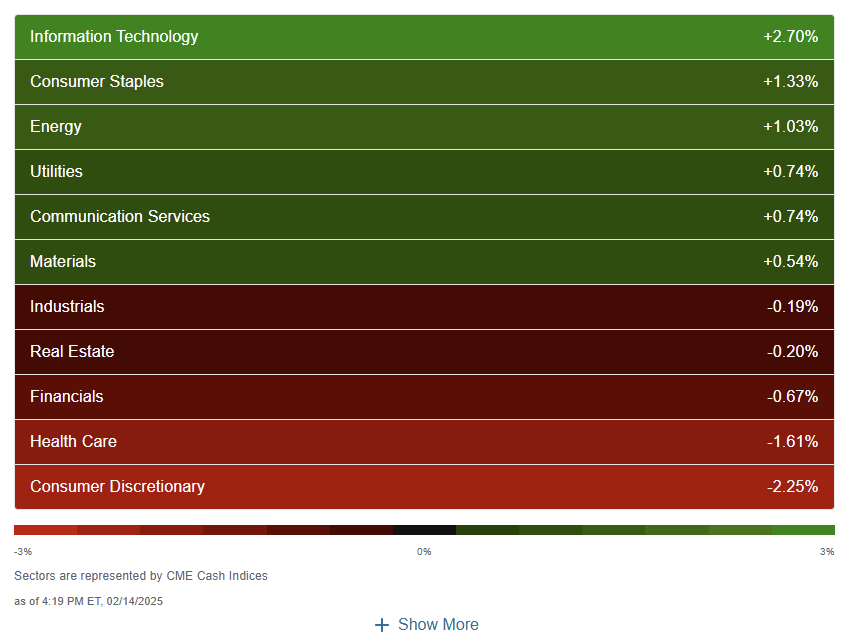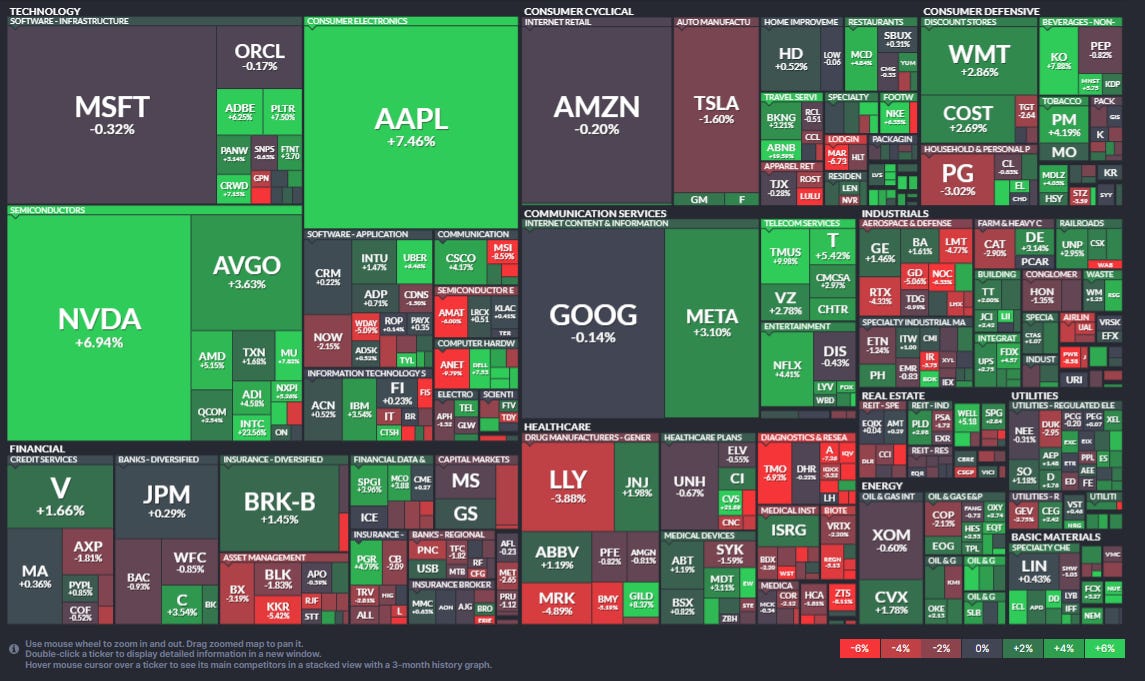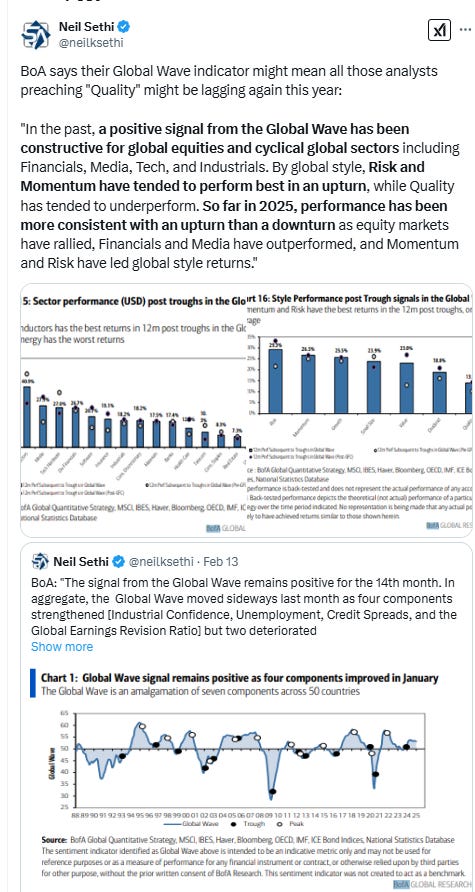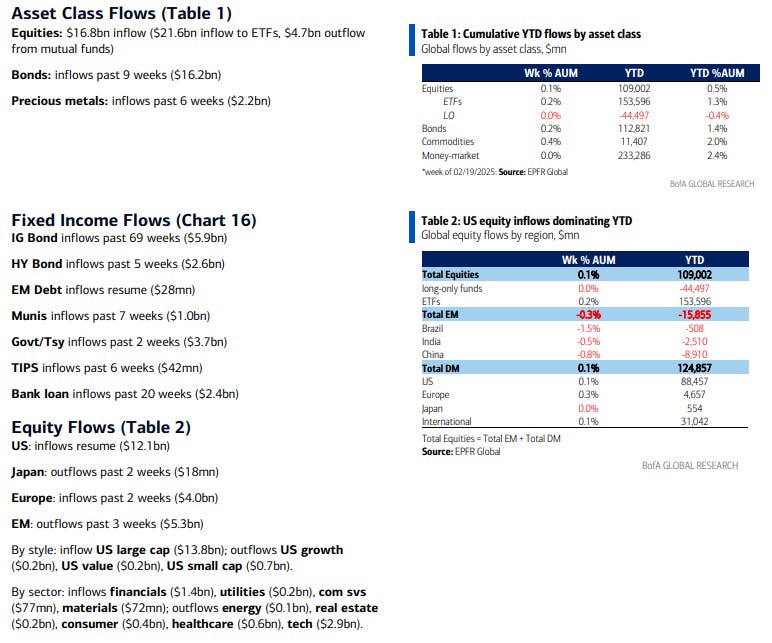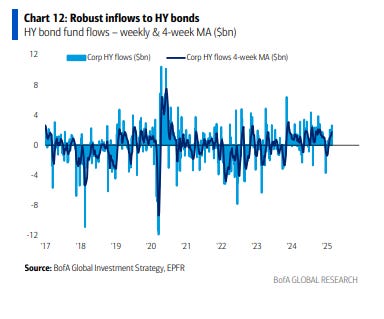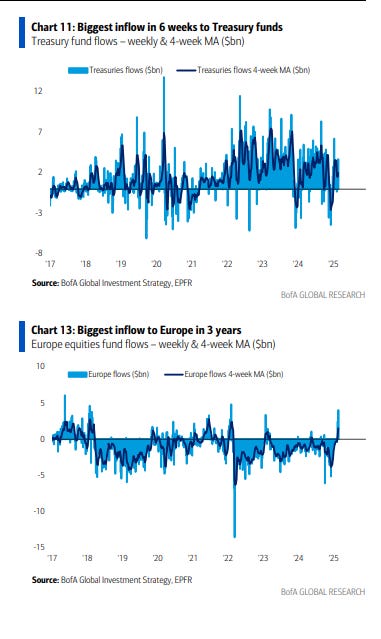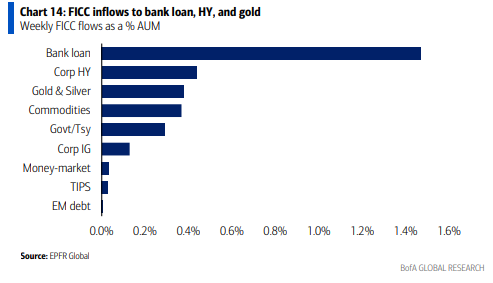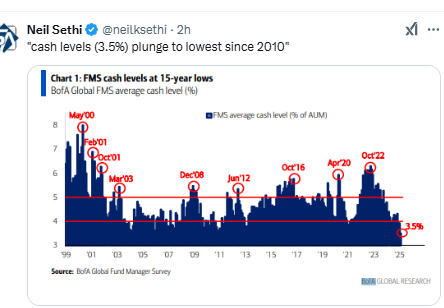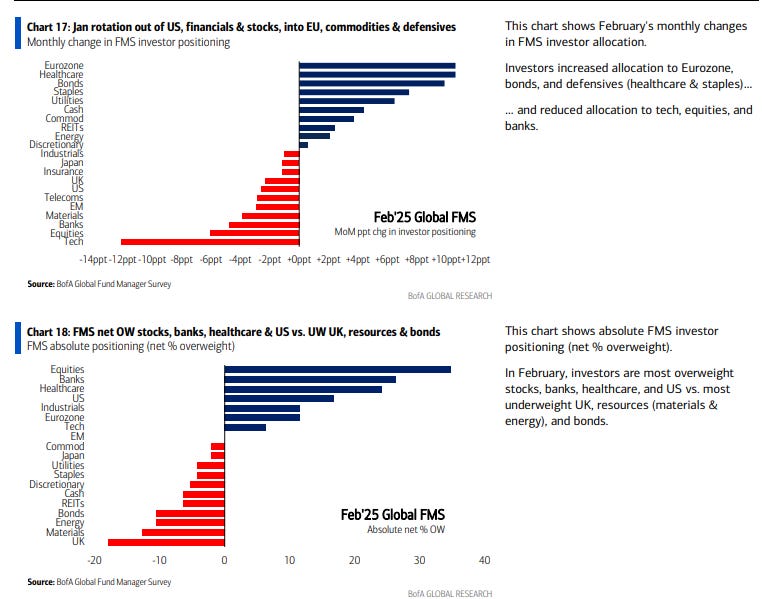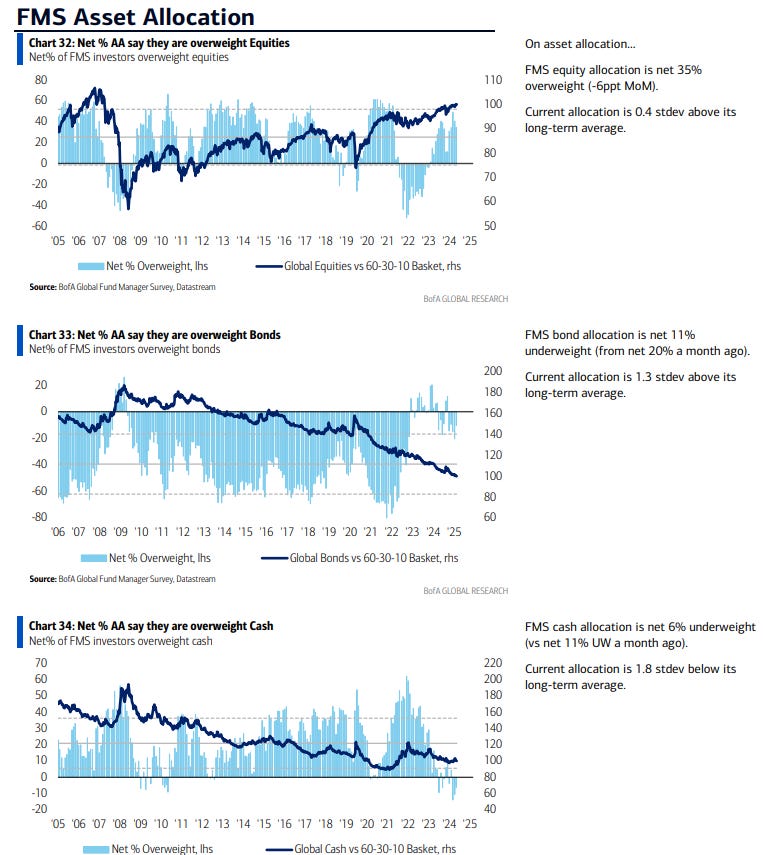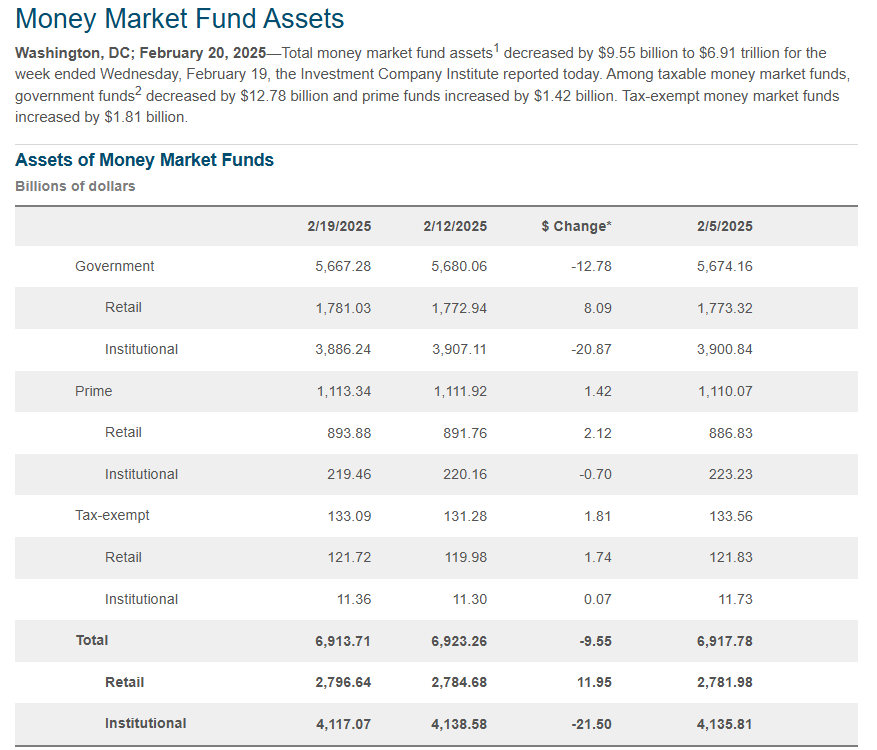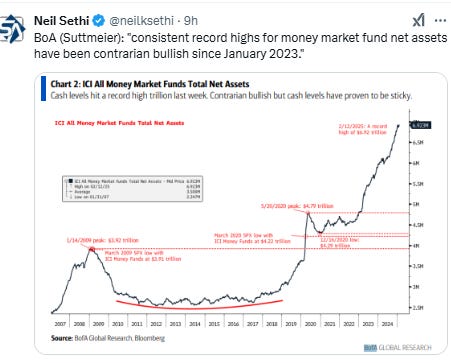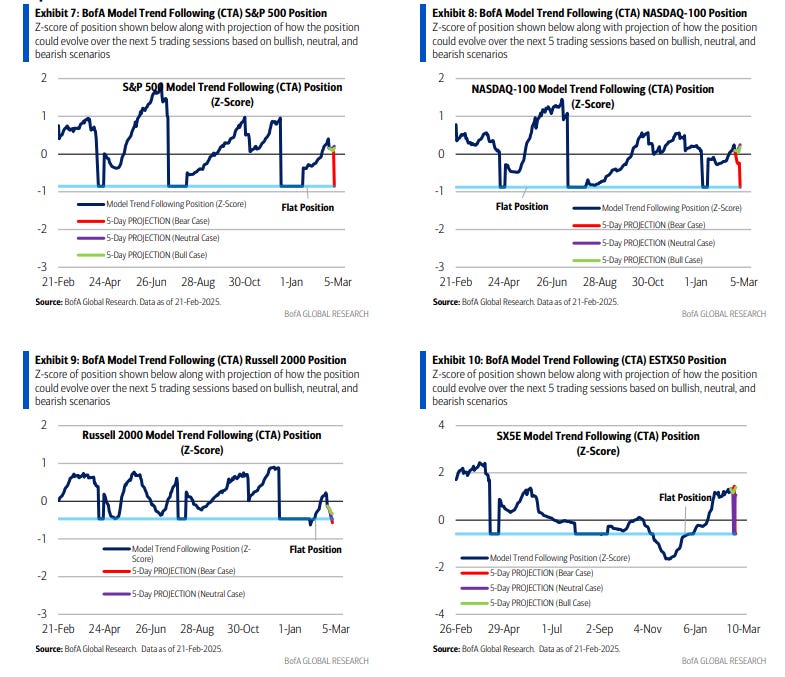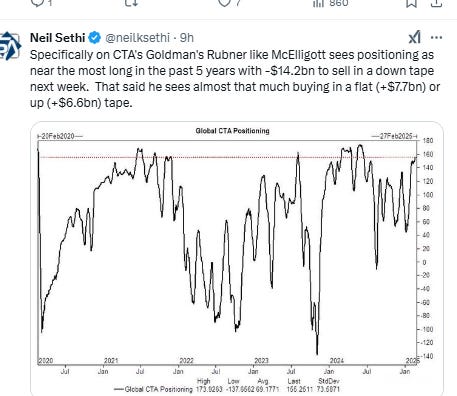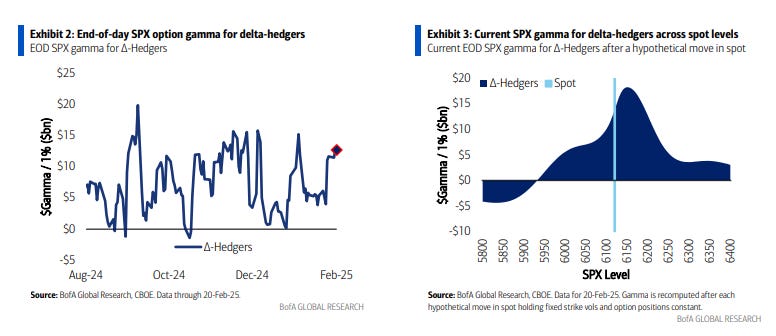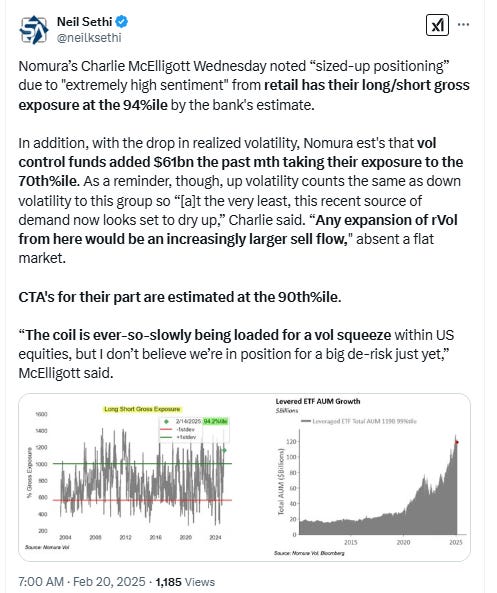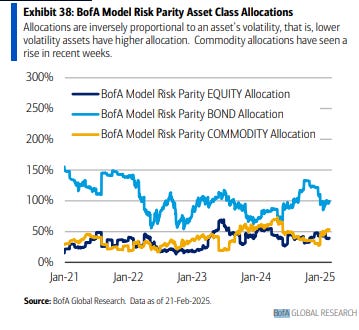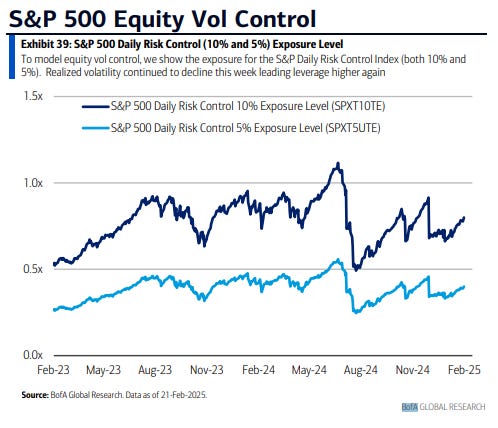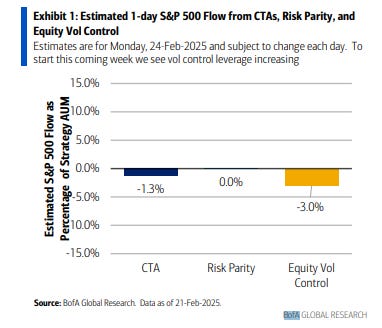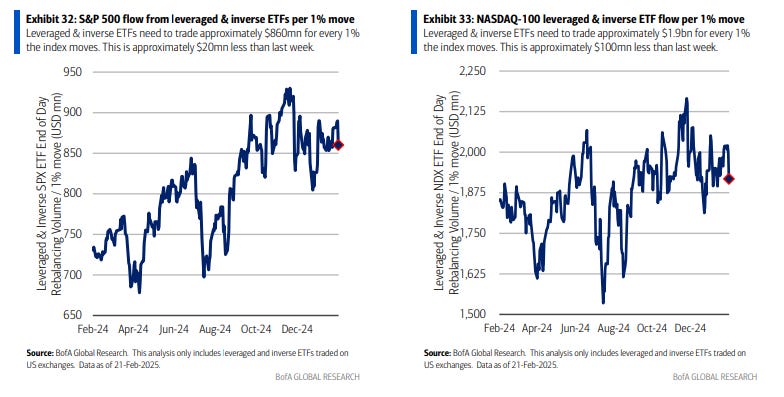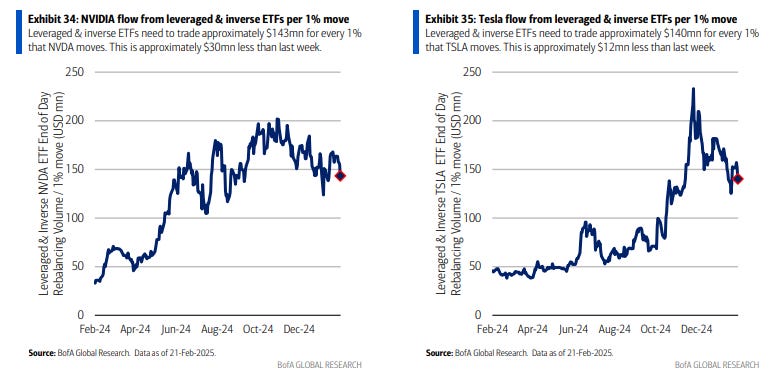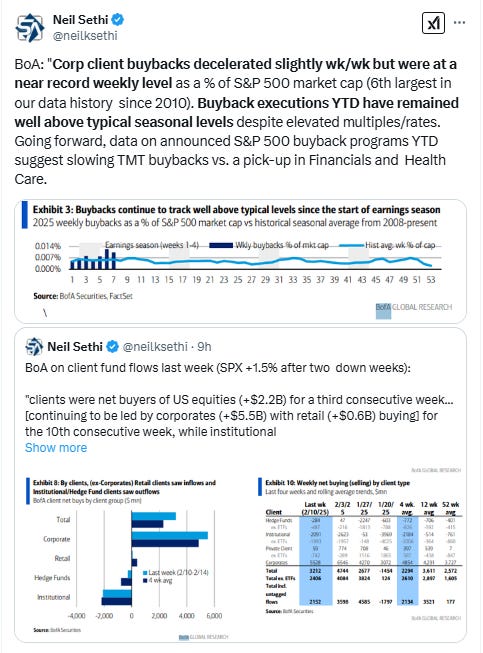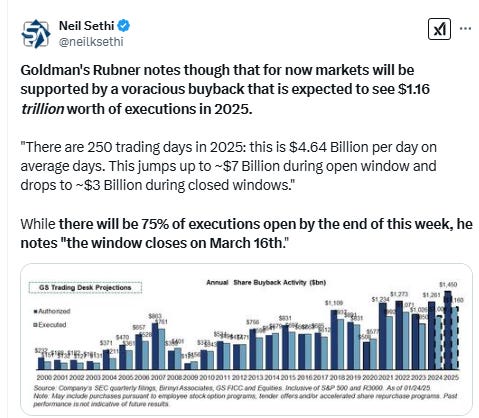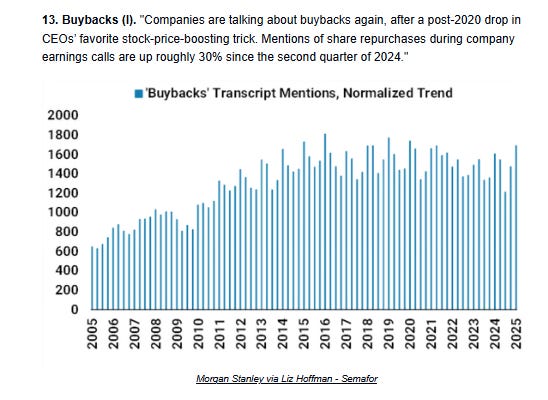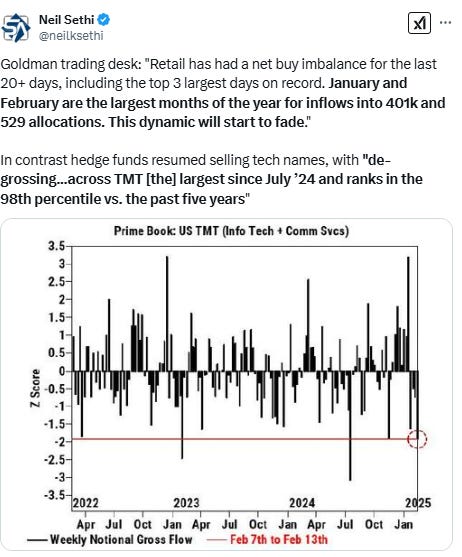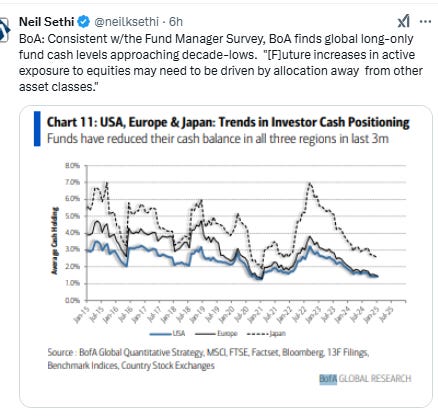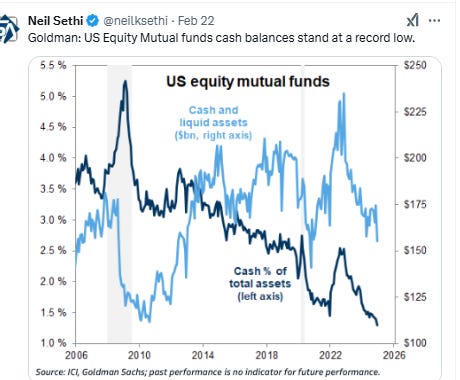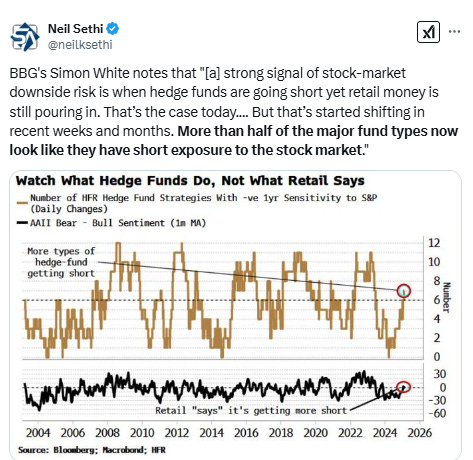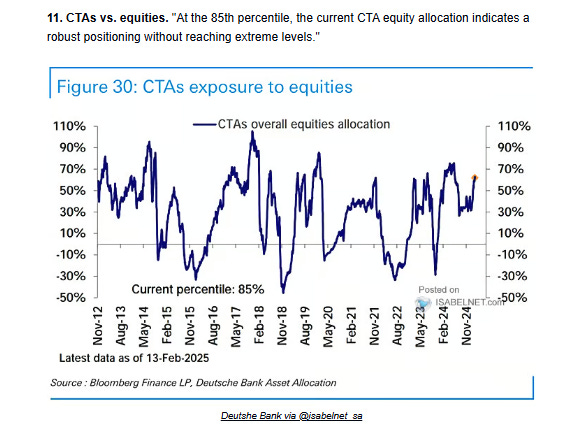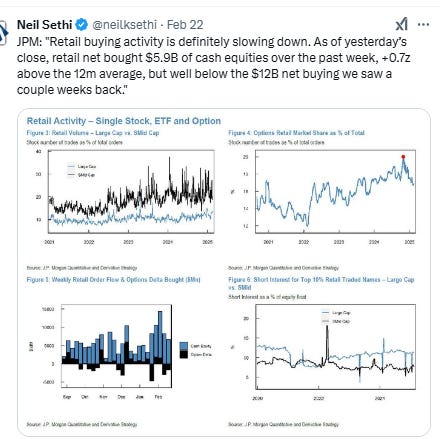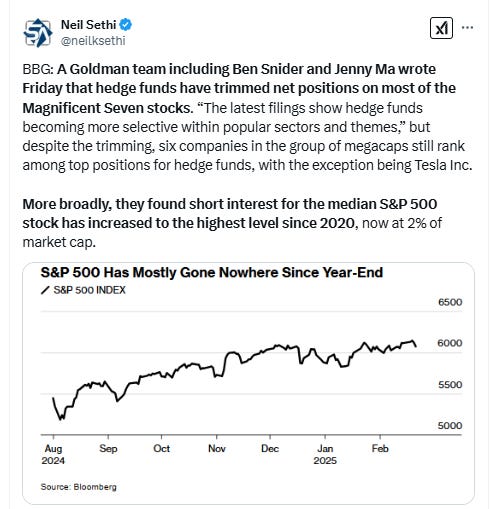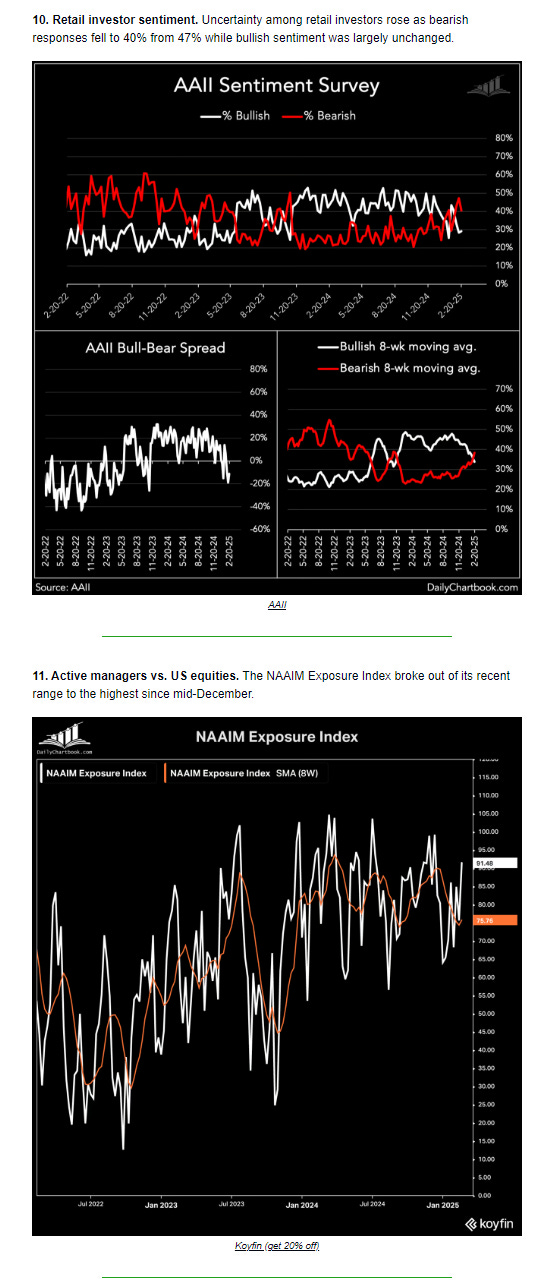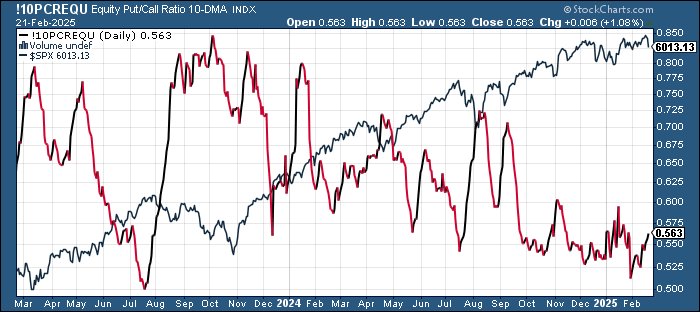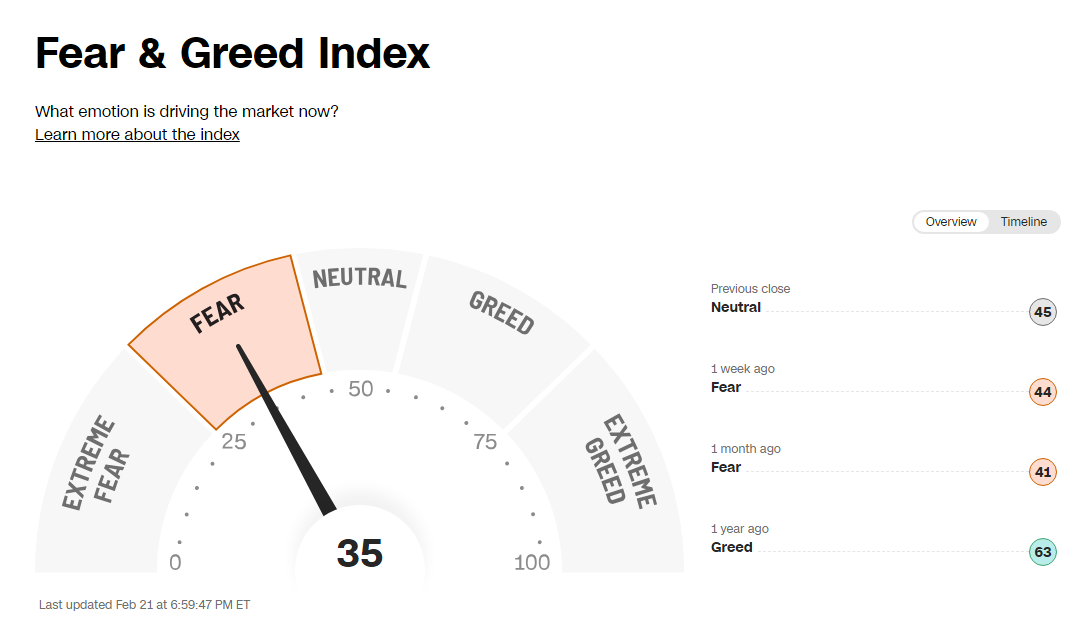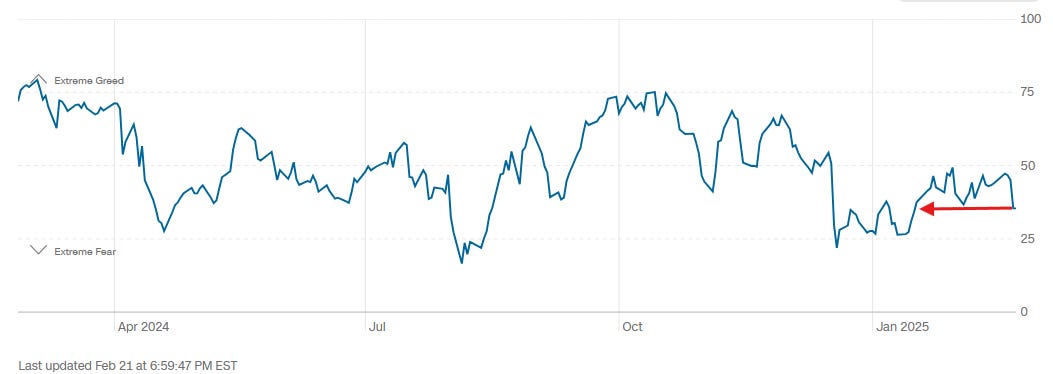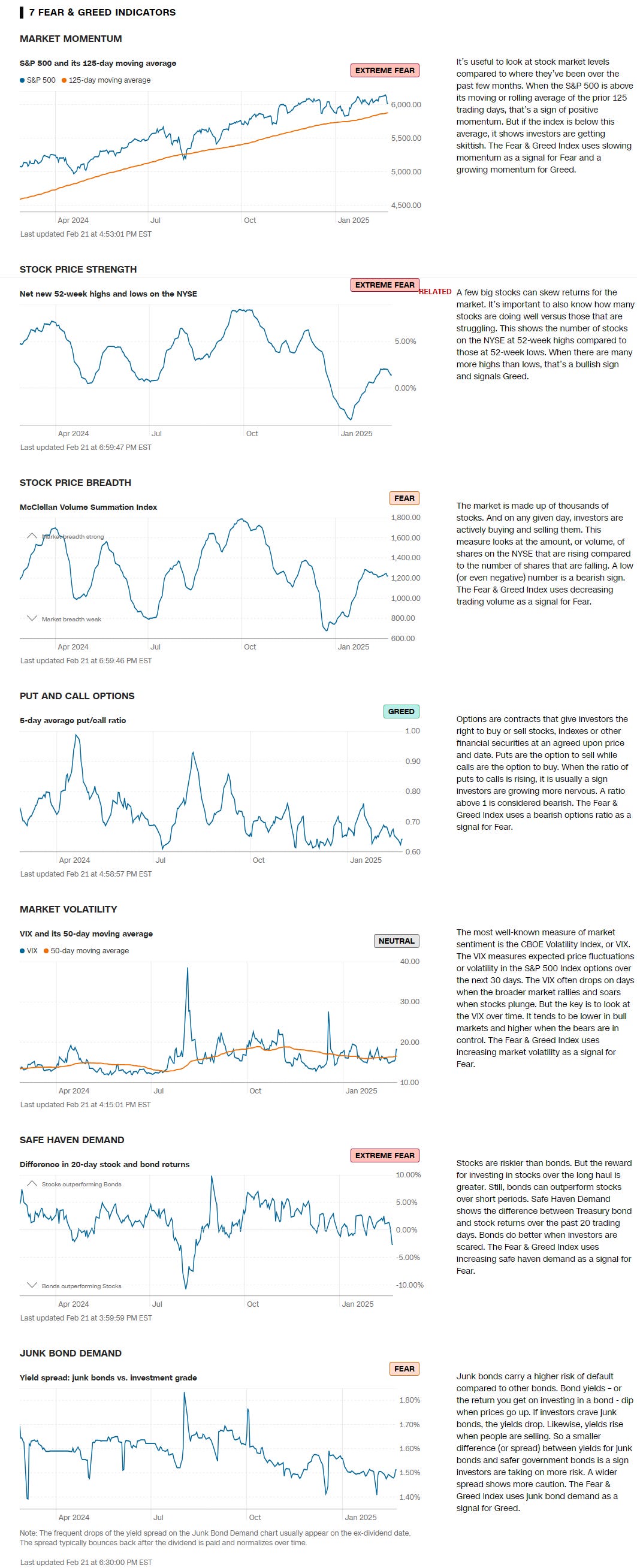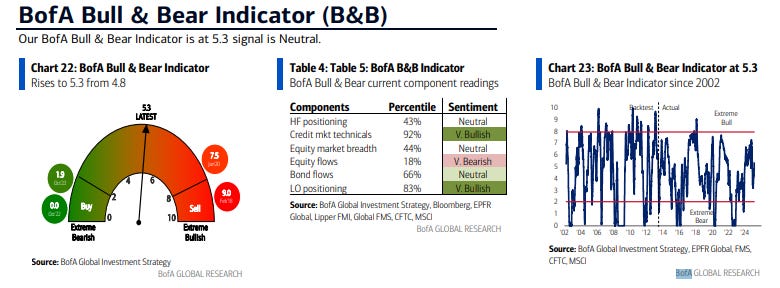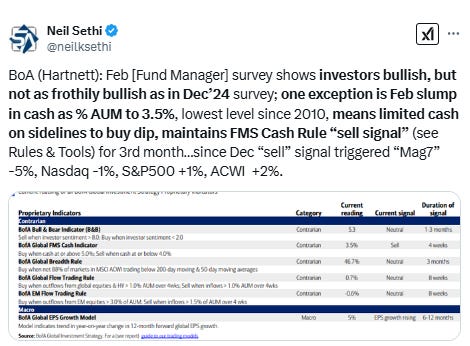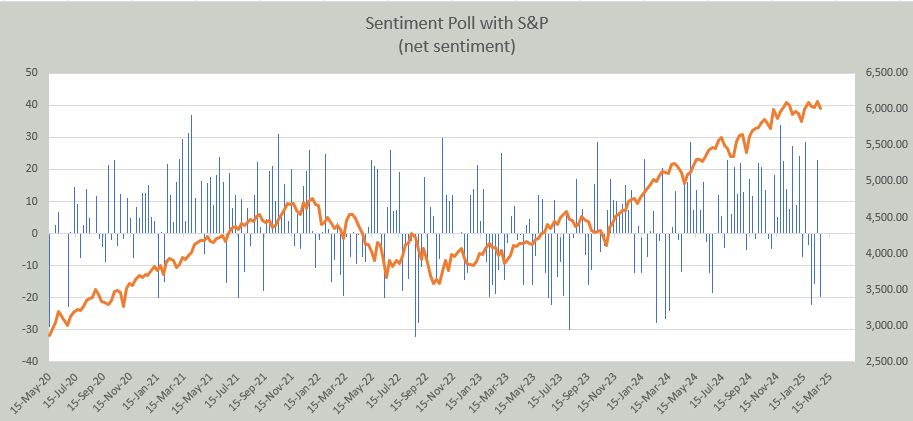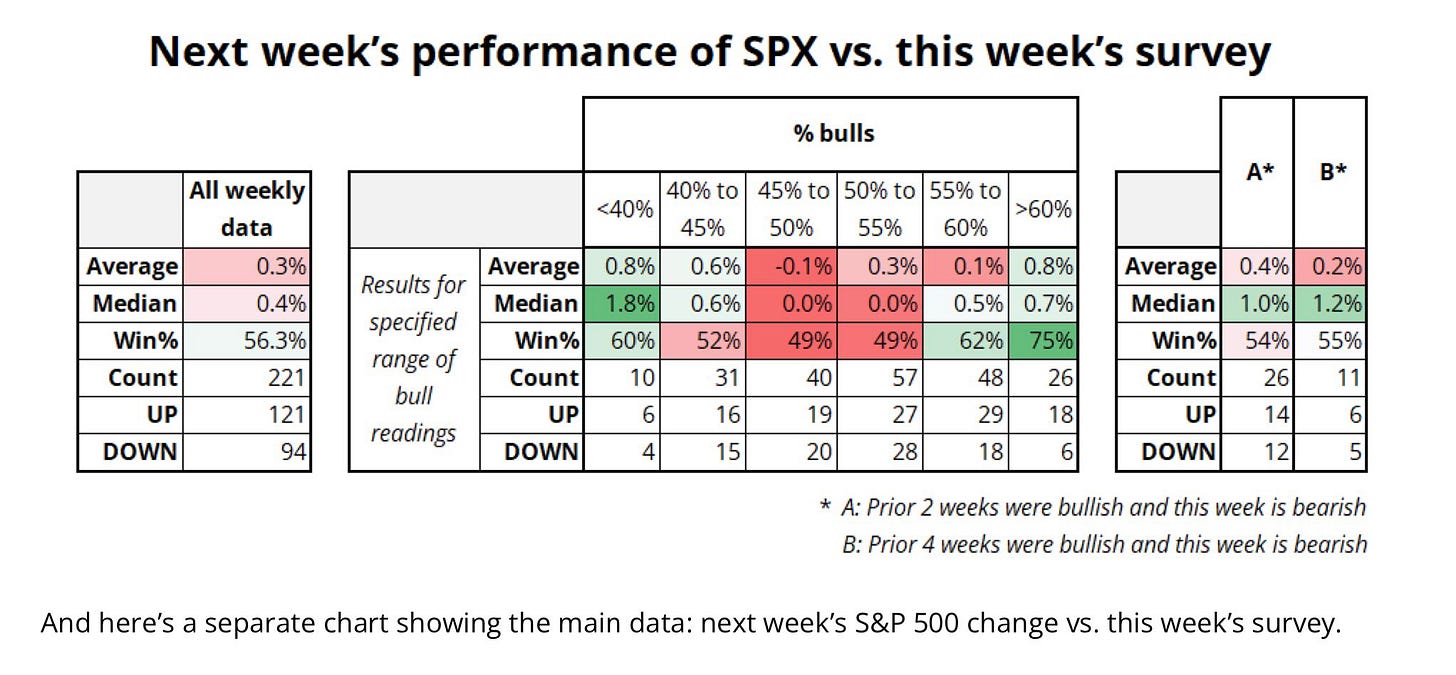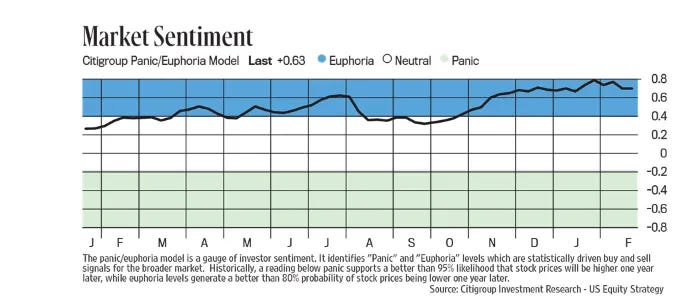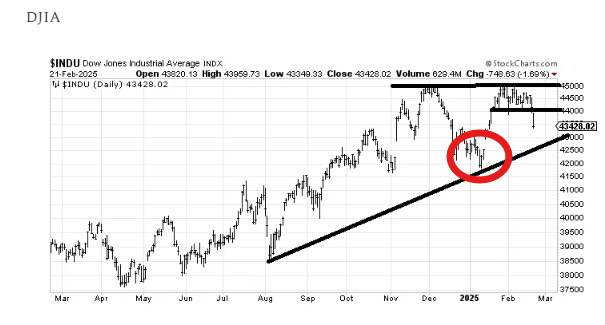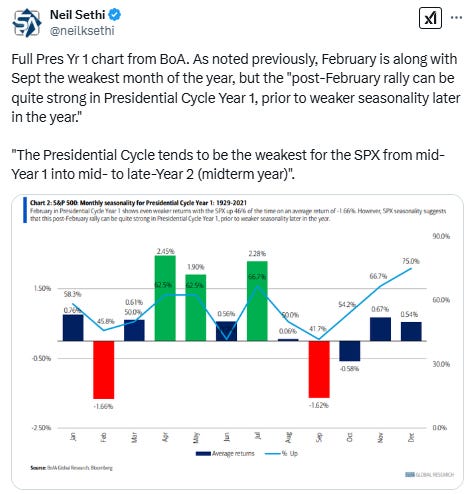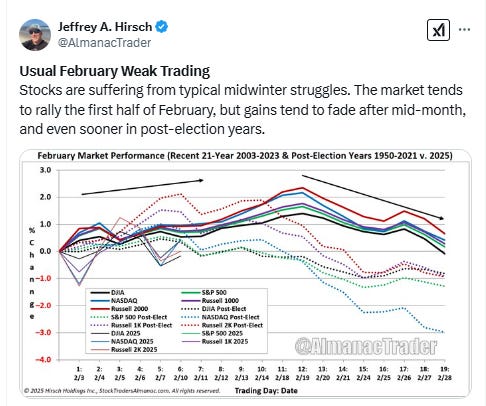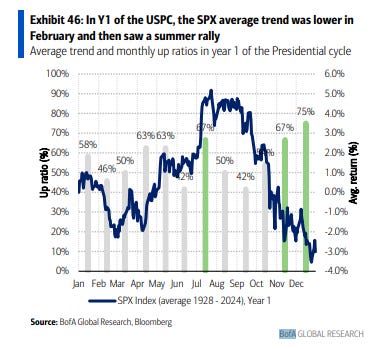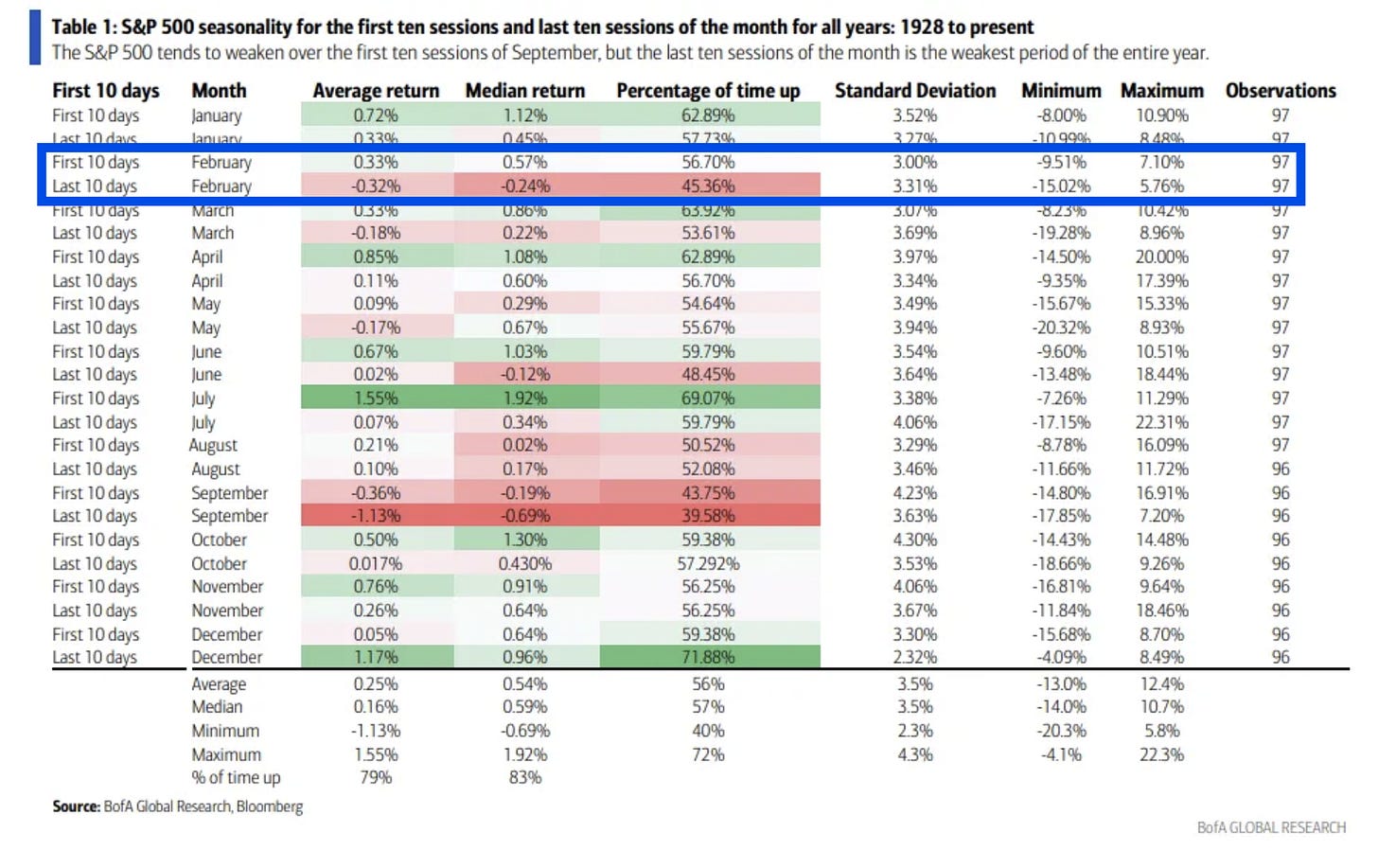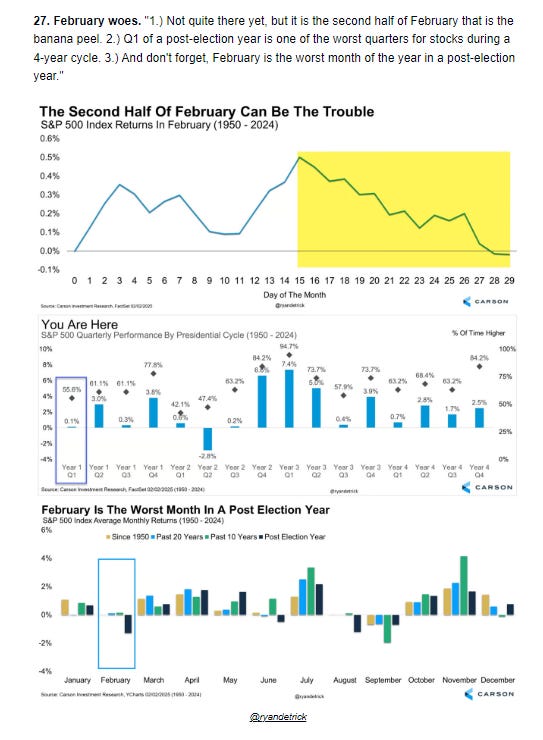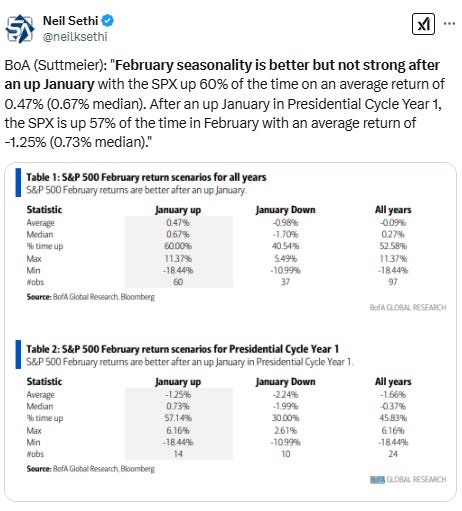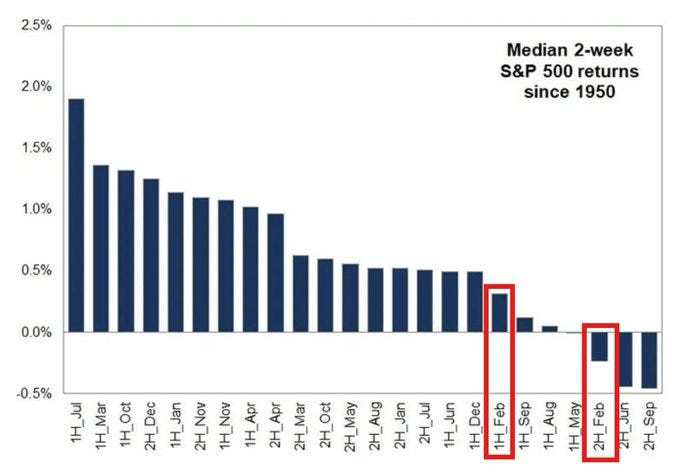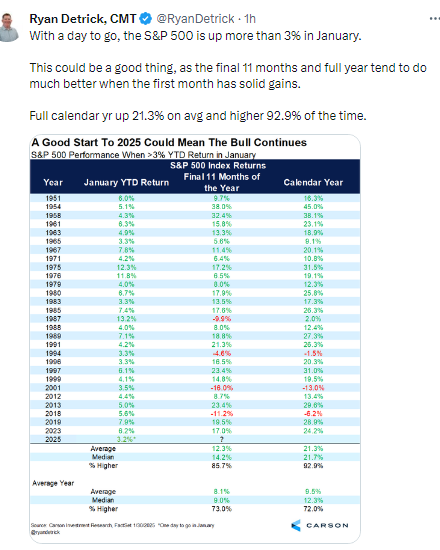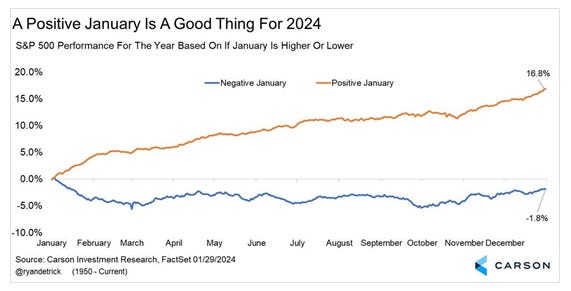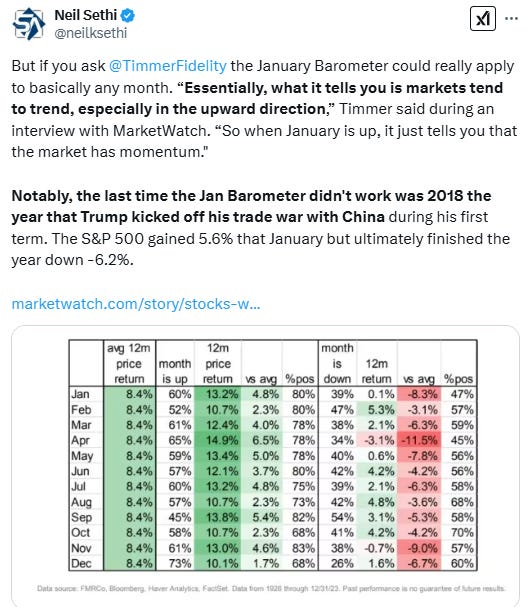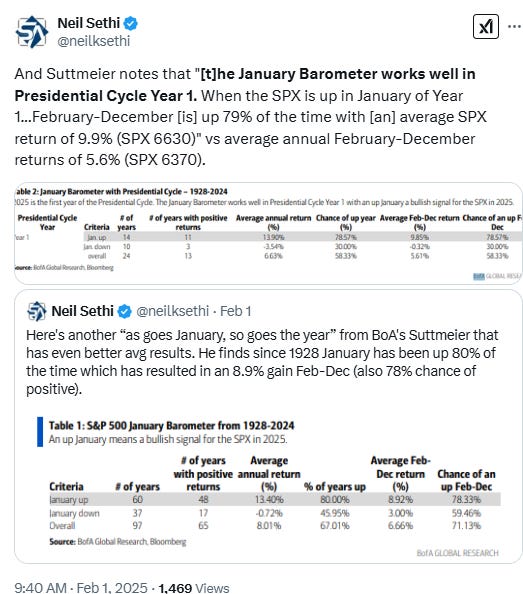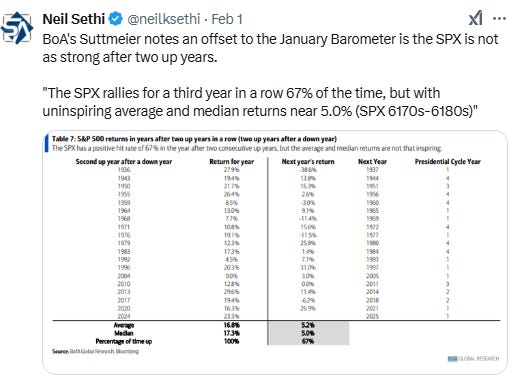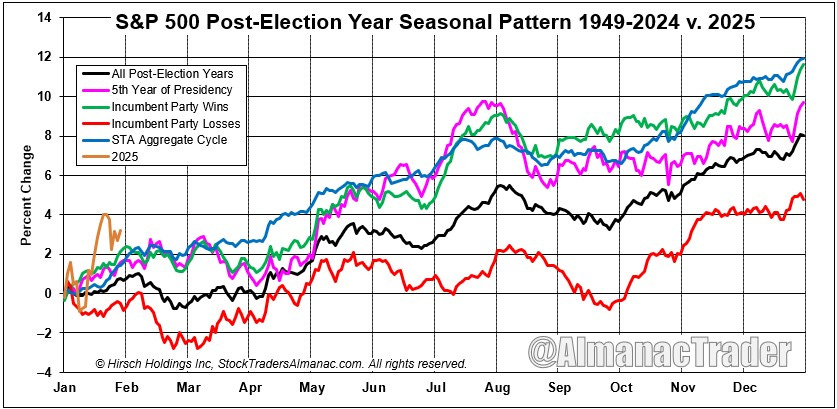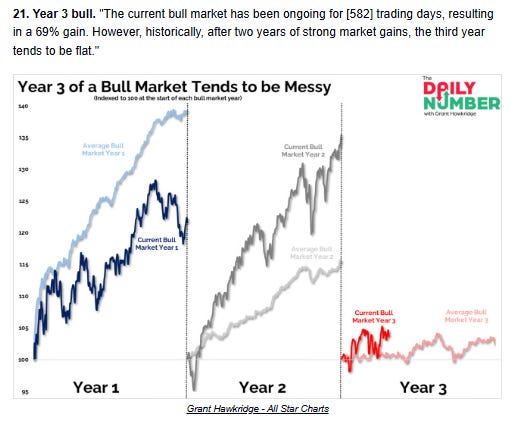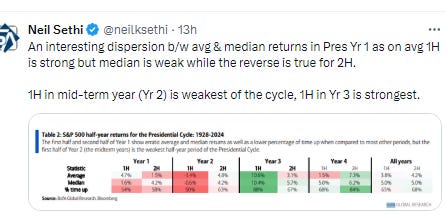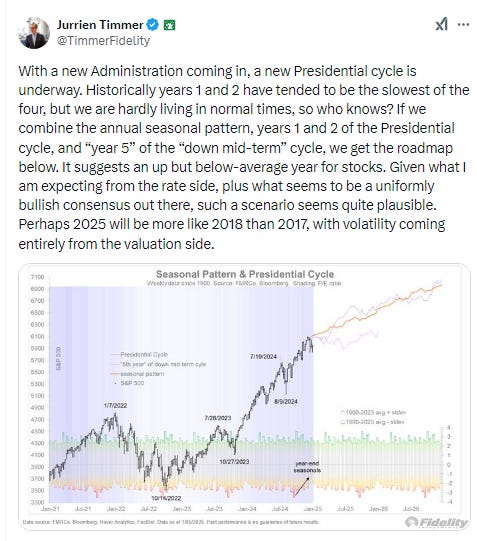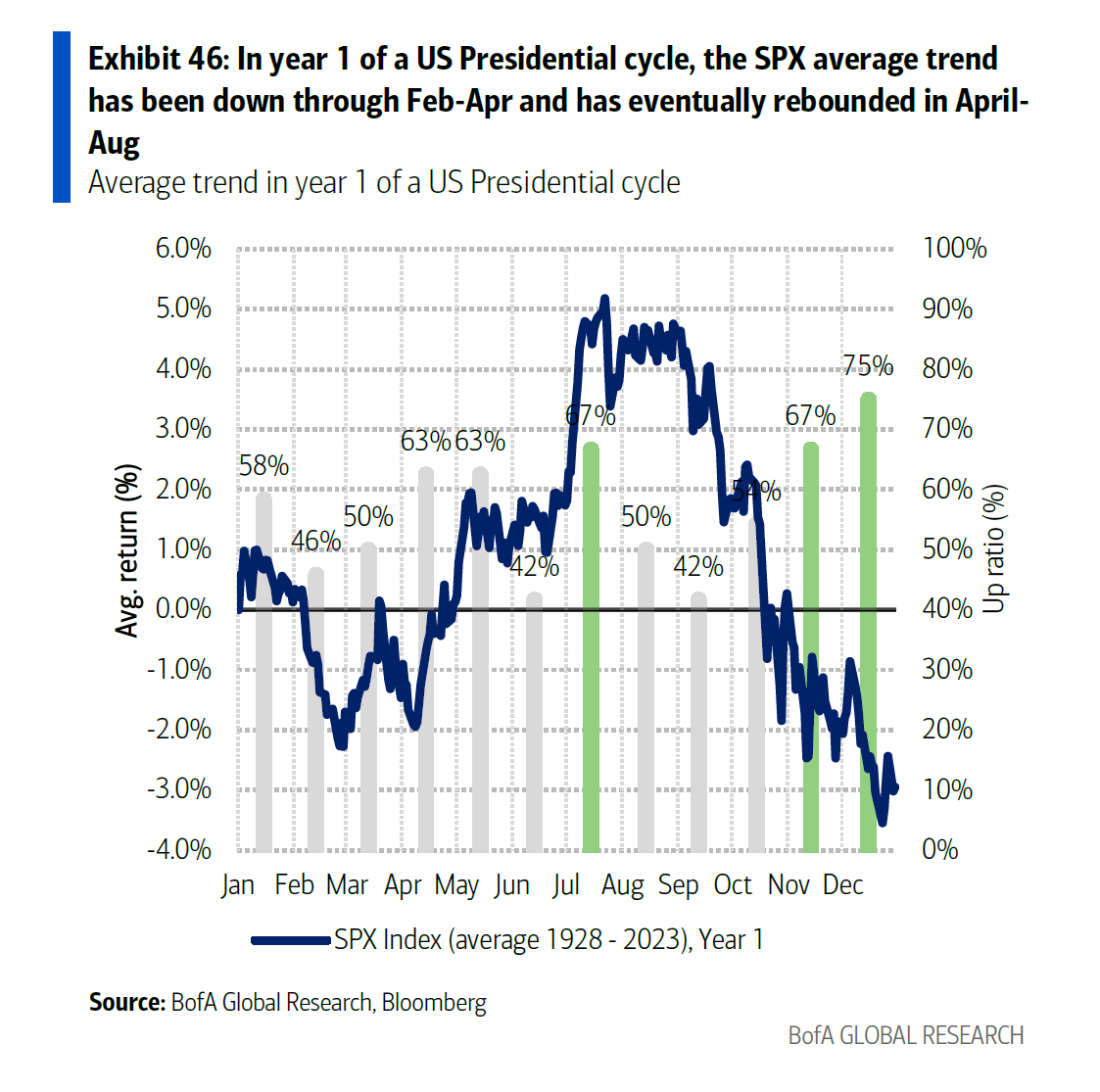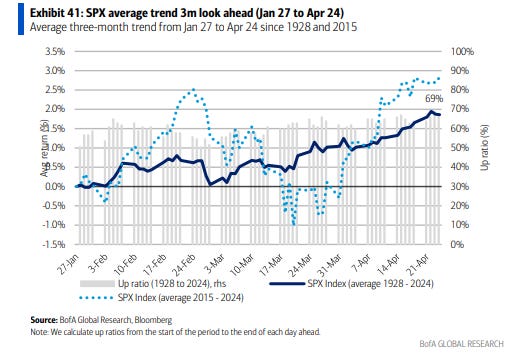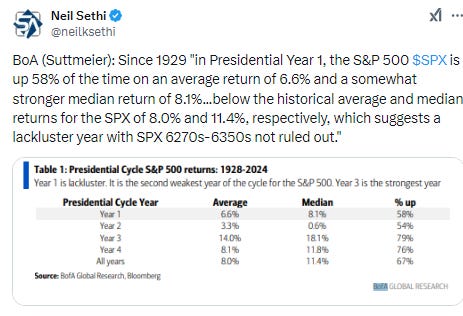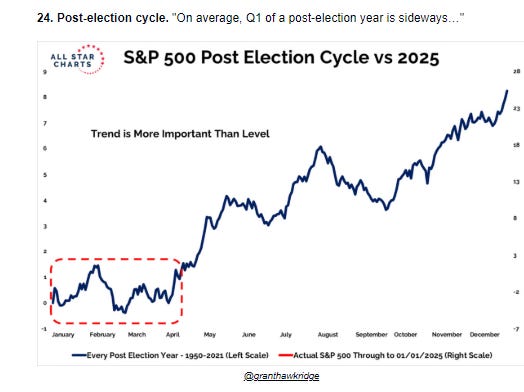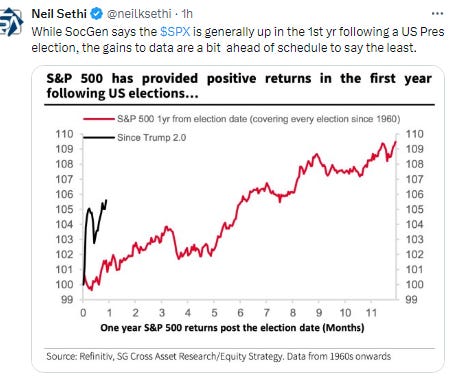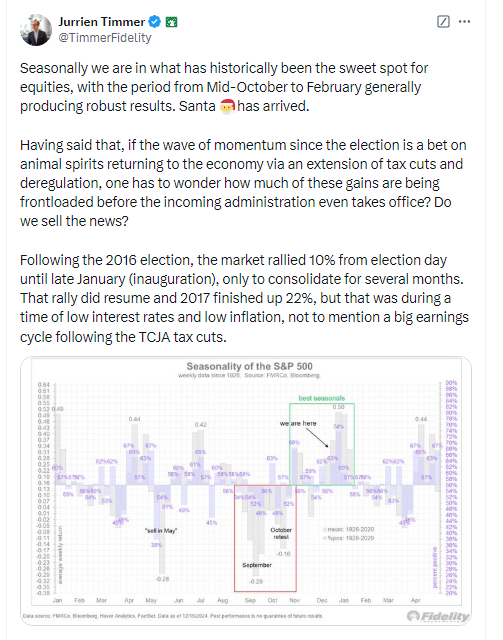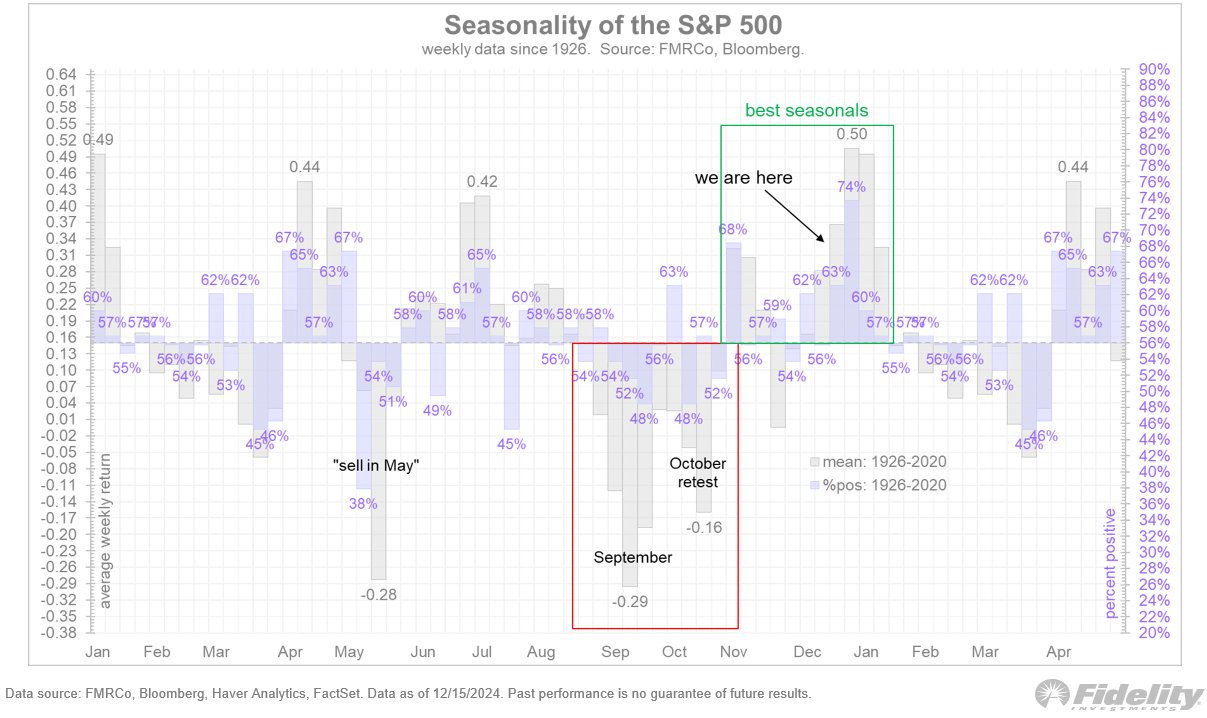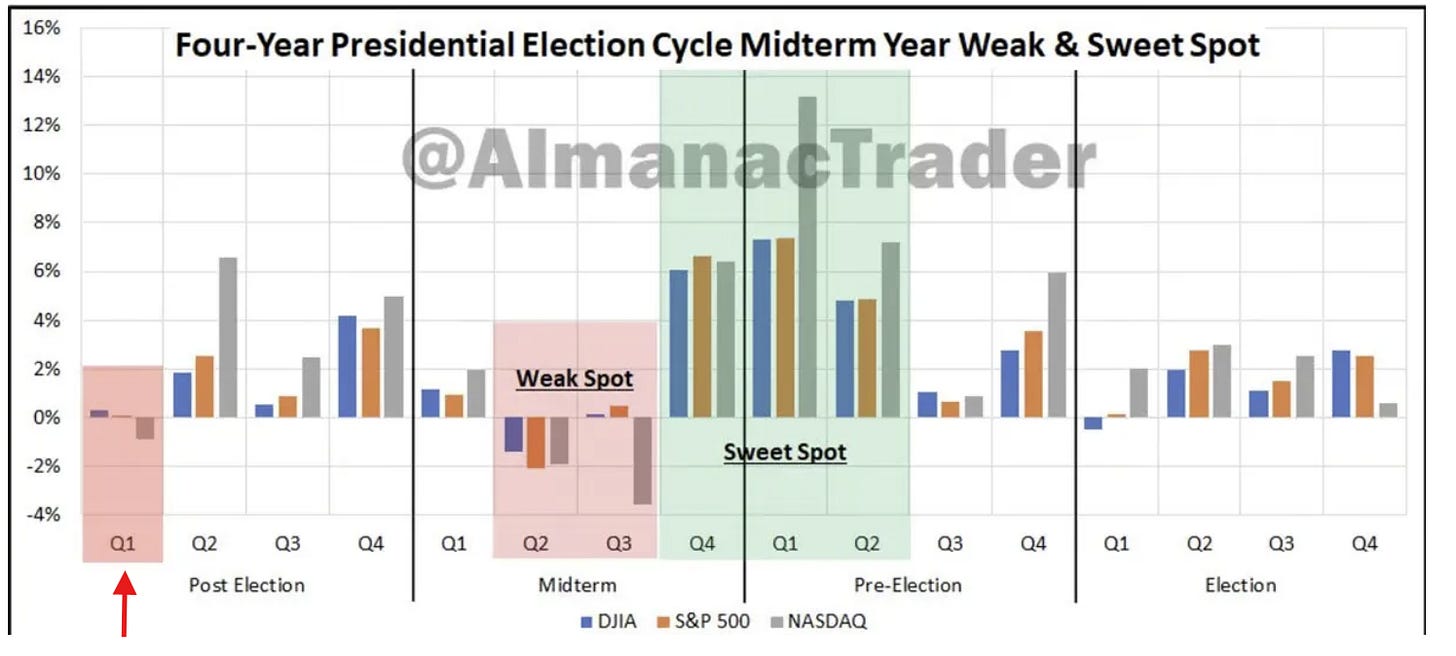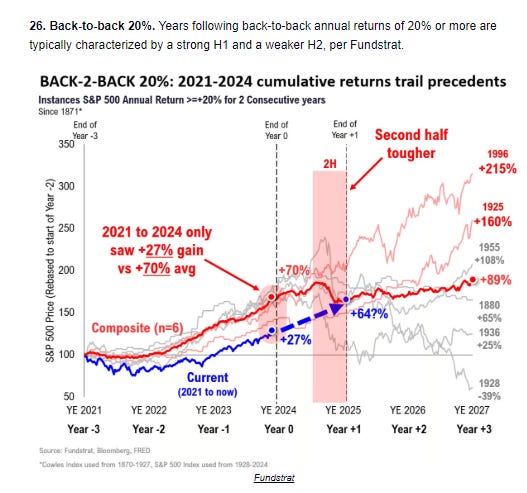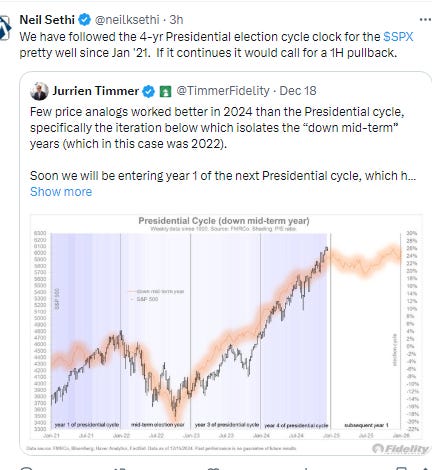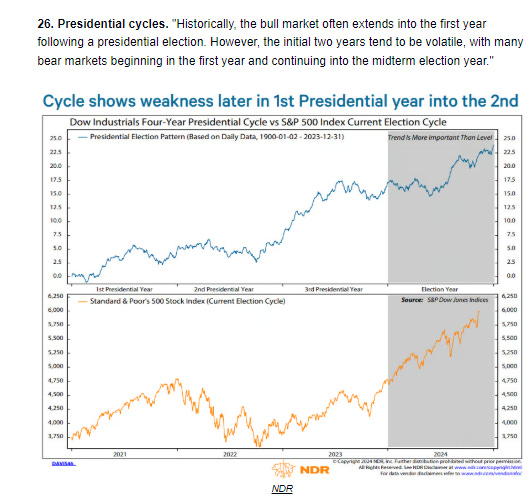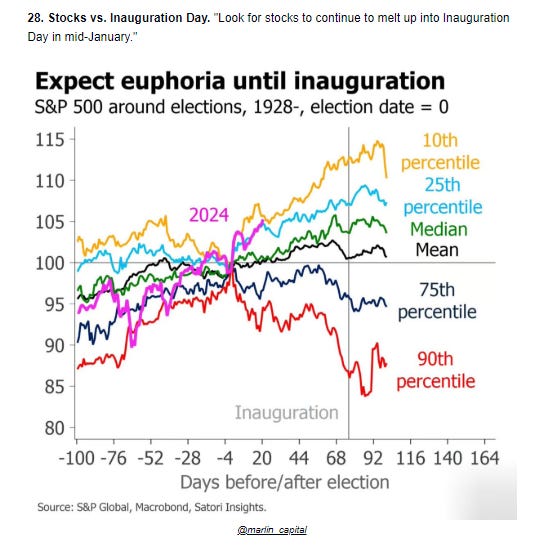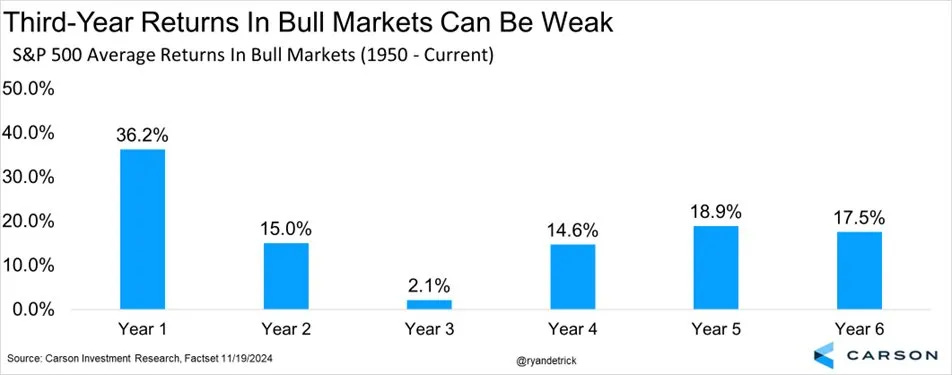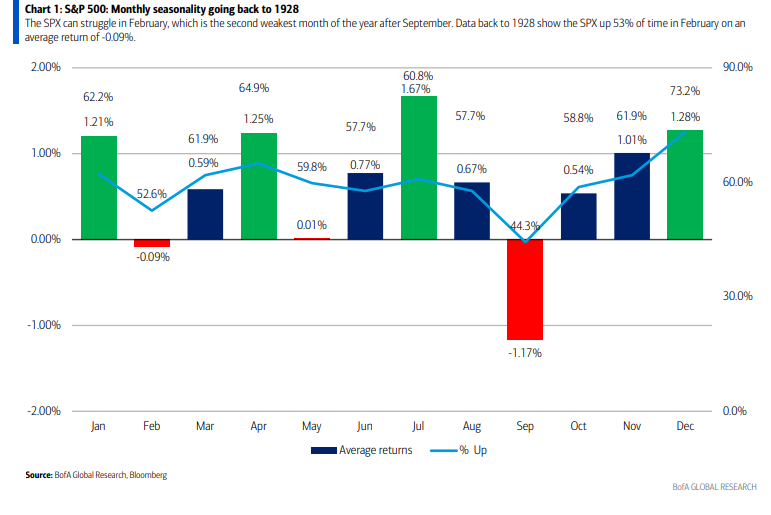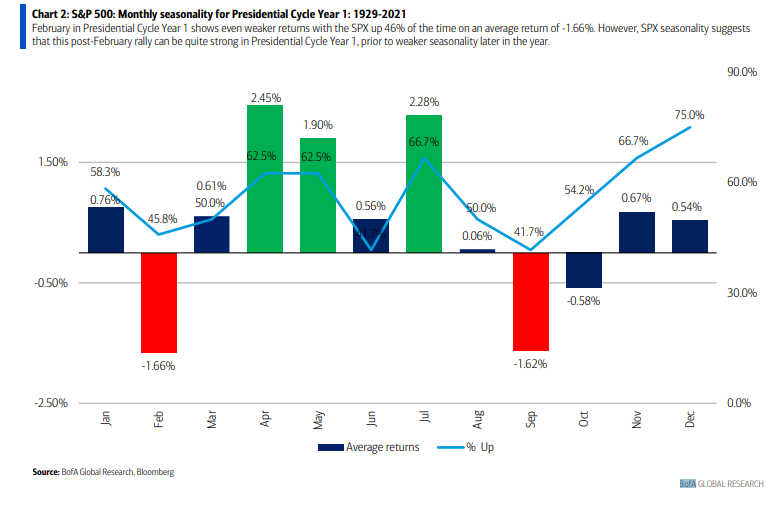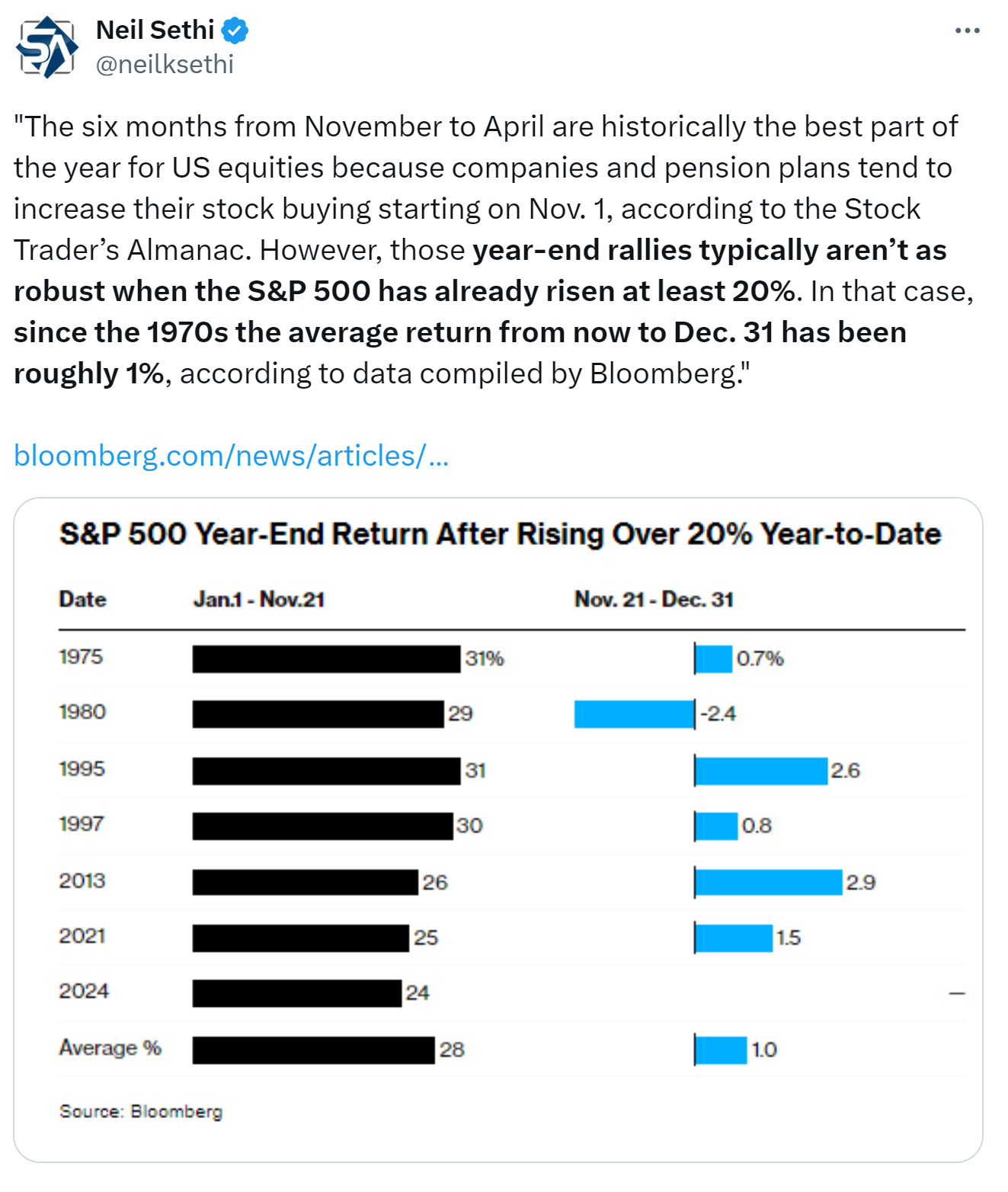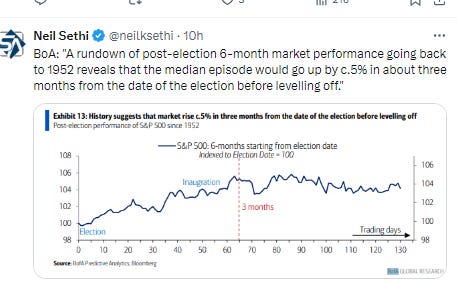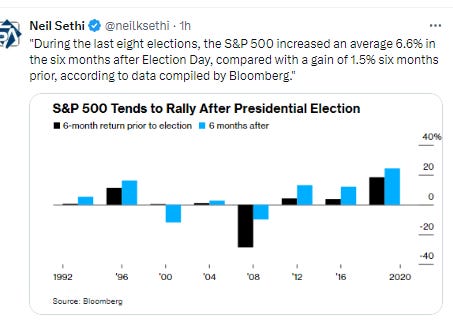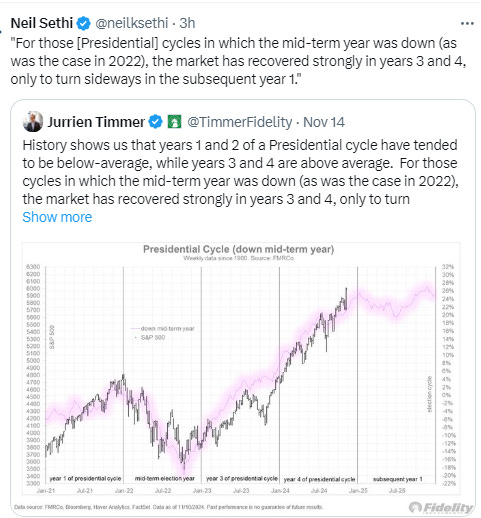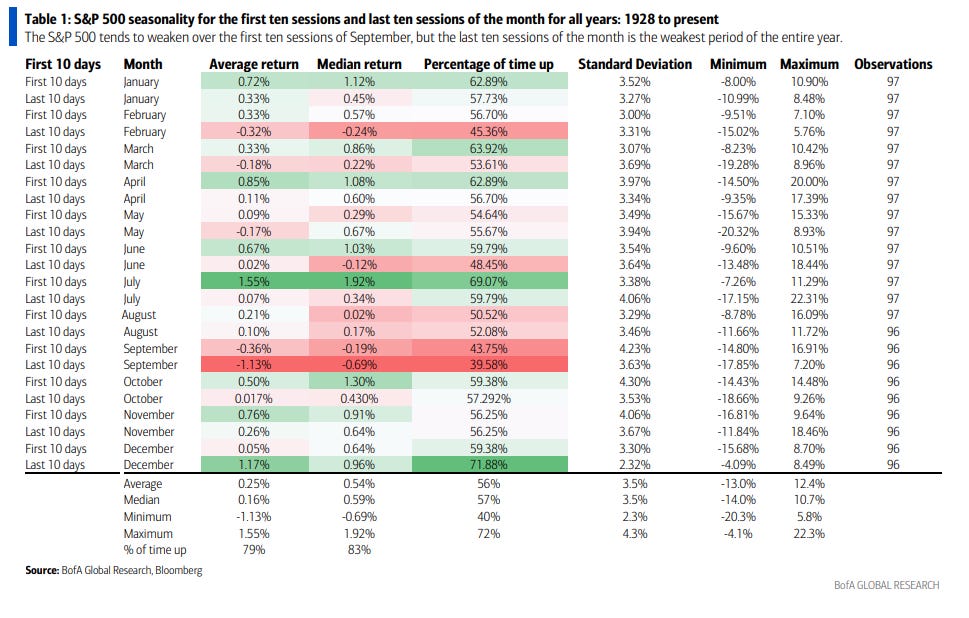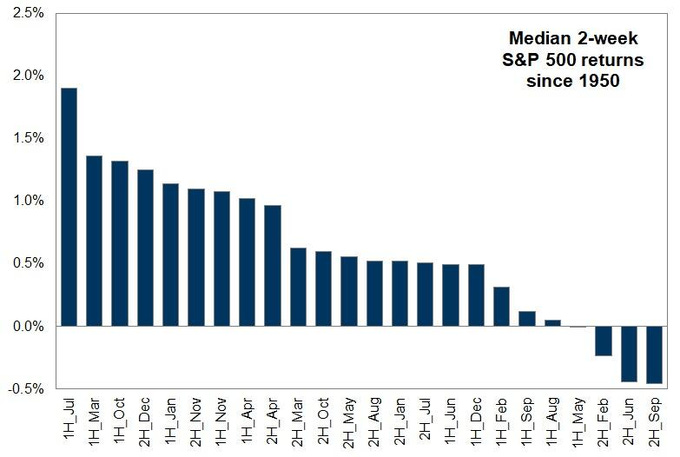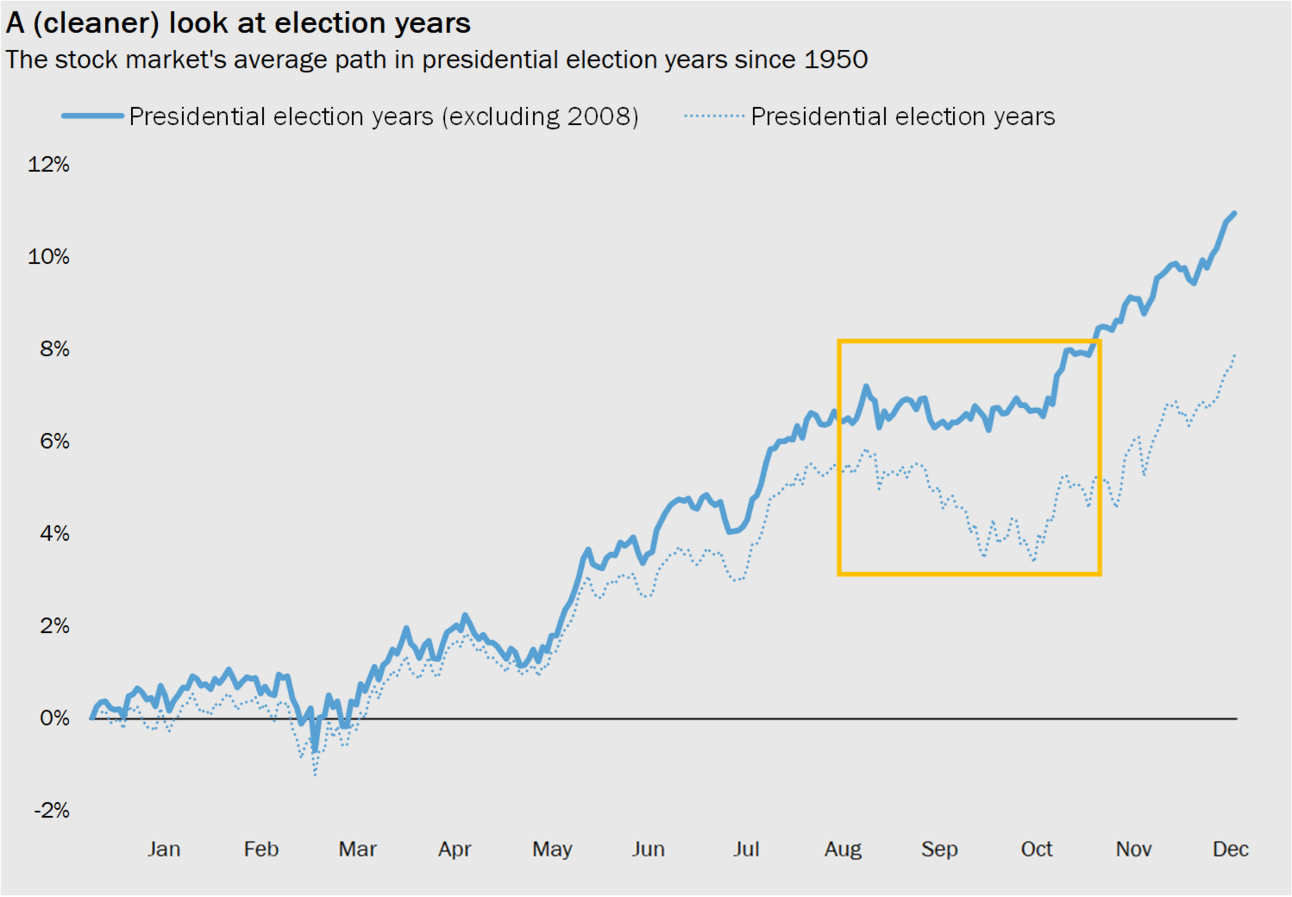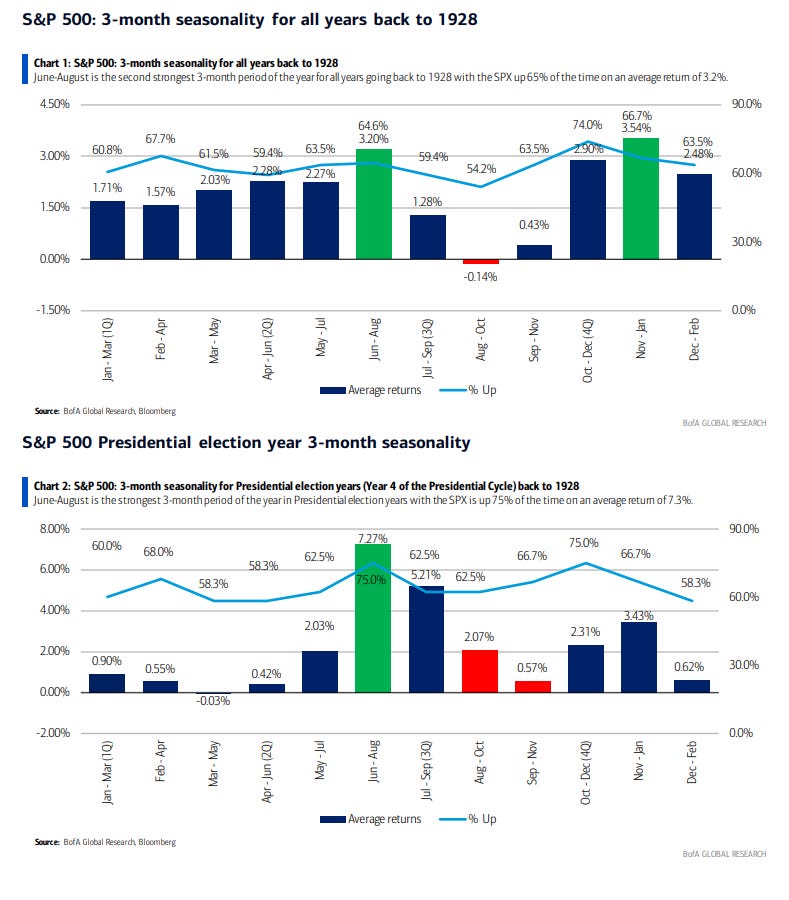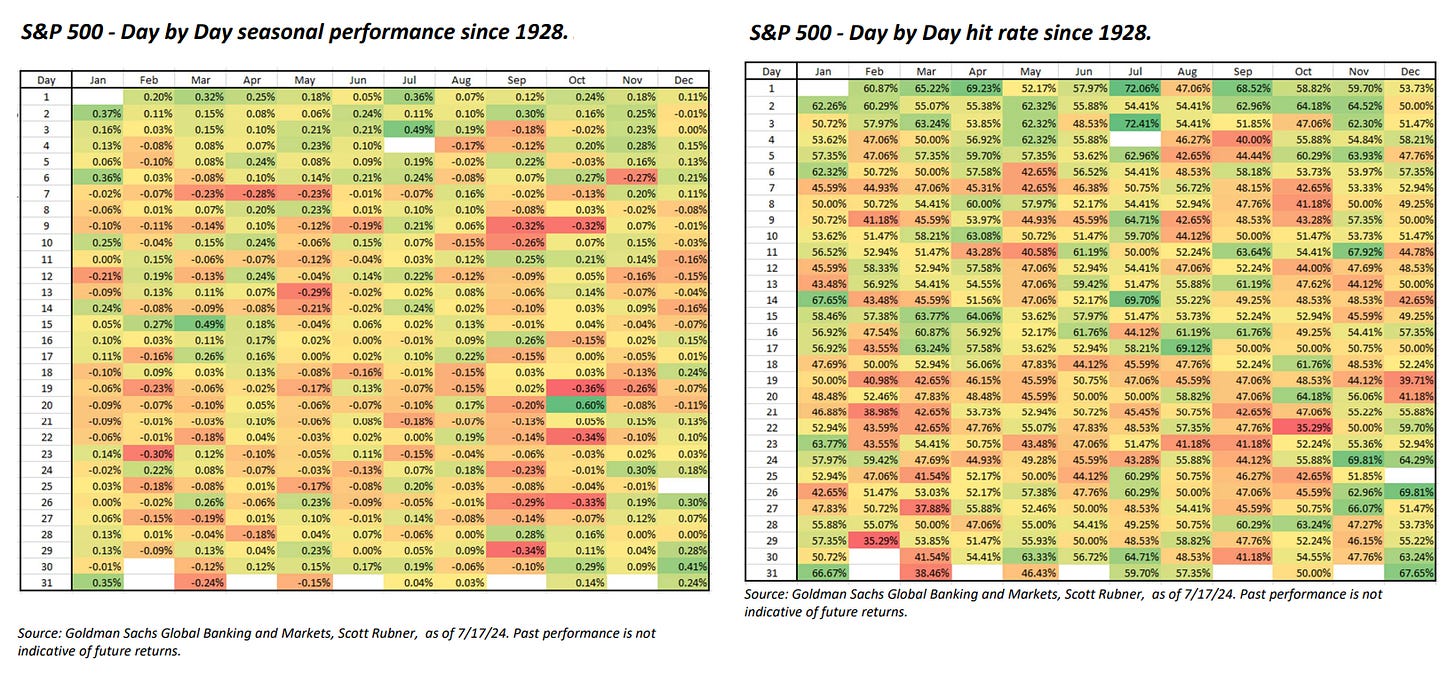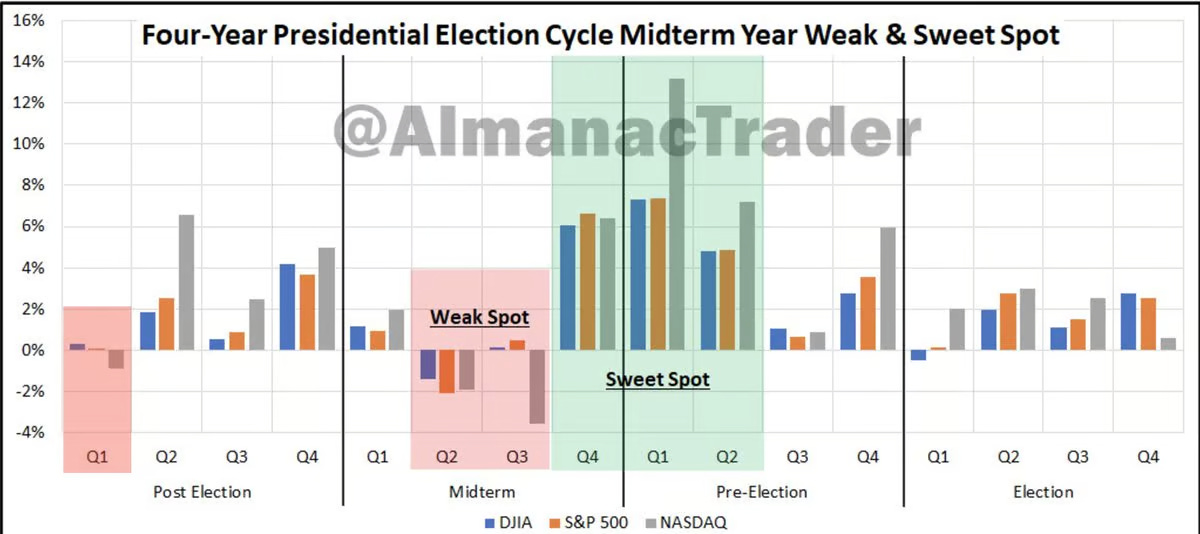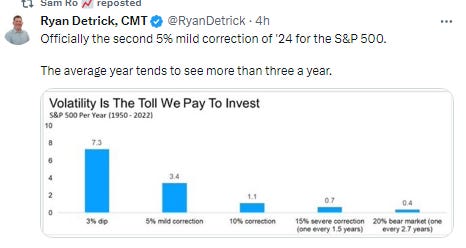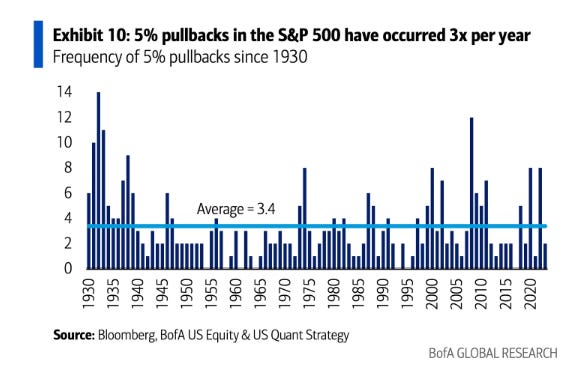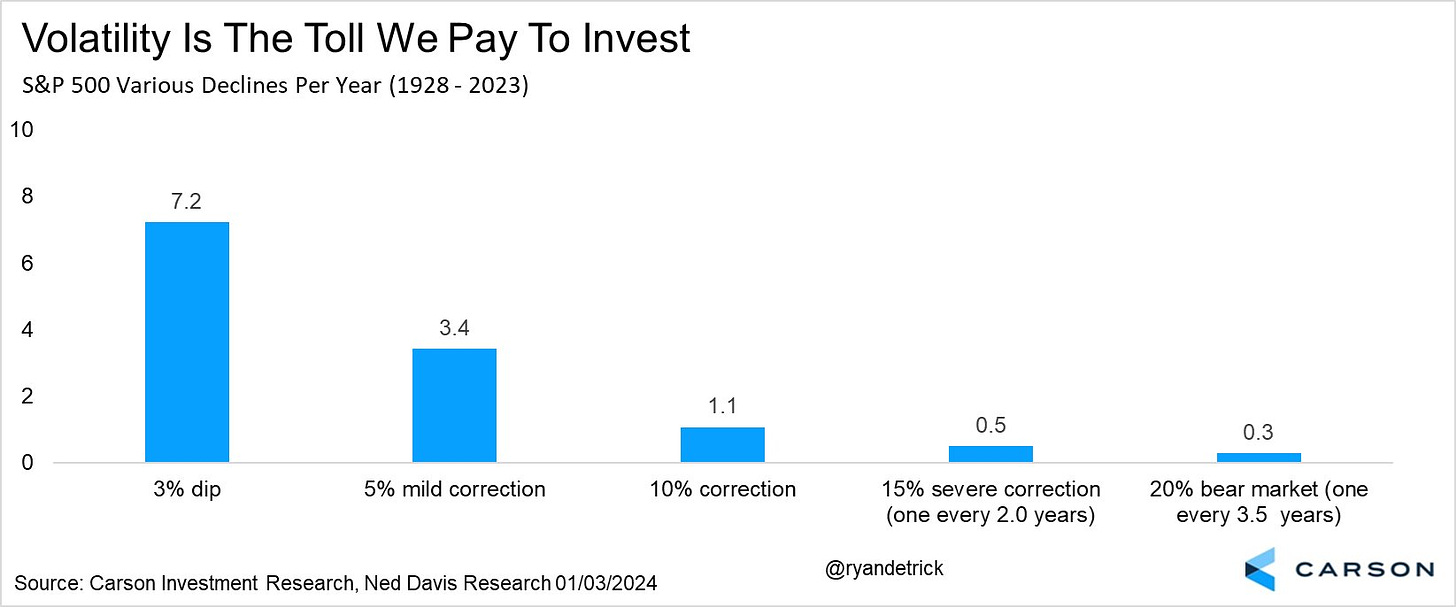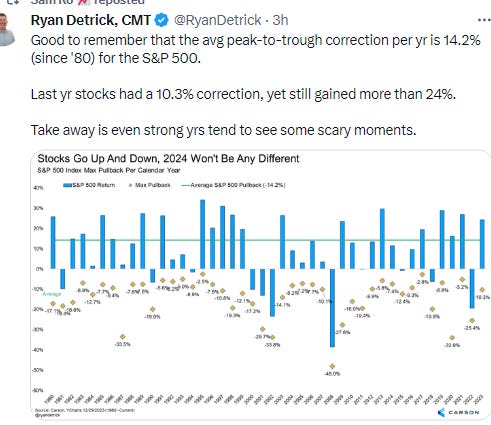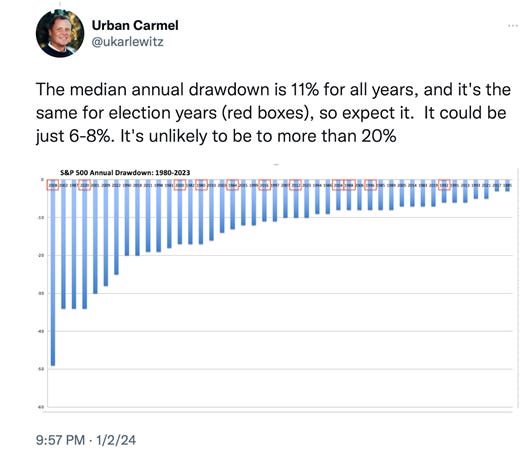The Week Ahead - 2/23/25
A comprehensive look at the upcoming week for US economics, equities and fixed income
If you're a new reader or maybe one who doesn’t make it to the end feel free to take a second to subscribe now (although then you’re missing my hard hitting analysis!). It’s free!
Or please take a moment to invite others who might be interested to check it out.
Also please note that I do often add to or tweak items after first publishing, so it’s always safest to read it from the website where it will have any updates.
As a reminder, some things I leave in from prior weeks for reference purposes, because it’s in-between updates, it provides background information, etc.. Anything not updated this week is in italics. As always apologize for typos, errors, etc., as there’s a lot here, and I don’t really have time to do a real double-check (it’s a staff of 1).
The Week Ahead
As noted last week, after a packed three weeks, last week started a slower end of month until we turn the page into March, and that continues in the upcoming week with three key exceptions. One of them is in US economic data in the Jan personal income and spending report which also includes the Fed’s favorite inflation metric, core PCE prices. The good news is you can get a pretty good indication for how that report is going to play out from all the data that precedes it during the month (CPI, PPI, nonfarm payrolls, spending reports, etc.). But you just never know until you get it for sure. Also, watch the personal spending number. If that comes in under expectations, it could add to the “growth scare” bets.
Otherwise, we do get a couple of secondary reports which feed into GDP in Jan durable goods orders (core capital goods shipments are a GDP component) and the goods trade balance. We also get the Dec home price indices, Jan new and pending home sales, Feb Conf Bd consumer confidence (which does have an inflation question, so we’ll see if that gets highlighted), the second update on 4Q GDP, and weekly jobless claims and mortgage applications.
In terms of the #Fed in the upcoming week, we’ll again get quite a few speakers including Logan, Barr (twice), Barkin (twice), Bostic, Schmid, Bowman, Hammack, Harker, and Goolsbee. We’ve heard from all of them in the past week (some multiple times) other than Schmid (KC Fed Pres) who is a 2025 voter and has previously been one of the more hawkish.
Logan will also be an interesting one, as she is one of the “go tos” with respect to the balance sheet due to her stint at the NY Fed, and so we will likely get more detail on the comment in the #FOMC minutes that the Fed might slow or pause QT given the event is called the “Balance Sheet Conference”.
Treasury auctions pick back up this week with our typical end of month auctions in the 2, 5 & 7-yrs, although they are moved up a day to avoid the end of month (they don’t like to do auctions on the last two days of a month), so they’ll be Monday, Tues, & Wed respectively.
4Q earnings the second area where we’ll see something of outsized importance in Nvidia’s earnings Wednesday. In large part due to that we’ll get 10% of the SPX reporting in terms of earnings weight in the upcoming week (up from 3% last week). NVDA is our largest reporter at $3.4tn, but we’ll get some other heavyweights in HD, INTU, CRM, LOW, TJX, all >$100bn in market cap in addition to a number of others not in the SPX (foreign domiciled) like Deutcshe Telecom (DTEGY), Royal Bank of Canada (RY), and Toronto-Dominion Bank (TD).
Finally, as a reminder, it’s the week after options expiration which can often see more volatility. Which brings us to our third potential catalyst in what comes out of Washington, although things seem to have slowed down on that front as I indicated might happen a couple of weeks ago given the increasing pushback the Trump administration is getting from a number of sides.
From Seeking Alpha (links are to their website, see the full earnings calendar):
Earnings spotlight: Monday, February 24 - ONEOK (OKE), Public Storage (PSA), Trip.com Group (TCOM), Zoom Communications (ZM), and SBA Communications (SBAC).
Earnings spotlight: Tuesday, February 25 - Home Depot, Intuit, Workday, Sempra (SRE), and Keurig Dr Pepper (KDP).
Earnings spotlight: Wednesday, February 26 - Nvidia, Salesforce, Lowe’s (LOW), TJX (TJX), and Stellantis (STLA).
Earnings spotlight: Thursday, February 27 - Vistra (VST), HP (HPQ), Rocket (RKT), Warner Bros. Discovery (WBD), and NetApp (NTAP).
Earnings spotlight: Friday, February 28 - EOG Resources (EOG), Chart Industries (GTLS), and AES (AES).
Ex-US, a big focus will be on the coalition dance following Germany elections over the weekend which came in mostly as expected (the conservative CDU/CSU block winning followed by the hard right Alternative for Germany, and soon-to-be ex-Chancellor Olaf Scholz’s Social Democrats third with the party’s worst result since World War II; a CDU/CSU/SD alliance is the most likely). Other highlights are Canada 4Q GDP, inflation reports from the top four EU economies, Australia, Tokyo (leading indicator for Japan), Mexico and Brazil, China flash PMIs, the G-20 in South Africa (although both the US and China will be absent) and policy decisions in South Korea (a cut is expected), Hungary, Thailand and Israel amongst others (holds are expected on the latter three).
In Canada, gross domestic product data for the fourth quarter is likely to show an economy picking up steam following aggressive rate cuts — though that momentum may stall as the looming trade war weighs on business investment.
In Asia, the Bank of Korea will be in the spotlight on Tuesday when authorities decide whether to resume the rate-cut cycle. While many economists expect the BOK to ease in a bid to prop up domestic demand and get ahead of any tariff impact on exports, Governor Rhee Chang-yong injected uncertainty earlier this month by saying it was by no means a done deal. The following day, the Bank of Thailand is seen holding its benchmark at 2.25%, though Bloomberg Economics expects pressure to continue for another cut later this year. Fresh off its first rate cut since 2020, the Reserve Bank of Australia will get consumer inflation data that’s forecast to show price gains accelerated marginally for a third month in January.
Japan publishes CPI data for Tokyo that may show inflation in the capital stayed elevated in February, while Singapore’s core CPI gains probably moderated to 1.5% in January. China reports preliminary PMI data for February on Saturday, with a key being the extent to which the manufacturing gauge recovers after a lunar-holiday dip in January. Taiwan reports preliminary gross domestic product figures for the fourth quarter on Wednesday, and trade data are due during the week from the Philippines, South Korea, Sri Lanka, Thailand and Hong Kong.
In Germany The aftermath of Sunday’s election in Germany will be the focus for investors. The pro-business CDU/CSU bloc, led by Friedrich Merz, took the biggest vote share after a campaign that often dwelled upon the country’s dismal economic record under Chancellor Olaf Scholz. The closely-watched Ifo business sentiment report on Monday is expected to show the highest reading since October. Bundesbank President Joachim Nagel presents his institution’s annual report on Tuesday. Data that may draw attention in the euro region in the coming week include inflation on Thursday and Friday from its four biggest economies, with economists anticipating outcomes ranging from slowing in Germany and France to a stable outcome in Spain and an uptick in Italy. In the UK, meanwhile, several speeches by Bank of England policymakers are scheduled, including Deputy Governors Clare Lombardelli and Dave Ramsden. Elsewhere in Europe, Swedish, Czech and Icelandic gross domestic product numbers for the fourth quarter will be released.
In South Africa, data on Wednesday will likely show inflation quickened to 3.2% in January from 3% a month earlier. The reading will be the first since the nation’s consumer price index was overhauled. The release was delayed by a week to allow the statistics agency to conduct additional checks and verifications on the data. On Wednesday and Thursday, South Africa will host the first Group of 20 finance minister-central bankers summit since Trump returned to office. The meeting comes as the global economy enters a precarious phase, with markets shaky and the easing cycle at risk because of US protectionist polices. Two key monetary decisions in the wider region will draw investors’ attention:
Israel’s central bank is set to hold its base rate at 4.5% for a ninth straight meeting on Monday. Ceasefires with Hamas in Gaza and Hezbollah in Lebanon have started to lessen economic pressures, but inflation is still at 3.8%, above the country’s official target of 1%-3%. Governor Amir Yaron has pointed to that and signaled easing won’t begin until the second half.
Hungary’s central bank is expected to keep interest rates stable for a fifth month on Tuesday at the final meeting to be chaired by outgoing Governor Gyorgy Matolcsy. Policymakers have no room to cut borrowing costs this year, another outgoing official, Gyula Pleschinger, told Bloomberg in an interview.
In Latin America, Mexico’s mid-month consumer prices report may serve up a dose of whiplash, with the early consensus for a jump back up of some 30 basis points from 3.48% in the second half of January. Less alarming, the core print may only budge slightly from its current 3.61%, within the central bank’s 2% to 4% inflation tolerance range though above the 3% target. Latin America’s No. 2 economy will also serve up the January’s unemployment rate — currently running near all-time lows — along with trade, lending and current account data. Chile’s end-of-month data dump for January, which comprises six separate indicators including industrial production, retail sales, copper output, should show little drop-off from the economy’s strong finish to 2024. Argentina closes the books on 2024 with December GDP-proxy readings. After pulling out of recession and posting two months of better-than-expected growth, the nation may lead growth among the region’s big economies in 2025. A smattering of Brazilian economic reports for December posted earlier this month, including Brazil GDP-proxy data and retail sales, suggest Latin America’s biggest economy may finally be cooling off. On the other hand, consumer prices can be expected to rebound from last month’s 4.5% reading — the top of the central bank’s tolerance range — and may not return there before some time next year.
And here’s BoA’s cheat sheets.
And here’s calendars of 2025 major central bank meetings.
Market Drivers
So let’s go through the list of items that I think are most important to the direction of equity markets:
Fed/Bonds
As noted previously this was one of the sections that had grown unwieldy, so I’ve really pared it down. Given I provide daily updates on Fed expectations, Fedspeak, and analyst thoughts on the Fed, it’s duplicative (and time consuming) to gather it all again so, again, I encourage you to look at those (the daily posts) for updates. I will just give more of a quick summary.
I noted in late December,
Markets have taken 2025 pricing down to less than two cuts with just around a 50/50 chance of a cut in the first half of the year. After 100bps of cuts so far, just a few cuts before a prolonged hold would be consistent with the 90’s “soft landing” experience (where there were 75bps of cuts), and it’s certainly not implausible that inflation gets “stuck” around current levels and growth and labor markets remain in good enough shape that the Fed does have just one or two (or even no) cuts in 2025, but I think it’s also not unlikely that we see continued softening in labor markets and the economy, and with just 18% of investors expecting a recession in 2025, it feels like a growth scare and a quicker path of Fed rate cuts is underpriced.
And since then, as noted last week “we’ve seen pricing ebb and flow along with the data and different appearances by Powell but remain in the one to two cut range.” I said two weeks ago,
A hot CPI print will officially take a March cut off the table absent a very unexpected turn in the labor market, although a cool print might not do that much for pricing given recent Fed commentary on wanting to wait until there’s greater clarity on the Trump administration’s policies. There’s also a cohort (Bowman, Logan, Musalem) that don’t think rate cuts are appropriate regardless of what happens with inflation as the strength in the economy demonstrates that rates are not restrictive. So risks are not evenly dispersed in my opinion. All of which means while yields may drift higher or lower I continue to expect they will be range bound this year until we get greater clarity on Trump policies and the first few months of inflation prints. Those will be key in determining whether we get another bout of residual seasonality which has seen 1Q inflation spike the past couple of years. If it doesn’t the y/y numbers will fall quickly, and might be enough to squeeze one or two more cuts out even if growth doesn’t fall back. So, as I wrote the last few weeks, “For the time being, all we can do is wait for now and see how things progress.”
And as I noted last week,
unfortunately we did see that residual seasonality rear its head in Jan’s CPI report which saw Fed cut expectations quickly wither to the least since after the January NFP (when they fell to no chance of a second 2025 cut), but as noted in the daily updates that was softened by a PPI report which saw very favorable read-through to the core PCE prices, the Fed’s favorite inflation metric, and then we got the much weaker than expected retail sales report which unwound all of the repricing that had followed CPI on Wednesday, leaving us basically where we started the week with around 1.5 cuts priced for the year, which is where as I noted earlier is where I think we’ll stay unless/until we get that “growth” scare (last week’s retail sales report doesn’t count given all of the distortions from tariff front-running, wildfires, and winter storms) or a continued series of hotter than expected inflation prints. There’s not much on the calendar that’s market moving for Fed Futures in the upcoming week, so I would expect I won’t have much more to add a week from now.
And that was fairly accurate until Friday when we did get a whiff of that “growth scare” in the weak flash services PMI (along with the drop in business and consumer confidence). That was enough to get us back to basically where we were at the start of the month before the strong NFP, jump in inflation expectations, and hot CPI in terms of Fed rate cut expectations.
The big item this week is PCE prices numbers (core, supercore, etc.), but we generally have a pretty good idea how those will come out, so I don’t expect anything that market moving, but as I said above “you never know”. What could though have as much of an impact is the personal spending number. If that comes in under expectations, it could add to the “growth scare” bets. We also have quite a few Fed speakers who can move the market incrementally.
The 2/10 curve remained little changed last week +2bps to +0.23% still down -18bps from Jan 14th when it hit the steepest since May ‘22. It started the year at +0.33%, so it is down -10bps from there.
As a reminder, historically when the 2/10 curve uninverts following a long period of inversion the economy is either in a recession or within a few months of one. It uninverted in Sept, so this looks officially like a "this time is different" situation.
The 3mos/10yr yield curve (considered a better recession signal than 2/10’s w/the last four recessions on average coming a few months after the curve uninverted (prior to that it generally uninverted after a recession had already started)) also little changed w/w -3bps to +0.10% now down -32bps from the steepest since Oct ‘22 hit Jan 14th (but still up +1.55% since Sept 11th). It uninverted Dec 12th, so the clock is ticking on this being a useful recession indicator.
I had been a broken record that I thought the 2yr #UST yield was too high, trading at times above the current Fed Funds effective rate (meaning the 2yr was pricing a higher chance for net rate hikes than cuts over the next 2 years). Since then it has softened so that it’s now -13bps (-6bps w/w), getting closer to what seems reasonable. But with Fed Funds futures pricing 45bps of cuts, seems there’s more to go unless the Fed is truly done with rate cuts for this cycle.
Long term inflation expectations as measured by the 5-yr, 5-yr forward rate (exp'd inflation starting in 5 yrs over the following 5 yrs), specifically mentioned by Powell at the Nov FOMC press conference (he said the metric was “right where it’s been, consistent with 2% PCE inflation”), edged lower this week, -1bps w/w to 2.23%, the least since Dec 19th. They are now -6bps since the Nov FOMC.
10-yr breakevens though remain near the highest since Oct ‘23 at 2.42%.
With nominal 10yr Treasury yields falling a little more than inflation expectations last week, 10yr real rates fell back -6bps to +2.02%, now down -32bps from the +2.34% on Jan 13th which was the highest since Oct ‘23 (and before that 2007), though still well above the 2010-2020 peak of 1% (but down from the post-pandemic peak Oct ‘23 of 2.5%).
10yr real rates using 5-yr, 5-yr forward inflation expectations (subtracted from the 10yr nominal yield) I have only have through Thursday and they were up +6bps to 2.24%, but I’m sure were lower than that on Friday, still down -21bps from 2.45% on Jan 13th which was the highest since Oct ‘23 (and before that 2007)), still though well above the 2013-2020 average of around 0.5% (but down slightly from the post-pandemic peak of 2.5% in October '23).
And as a reminder according to BoA the importance of real rates on equity returns has seen the largest increase in the factors they track over the past 5 yrs and explains a larger proportion of stock returns (83% correlation) in their data (to 2006), with the dollar close behind the most correlated (76%) since 2015.
Shorter-term real yields (Fed Funds - core PCE) now down to 1.68%, the least since Sep ‘23. While still the highest since 2007 before that, it’s down from 2.70% in June. (this won’t get updated until the end of the month)
And the real prime rate (using core PCE) continues to edge lower from the 5.9% in June, which was the highest since Sep 2007. Now down -1% at 4.9%, the least since Aug ‘23, still though more than double the 10yr pre-pandemic avg. (this won’t get updated until the end of the month)
And looking out longer term, one thing to note is the FOMC’s long run projection for the endpoint of the Fed Funds rate (the “neutral rate”) is now the highest since Sep 2018 at 3.0% (and not unlikely to go higher as I said earlier this yr). [This won’t get updated again until March].
The ACM model of the 10yr term premium (which is solely based on interest rates) was up to +0.40% as of Tuesday last week but it was likely lower by the end of the week, still well off the +0.66% it hit Jan 13th (which was the highest on this model since May 2015), but still up ~+54bps since the FOMC did the 50bps cut in Sept.
https://en.macromicro.me/charts/45452/us-10-treasury-term-premium
FWIW the the St. Louis Fed 10yr term premium estimate (which runs a week behind and is based off the Kim and Wright (2005) model (which differs from other models in that it incorporates non-yield curve factors such as inflation & GDP) continues to show a higher term premium than the ACM model at +0.64% as of Feb 14th unch w/w but down from +0.80% Jan 10th which was the highest since Apr 2011. It is up +62bps since the Sept FOMC.
The extended discussion on term premium (what it is, why it’s important, etc.), can be found in this section in the Feb 4th Week Ahead.
I guess volatility goes both ways, and the drop in bond yields saw the MOVE index of expected 30-day Treasury note/bond volatility see a relatively sharp move up from the lows of the year Wednesday (which were not far from the lows of 2024 hit in December (which were the lowest since 2022)). Still though not even at the highs of the month.
30yr mortgage spreads though were unchanged w/w at 2.34%, remaining near the lowest since June ‘22 (2.27%) hit Dec 19th, and well off the 3.1% peak in June ‘23. But they are around +62 bps above the 2010-2020 avg level.
Lower spreads (compared to mid-2023) is what has kept 30yr mortgage rates from moving much over 7% like they did in Oct ‘23 (when they peaked at 7.8% according to Freddie Mac), so hopefully they will remain contained.
Chicago Fed National Financial Conditions Index and its adjusted counterpart (the latter attempts to remove the correlation between the various indicators due to broad changes in economic conditions), both of which are very comprehensive each w/105 indicators, in the week through Feb 14th saw the former fall to the least tight since Oct 2021 while the latter tightened for a second week but remained just two tenths off the least tight since Nov 2021.
https://www.chicagofed.org/research/data/nfci/current-data
As the Fed continues to drain liquidity from the system via QT, I think it’s important to watch for stresses which give an early warning signal that they are perhaps going to far as they did in 2018 which led to a near bear market. One area I am monitoring is reverse repos (which is an overnight secured place institutions (mostly money markets and banks) can park excess funds to accrue some interest designed by the Fed originally to keep excess liquidity from pulling down rates too much in other short term markets). RRP grew rapidly in 2021 & 2022 as money was pumped into the system but since May ‘23 has been steadily drained down by the Fed’s QT program and higher bond issuance with banks discouraged by regulatory rules from taking up the increased Treasury supply.
In particular, the continued sizeable issuance of T-bills (<1 yr duration) of around $800bn/month (accentuated by the $60bn in balance sheet runoff (meaning the Fed has reduced its buying of maturing Treasuries by that amount which the private market has to fill)) drained ~$1.75 trillion from RRP in the year through March 1st. From then until early July RRP levels had remained relatively stable in the $375-$500bn range, but since early July they resumed their decline (in fits and starts), hitting new lows on Dec 20th at $98bn, the least since Apr ‘21 on the back of the Fed cutting RRP rates to the low end of the Fed Funds band which made parking funds there (versus lending overnight to other institutions or buying T-Bills) less attractive in line with their desire to sop up most of this “excess liquidity” (as they have described it).
RRP on Friday was little changed w/w at $69bn, up +$10bn from the previous Friday which was the lowest since Apr ‘21, with the increase due to the fact that the Fed has cut its T-Bill issuance as it is up against the debt limit and is constrained in its ability to issue new bonds (just refinance maturing ones. The build is in line with expectations from BoA and other market commentators and will likely continue until the debt ceiling is raised (when it is predicted to drop quickly).
And while previously despite the drawdown in RRP the Fed had been unconcerned with the Dallas Fed Pres Laurie Logan (who is an important voice given her extensive experience in the NY Fed's markets group) saying she believed current liquidity to be “more than ample” and looking for RRP to fall to "negligible" levels, I said I remained on the lookout for funding stresses once RRP had crossed below $100bn, and I said at zero RRP the Fed may need to stop QT to avoid another liquidity shortage as they did in late 2018.”
And it appears now the Fed has decided they’re not going to make the same mistake twice noting in the FOMC minutes this week that they were considering reducing or pausing QT. As the Fed minutes are “managed” (i.e., not a verbatim transcript which we get years later but what the Fed wants to be communicated) this I think was a signal to the markets. BoA agrees, and they this week adjusted their call to QT pausing in March with an April implementation with “QT stop after debt limit (DL) resolution (most likely in July / August)”. They also see a return to QE in Q4.
The reason monitoring RRP is important is that once it’s gone, it’s expected to begin to pressure bank reserves (absent some other buyer shall as stablecoins which have been a buyer of T-Bills) to absorb any extra debt issuance, etc., that is not sold to foreign and domestic buyers unless/until the Fed pauses/stops QT. However, banks have been loathe to part with reserves beyond the $3tn level (which is where we saw indigestion in the credit markets in March ‘23 (which contributed to the banking issues (SVB, etc.)).
For now, at least, they remain comfortably above that at $3.27bn, up +$10bn w/w through Wed (Jerome Powell noted three weeks ago that the Fed is watching for reserves to "approach levels that are somewhat above ample," meaning they see them as more than sufficient at current levels).
Overall, bank reserves are just -$90bn below June 1, 2022 levels ($3.36tn), when the Fed started QT, a better result than even the most optimistic estimates at the time.
For background on various estimates of when reserves will be “too low” see the Feb 4th Week Ahead.
Getting back to rates, I said 10 months ago 2-year Treasuries were a good buy at 5%, and as I noted once the Fed started its cutting cycle the ship has likely sailed on seeing those yields anytime soon (meaning years). In terms of 10-yr’s I had advised then grabbing some at 4.7% which I had thought seemed like something we wouldn’t see anytime soon, but as I noted eight weeks ago with the Fed saying the ‘recalibration phase has ended’ along with concerns about sticky inflation cropping back up and now questions about the inflationary impact of some of Donald Trump’s policies, if inflation concerns resurface, we could get back there. And those things dd in fact occur, and we were well on our way until a more constructive Powell and comments from Treas Sec Bessent about his focus on keeping the 10yr yield low and sticking to the auction schedule set up by Sec Yellen, has kept yields from running higher, likely confirming that we’re in a trading range between 4.1 and 4.8% on the 10yr for now. As noted previously, the 2yr will likely not see a lot of movement unless we get some big movement in Fed rate cut (hike?) expectations.
But in terms of much lower yields, as I said four months ago, we have probably seen the lows until we get a recession:
“while we didn’t quite see 3.5%, I think 3.6% is close enough, and I think we might have been at or near the lows at this point, particularly as the Fed has been raising their neutral rate estimate. If the endpoint for Fed Funds is around 3% (or higher) then it’s hard to see the 10yr trading much lower absent a recession. Similarly 2yrs at 3.6% seem to be very rich and almost certainly too low absent a recession consistent with my statement last week.” In short I’d expect to see 4% on these before we see 3.2%:
At around 3.6% on both the 2 & 10yrs absent a recession I think there’s not much value in either (I’d rather park my cash in short term Treasuries (0-3mths) or safe dividend paying stocks with a track record of growth (dividend aristocrats, etc.) at these levels.
For all the old “final hike” and “first cut” materials, you can reference the Feb 4th blog post.
BoA updated their FOMC Dove-Hawk Chart. Note it’s missing Hammack in ‘26 (Cleveland and Chicago vote every 2 yrs), but otherwise looks right. Also note that Philadelphia Fed Pres' Harker’s term is up this year (which is why they don’t have a name for Philadelphia), something I didn't realize.
I think this now needs some dramatic changes with Hammack (who dissented voting for no cut in Dec) clearly one of the most hawkish members, Daly at best a Centrist as she sees only 2 cuts in 2025, and perhaps Collins as well. Goolsbee is clearly the most dovish of the members currently.
And I came across one from BBG. I think it’s pretty accurate except Kashkari is definitely not that hawkish (he was calling for a December cut in early November):
And here who is rotating off and on for 2025.
Earnings
As a reminder, I have removed most of the background material, which you can get in the Feb 4th blog post. As you know I’ve moved on to 4Q and beyond. You can reference this post from 12/1/24 for stats on 3Q.
NO UPDATE FROM FACTSET THIS WEEK, SO I LEFT IT ALONE FROM LAST WEEK WITHOUT THE CHARTS FOR REFERENCE, BUT THERE ARE SEVERAL POSTS RELATED TO EARNINGS BELOW THAT ARE FROM THIS WEEK. THEY WILL RETURN NEXT WEEK, AND I’LL GIVE A FINAL UPDATE ON 4Q AS WELL AS WHERE 2025 (AND 2026) EXPECTATIONS STAND.
With 77% of SPX earnings in for Q4, Factset says 76% have beaten exp's (-1% w/w), below the 5-yr avg of 77% but above the 10-yr avg of 75%, and those beats edged down to +7.3% above exp’s (from +7.5% the prior week but +5.0% the week before that) below the 5-yr avg of +8.5% but above the 10-yr avg of +6.7%. Despite the lower beat amount, earnings estimates continue to push higher up another +0.5% w/w to +16.9% (up +5.2% the past five weeks), and up from +11.8% at the end of the 4th quarter. This would be the most growth in three years and would mark the 6th consec quarter of earnings growth.
As we’re seeing, it’s normal for there to be a “beat” which sees actual earnings surpass estimates as of the end of the quarter (only 3 times in the past 40 quarters has that not happened (Q1 ‘20, Q3 ‘22, Q4 ‘22) according to Factset. The estimate at the start of the quarter was +11.9%. The 10-yr avg has seen a lift of +5.4%, 5-yr is better at +7.1%, but the past 1-yr has only been +2.2%. It seems at this point we’re going to clear we’re going to beat the lower bar.
In terms of Q4 revenues, 62% of SPX reporters have beaten est's (down -1% w/w), below the 5-yr avg of 69% and 10yr avg of 64%, and they are just +0.8% above est’s (-0.1% w/w) well below the 5-yr avg of +2.1% and 10yr avg of +1.4%. Still, Factset says SPX co’s are expected to see revenue growth of 5.2% y/y (+0.2% w/w), equal to the +5.2% on Sept 30 but up from +4.6% at the end of the 4th quarter. It would mark the 17th consecutive quarter of revenue growth for the index.
In terms of profit margins, Factset says SPX co’s are expected to report net profit margin of 12.5% for Q4 (+0.4% w/w), now above the previous quarter’s net profit margin of 12.2%, the year-ago net profit margin of 11.3% and the 5-year average of 11.6%.
While Q4 earnings expectations continue to increase, 2025 quarter-by-quarter earnings continue to fall according to Factset particularly for Q1 & Q4.
Q1 ‘25 fell -0.6% to +8.1% (-6.0% last 15 wks), Q2 ‘25 down three tenths to +9.9% (-3.2% last 15 wks), Q3 down a tenth to +14.5%, and Q4 down -0.4% to +12.9% (-3.7% the past 3 wks).
With Q4 earnings expectations increasing, FY ‘24 exp's according to Factset rose another $0.73 to $241.37 (up ~$2 the past two weeks), representing +10.2% growth (up +0.1% w/w). Looking further back, it remains down just around -1.7% from July 1, 2023, much better than the typical -6% or so drop we historically see.
2025 earnings expectations though with the quarter-by-quarter numbers deteriorating, fell to the least in 2 yrs at $272.10 (-$0.65 w/w, down ~-$3 the past three weeks, although weirdly the y/y growth rate improved to +12.7% growth (+0.7% w/w but still down ~-4.1% since Sept 1st (which is in line with the historic average excluding "outlier" years (2001, 2008, 2009 & 2020 (see below)))).
In terms of the earnings growth exp’d for 2025 Factset notes it will be a record, although also notes that there is on average over the past 25 yrs a -6.3% deterioration from where it starts the year ($275.05) w/analysts overestimating in 17 of those yrs (which would equate to $257.72 based on the average deterioration). But it should be noted that average includes 4 outlier years (2001, 2008, 2009 & 2020) where the overestimation was b/w 27-43% due to recessions. Excluding those, the difference is just -1.1% (which would equate to $272.02 (a little below where we are now)).
2025 revenues are expected to grow +5.5% down -0.2% since Dec 31st.
FWIW 2026 earnings are exp’d to grow 13.9% (up +0.3% w/w & +0.6% since Dec 31st).
In terms of how markets are handled earnings beats & misses for 4Q, looking 2 days before to 2 days after an earnings release, Factset continues to see beats getting just half the normal reward at +0.5% up +0.2% w/w but well below the 5yr avg of +1%, but misses are now punished slightly less than average at -1.8% (from -2.4% the prior wk & vs 5yr avg of -2.3%).
Factset’s analysis of analyst bottom-up SPX price targets for the next 12 months as of Thursday was up +32pts w/w to 6,920 (which would be +13.2% from Thursday's close), now up ~1,887 points over the past 46 weeks.
Energy (+16.7%, down from +18.1% the prior week) replaced Tech (second at +15.9% down from +18.3%) as the sector with the largest upside seen by analysts, while Consumer Staples remains as the sector expected to see the smallest price increase (+6.3% down from +7.2%) followed by Financials (+8.8% up from +7.6%).
As a reminder the last 20 yrs they have been on avg +6.3% too high, but note they underestimated it five of the past six years (including 2024).
In terms of analyst ratings, buy and hold ratings continue to dominate at 54.8% & 39.4% (from 54.6% & 39.6% respectively last wk (sell ratings remained at 5.8%)). That 54.8% in buy ratings though is down somewhat from 57.5% in Feb ‘22.
Energy (63%), Communication Services (63%), and Information Technology (62%) sectors have the highest percentages of Buy ratings, while Consumer Staples (41%) has the lowest percentage of Buy ratings. Utilities has the most sell ratings (8%), Energy & RE the least (3%).
And some other earnings stuff:
Economy
Over the past 2+ years part of my earnings optimism has been due to the economy holding up better than expected. While earnings only track the economy loosely (and markets look forward 6-12 months), there is a clear positive correlation between the economy and earnings (particularly a weak economy and weak earnings), and there is a very strong correlation between earnings and stock prices (although stock prices (being as noted forward looking) generally fall in advance of a recession and bottom 6-9 months before the end of one). So if you can see a recession coming it is quite helpful, although very difficult (especially ahead of the market). You can reference this Week Ahead (see the Economy section) for a lot of material on how every recession is preceded by talk of a “soft landing” as close as a month before the start. That report also has the notes about how small caps have shorter debt maturity profiles and more of it (debt).
As I’ve been stating since I switched to the Week Ahead format in mid-2022, the indicators to me are consistent with solid (which at times has been robust) economic growth, and I have been a broken record that I “certainly do not think we’re on the verge of a recession (although as noted above every recession starts out looking like just some economic softening).”
After several weeks of stronger growth following the more mixed performance we’d seen in late November/December, I said last week “was described by many as less so, but really other than retail sales (which as I noted in that Friday’s summary was a very messy report (to the point that BoA predicted a very weak outcome despite their overall constructive outlook on the US consumer), things were on balance evidence of a strong economy with prices remaining firm, jobless claims remaining low, and industrial production solid (although much was due to a jump in utilities with manufacturing seeing a slight decline).” This week’s reports were similar, although there is no really positive way to spin the services flash PMI on Friday as while manufacturing showed acceleration, there was a marked deceleration in services (17-mth low) which represent 80% of the economy with broad weakness in orders, production, employment, and sentiment. Prices meanwhile continue to inflect higher. Housing starts were also weak, but like retail sales weather likely had a big influence.
So for now I don’t see any reason to change my overall takeaway on the economy from the start of October that “the situation continues to seem like manufacturing is subdued but trying to bottom [which now seems to be “has bottomed”], housing perhaps has inflected off the bottom, labor markets (and the services sector and construction in particular) are solid with very healthy wage growth [although perhaps we’re seeing the first cracks start to form], and productivity appears to remain robust (this can be a game changer in allowing the economy to expand without triggering inflation)…. I continue to feel that any softening does not appear to be morphing into a recession.”
And as I said 25 weeks ago:
without question, the evidence is building that the days of >3% real GDP growth are behind us (although we got there in Q3), and we should be happy to settle into something more around trend (1-3% real (infl adjusted) growth). That though is far from a disaster. The important thing will be to see the softening level out (L-shape) rather than continue to fall turning the “soft landing” into a recession.
So far that’s what we’ve seen.
The Citi Economic Surprise Index fell another -7.3 pts w/w though Friday, to -7.8, the weakest since September (when it was going the other direction), down now -30.3 pts from the highs of the year (22.5) five weeks ago (and now -51.1pts from the December highs (43.3)).
The 2024 high was 47.2 (in Feb) and the low -47.5 (in July).
https://yardeni.com/charts/citigroup-economic-surprise/
And GDP estimates are for now consistent with a no recession call (again though remembering GDP going into recessions generally doesn’t look like one is coming (it was up around 2% in Q2 & Q3 2008 well after the recession had started)). After Q3 was revised up to 3.1%, Q4 decelerated but still above trend at 2.3%, and the trackers that have initiated Q1 tracking are currently looking for around that in Q1 (although it’s very early and there is a wide spread).
Atlanta Fed (who was right in line in its 3Q & 4Q est’s of GDP (and just a tenth off for 2Q from the 1st est)), leaves its 1Q ‘25 GDP estimate at 2.3%, after incorporating housing starts. That said, there were literally no changes from Friday, and starts were worse than expected (which should have dropped residential investment), so I’m not 100% this is accurate.
BoA (who as a reminder was right on for 4Q GDP vs the 1st estimate and two tenths high for 3Q), initiated their 1Q tracking on Thursday at 2.3%, two tenths below their “official forecast” of 2.5%. Over the past week retail sales, biz inventories, and industrial production all were detractors (while industrial production beat due to a jump in utilities, “mining, manufacturing, and business equipment were weaker than expected”).
NY Fed’s 1Q #GDP Nowcast (as a reminder, they had 2.56% for 4Q vs 2.3% 1st est (they were off a similar amount for 3Q)) fell back but remains the highest of the trackers I follow at 2.95% down from 3.02% last week (with minor subtractions from housing starts and the Philly Fed manufacturing index offset a bit from the NY Fed index).
As a reminder, the NY Fed’s model is dynamic and so adjusts in real time as data evolves, and “parameter revisions” subtracted -0.01%.
And the St. Louis Fed GDP tracker, which has often undershot actual real GDP since Q2 ‘22, but which was right on in Q1 & Q4 2024, saw its tracker fall to 1.77% from 2.11% the prior week (I don’t think it had retail sales last week), remaining the lowest of the Fed trackers.
Weekly Econ Index from the @DallasFed (scaled as y/y rise for #GDP), which runs a week behind other GDP trackers, in the week through Feb 15th fell back to 2.16% from 2.53% in the prior week (rev’d from 2.49%) falling towards the middle of the 2024 range (1.49 - 2.66%) that it left only twice during 2024 but which it had been above again the last two weeks in January.
The 13-wk avg though continued its steady improvement now up to 2.45%, the best since early 2022, evidencing overall economic momentum that is accelerating above trend, although the weekly read is now back below it.
https://www.dallasfed.org/research/wei
Other economy stuff:
Valuations
Like the other sections, I’ll just post current week items regarding the multiple. For the historical stuff, see the Feb 4th blog post.
With equities pulling back a little and forward earnings expectations edging higher forward P/Es fell back.
-The SPX forward P/E down four tenths to 21.8 where it has been for now four of the last five weeks, still just -0.5pts from the highest since mid-'21.
-Mid-caps (S&P 400) remained down five tenths to 15.6 (down -1.5pt from the highest since early-’21 (17.1)).
-Small caps (S&P 600) down five tenths as well to 15.3 (down -1.6pts from the highest since early-’21 (17.1)).
-Yardeni's “Megacap-8” (adds NFLX) P/E down for the fourth week in five -0.8pts to 28.7, now just +2.3pts from the 26.4 it hit in early Oct which was the least of 2024 (31.5 was the 2024 high from July (which was the highest since Jan ‘22)).
https://yardeni.com/charts/stock-market-p-e-ratios/
Other valuation stuff:
Breadth
Breadth which was looking great four weeks ago, but continued to deteriorate last week in most respects. Some green shoots perhaps in the value/growth and equal weight/cap weight ratios.
The McClellan Summation Index ("what the avg stock is doing") rolled over ever so slightly Friday from a 2-mth high.
% of stocks over 200-DMAs fell back last week to the lowest since mid-Jan.
% of stocks above 50-DMAs, were mixed with NYSE seeing a more moderate drop while Nasdaq saw the percentage fall like those over 200-DMAs to the least since mid-Jan.
% of stocks above 20-DMAs fell even more sharply than those over 50 or 200-DMAs although remain above the December lows (well above for the NYSE which was the lowest since Mar ‘24 in Dec).
Jeff De Graaf on this week’s Off Script podcast says he prefers this to advance/decline line and says it is a “relatively low number… this is not an everyone is participating type of market” and evidences a lack of momentum (vs in December 2023) where “the risk is chasing names”.
Value/Growth moved higher w/w for the first time since the end of January from just above the lows of the year which were the least since Jan ‘22. We’ll see if it can get over that January peak which would put it at the highest since early December.
The equal-weighted SPX vs cap weighted ratio like value/growth made progress but not even to the highs of the month remaining (so far) just off the lows of the year.
Unlike value/growth or the equal-weight/cap weight ratios, $IWM:SPY (small caps to large caps), didn’t spike four weeks ago (DeepSeek day), didn't see a bounce this week, and is now at the lowest since July (which was the least since 2000).
Equity sector breadth based on CME Cash Indices deteriorated last week with just 2 of 11 sectors green, down from 6 the prior week, the least in at least a month, although both sectors were up more than +0.7% (vs five the prior week), and one up over 1% (from three the prior week). But six were down >-1%, four >-2%, two >-3% and one >-4% (Cons Discr). Defensives the clear outperformer taking four of the top five spots (just energy (which was the top sector) did better (it was also up >1% the prior week).
SPX sector flag showing the details. Some big names seeing big losses last week with AMZN, META, TSLA, WMT, AVGO, HD, CRM all down at least -5% (and UNH & PLTR both down over -12%). JPM was -4%. But AAPL, MSFT, NVDA, BRK, LLY, PG, XOM, DIS little changed or up a bit.
Other breadth stuff:
Flows/Positioning
Overall global flows from BoA (EPFR data): : $16.8bn to equities, $16.2bn to bonds, $3.3bn to cash, $2.2bn to gold, $0.2bn from crypto
Here were some notables.
• Treasuries: biggest inflow in 6 weeks ($3.7bn – Chart 11),
• HY bonds: biggest 5-week inflow since Oct’24 ($2.6bn inflow this week – Chart 12),
• Europe: biggest weekly inflow since Feb’22, i.e. before start of Russia/Ukraine/NATO war ($4.0bn – Chart 13),
• Tech: biggest 3-week outflow on record ($2.9bn outflow this week).
Bank loans again easily topped the FICC table of flows by % of AUM (6th wk in a row, and 20th consec inflow) with TIPS seeing a 6th week of inflows (although slowing but after seeing outflows for almost all of 2024).
And from BoA’s Feb Fund Manager Survey released this week:
ICI data on money market flows saw a -$9.5bn outflow in the week through Feb 20th, vs the +$3.3bn inflow EPFR saw. The outflow was all institutional which fell -$21.5bn, while retail added +$12.0bn. In terms of totals, 60% of MMF’s are still held by institutions, 40% retail.
ICI data saw ~+$962bn in MMF inflows in 2024 and +$1.15tn in 2023. Total MMF assets are at a record $6.92tn.
https://www.ici.org/research/stats/mmf
Looking at CTA (trend follower) US equity positioning, BoA says that according to their models “US equity trend in the S&P 500 and NASDAQ-100 is still at moderate levels so while CTAs could be sellers on further downside, the impact could be less dramatic as positioning is not stretched. Russell 2000 price trend could turn negative next week.”
So, after some modest selling last week (a little more on the RUT) edging net length off the highest of the year for all three, BoA’s model sees selling likely continuing in the upcoming week for the RUT, but the SPX & NDX will follow price (buying on advances, selling on declines).
Price trend remains the strongest for the $SPX at 60% up from 59% last week while #NDX is up to 58% (from 54% (but still down from 61% five weeks ago), while the $RUT has turned lower to 20% from 29%, but that’s still up from -2% three weeks ago and -19% five weeks ago). #Japan’s #Nikkei225 edged up to 15% (from 13% but down from 31% three weeks ago) while the Euro #Stoxx50 is at 98% which “is quite stretched long.”
In terms of gamma positioning, BoA says “SPX gamma has been quite elevated this week, averaging long $12bn - roughly the level at which it ended Thursday (+$12.7bn, 92nd 1y %ile). With SPX gamma consistently stretched, our estimates suggest that the impact of option delta-hedging on S&P e-mini realized volatility may have grown to a reduction of up to ~2.7 vol pts (21% of the vol level) over the last 1-month.”
So BoA says last week as they noted the week before we were at a very high level of gamma last week ahead of options expiration. Unfortunately, they don’t note how much of that rolled off Friday, but Goldman has estimated that most of it did, which would put us in a low gamma situation (higher volatility). I guess we’ll have to wait until next week to find out how much.
BoA est's that with the increased volatility in stocks, less so in bonds and commodities, the latter two saw slight increases in exposure from risk parity while equities edged lower but not significantly so. Still that is their lowest positioning of the year.
#oott
BoA est’s consistent with my note last week that with equities continuing to remain less volatile coming into last week we may see vol control (volatility targeting funds) continue to add to positions that they did that bringing their net length to the highest since the big selloff eight weeks ago. That said, with equities increasing their volatility last week, we could see some (or a lot) of that unwind, which is what BoA sees on Monday.
And I like to look at the notional value in leveraged ETF’s as a barometer of risk appetite. BoA says they’ve fallen back from the highest since early December last week toward the lows of the year, although well above the December lows.
Leveraged ETF AUM in NVDA (the largest single-stock w/leveraged ETFs) also went from the highest since early December last week to near the lowest this year, as did TSLA (the second largest).
And after buybacks ended 2024 at a record, BoA says they’ve started off the year even better (and Goldman sees the same).
And some other notes on positioning:
Sentiment
Sentiment (which I treat separately from positioning) is one of those things that is generally helpful when its above average (“it takes bulls to have a bull market”, etc.) and when it’s at extreme lows. Sentiment measures were mixed again this week with some improving and some deteriorating, but as with prior weeks most are not at extremes, so no clear picture here.
The 10-DMA of the equity put/call ratio (black/red line), after plummeting three weeks ago to the lowest since July (which was the least since Apr ‘22), continued its rebound now at the highs of the month, but remaining for now consistent with investors continuing to look for upside vs downside protection (but changing at the margin).
When it’s increasing it normally equates to a consolidation in equities and increase in volatility and vice versa.
CNN Fear & Greed Index fell -9pts w/w to 35, a 1-mth low and firmly in “Fear”. It was at 63 (“Greed”) a year ago.
Looking at the components:
Extreme Greed = None
Greed = 5-day put/call options
Neutral = market volatility (VIX & its 50-DMA)
Fear = stock price breadth (McClellan Volume Summation Index); junk bond demand (from Greed);
Extreme Fear = market momentum (SPX vs 125-DMA) (from Neutral); stock price strength (net new 52-week highs) (from Fear); safe haven demand (20-day difference in stock/bond returns) (from Fear)
https://www.cnn.com/markets/fear-and-greed
BofA’s Bull & Bear Indicator (a global metric), rose for a 7th wk (after falling for 12 straight), matching last week for the biggest jump in that time +0.5pts, now 5.3 ("Neutral"), up 2.1pts from 3.2 seven weeks ago which was nearly a 1-yr low, “on improving global stock index breadth, inflows to HY bonds, bullish credit market technicals.”
Helene Meisler's followers bearish for the 4th week in 5, with just 40.1% voting next 100pts up from 61.4% the prior week, the 2nd most bearish since last spring.
As with most sentiment polls, this one doesn’t tell you much in the middle, but an analysis done by @SPYSTSignals shows that <45% and >60% results have led to better than median returns in the SPX, although that didn't pan out last week. We’ll see if we get the median bounce this week.
Link to Helene’s always insightful Saturday Chart Fest. Note it normally includes Citi’s Panic/Euphoria Index which after edging off the highest in the past year+ at the beginning of the month is right back up there remaining firmly in Euphoria. As a reminder, “[h]istorically...euphoria levels generate a better than 80% of stock probabilities being lower one year later.” In that regard, it first entered euphoria in late March (when the SPX was around 5200) and then reentered in late October (around 5800). 5200 would be a drop of -13.5% by late March. Could happen I suppose.
Also, she added a technical note which I think is instructive: “Many will want to scream, Double Tops. I get it. But the textbooks say unless/until we break that valley between the two peaks, it is not officially a double top. Just think how long folks have been waiting for BTC to break 90K (hint: since November).”
Seasonality
As noted last week “on average February is only up 46% of the time historically with a -2.1% average loss for the month in Pres yr 1 (and it’s not much better for an average February). Note much of the weakness is backloaded with the last half of February seasonally the 3rd weakest half of the year. And so now we enter that ‘backloade’” weakness. So based just on seasonality, things should be weak through the end of the month.” So far that’s been what we’ve seen.
Of course, as always remember that seasonality is like climate. It gives you an idea of what generally happens, but it is not something to base your decision on whether to bring an umbrella (as the Santa Rally showed us).
BoA (Ciana): "In Y1 of the US Presidential Cycle, the average trend is lower through February, basing in March and a summer rally" Feb in USPC Y1 is one of the weakest months of the cycle, up just 46% of the time w/an avg return of -2.1%.
BoA: Since 1928, first 10 days of Feb not bad w/avg return of +0.33% and median of +0.57%, up 57% of the time w/the 2nd lowest standard deviation (after last 2wks of the yr). But last 10 days 3rd weakest of the yr w/-0.32% avg return and -0.24% median, up just 45% of the time.
And as we consider seasonality, a really nice post from Callie Cox about how you need to take historical analogies w/a grain of salt (unless you've dug into the history). Her chart on Presidential election yr performance w/ & w/o 2008 (when the SPX was -17% in Oct) is a wonderful example.
https://www.optimisticallie.com/p/a-history-lesson
Final Thoughts
I noted at the start of the year,
As we turn the page into the new year, we’re presented with a very different backdrop than what we saw for much of 2024 when the Fed was moving from hiking to cutting, bond yields were falling, seasonality was mostly favorable, systematic positioning was mostly a tailwind, political risk was low, valuations had room to grow, liquidity was very robust, the economy was firing on all cylinders, volatility (until early August) was more subdued, earnings were rebounding, etc.
Now we’re in what is historically a more challenging year (1st year of a Presidential term and 3rd year of a bull market following two 20% years) with valuations well above where we started 2024, high expectations (judging from analyst SPX forecasts), higher volatility and political risk…higher bond yields (particularly real yields), a Fed talking more about fewer than more cuts and continuing to drain liquidity that is now hitting levels we’ve run into issues in the past, high earnings expectations, etc.
It doesn’t mean that we can’t have a good or even a great year. Balance sheets remain very solid as does the economy and labor markets (even if slowing), earnings are expected to be very good, buybacks are expected to be a continued tailwind, there’s a lot of scope for the Fed to become less hawkish, the upcoming administration may provide big tailwinds in tax cuts, deregulation, etc., etc. But we need to see at least some of those come through, and disappointments are not going to be welcomed given the set-up, so my expectation is for choppier markets more like we’ve seen since October than what we saw before.
And as noted in previous weeks that’s mostly what we’ve seen since then (some upside but it’s been very choppy with a lot more volatility and headline risk). The year so far has been “chock full of catalysts,” as I noted would start the last week of January between earnings (which we seem to be navigating pretty well although 2025 expectations continue to come down more than is typical), what comes out of the incoming Trump administration (which we continue to be in the teeth of (but it seems like we’re getting the expected pushback on policies (I noted last week “it seems like [the Trump administration] might be starting to dial things back a bit after some initial policies have seen some unexpected consequences that have not gone over well with portions of the Republican base, and resistance is starting to grow”))), the Fed (who has become though less important with both the chance of cuts and hikes in the first half of the year low), and economic data (which on balance has been supportive although we are seeing the glimmers of a “growth scare” as I indicated might be a possibility in January).
Valuations have eased off a touch but remain elevated, and breadth continues to remain pretty poor overall, but buybacks continue to be robust, and are one of the major underpinnings to the market. Systematic positioning had been increasing but that might become a headwind this week, while retail (a smaller buyer) continues to add their incremental firepower for now. Sentiment is sort of middle of the road, so doesn’t really give us much to go on, while seasonality through the end of the month is weak.
The week ahead as noted at the top is relatively low on catalysts in terms of number, but Nvidia earnings have been one of the most consequential days for the market in the past year, so we’ll just have to see what comes out on that front, as well as if we continue to see a more targeted approach from the White House which as I indicated last week “could be another tailwind.” So for this week, it’s pretty much a big muddle that will likely be sorted out by what we see Wednesday from Nvidia.
But as always just remember pullbacks/corrections are just part of the plan.
Portfolio Notes
I’ve decided to clean up the portfolio, trying to take it down to 50 (or hopefully fewer) positions to force me to stick with only my highest convictions (and make life simpler).
Sold out of JNJ, PANW, DDOG, trimmed SABR, ILMN, BXMT, VALE, SHLD, LBTYK, SAN.
Bought OWL, ACI, BBWI, CZR, VICI, PYPL, PZZA, BEP, ON, STZ, COP, PEP, KIM, O, NTR.
Cash = 30% (held mostly in SGOV, MINT & BOXX (BOXX mimics SGOV but no dividend, all capital appreciation so get long term capital gains if you hold for a year) but also some non-TBill (>1yr duration) Treasury ETF’s (if you exclude those longer duration TBill ETF’s, cash is around 11%)).
Positions (after around the top 20 I don’t keep track of their order on a frequent basis as they’re all less than 0.5% of my portfolio).
Core positions (each 5% or more of portfolio (first 2 around 10% each, total around 25%) Note the core of my portfolio is energy infrastructure, specifically petroleum focused pipelines (weighted towards MLP’s due to the tax advantages). If you want to know more about reasons to own pipeline companies here are a couple of starter articles, but I’m happy to answer questions or steer you in the right direction. https://finance.yahoo.com/news/pipeline-stocks-101-investor-guide-000940473.html; https://www.globalxetfs.com/energy-mlp-insights-u-s-midstream-pipelines-are-still-attractive-and-can-benefit-from-global-catalysts/)
EPD, ET, PAA, SHY
Secondary core positions (each at least 2% of portfolio)
ENB
For the rest I’ll split based on how I think about them (these are all less than 2% of the portfolio each)
High quality, high conviction (long term), roughly in order of sizing
ENB, CTRA, GILD, GOOGL, PYPL, SCHW, PFE, ARCC, AM, TRP, T, XOM, SHEL, JWN, CVS, TLH, FSK, TFC, NTR, GSK, EQNR, CMCSA, TLT, APA, DVN, OXY, RRC, JWN, RHHBY, E, ING, VZ, VSS, VNOM, SLB, MPLX, BTI, KMI, VOD, CVX, ING, O, KHC, ADNT, STLA, NEM, CCJ, AES, BWA, BMY, HBAN, VICI, DGS, ADNT, WES, MPLX, CVE, MTB, BAYRY, SOFI, BEP, SAN, TEF, SCHD, KVUE, KT, SQM, ALB, KIM, F, MAC, MFC, GPN, CI, LYG, ORCC, LVMUY, EMN, NVDA, BCE, KEY, OCSL, GBDC, SNOW, MDLZ, RTX, ETSY, BAC, UPS, EA, SIG, BUD, VALE, BAX, ON, PZZA, STZ, COP, PEP,
High quality, less conviction due to valuation
Higher risk due to business or sector issues; own due to depressed valuation or long term growth potential (secular tailwinds), but at this point I am looking to scale out of these names on strength. These are generally smaller positions.
FXI, LADR, AGNC, URNM, URA, STWD, PARA, CFG, YUMC, ORAN, KSS, CHWY, ILMN, TIGO, TCNNF, TCEHY, JD, WBA, ACCO, KVUE, KLG, CLB, HBI, IBIT, UNG, EEMV, SABR, NSANY, VNQI, ST, SLV, WBD, BNS, EWS, IJS, NOK, SIL, CURLF, WVFC, VTRS, NYCB, ABEV, PEAK, LBTYK, RBGLY, LAC, CMP, CZR, BBWI, LAC, EWZ, CPER, MBUU, HRTX, MSOS, SIRI, M, CE,
Note: CQP, EPD, ET, MPLX, PAA, WES all issue K-1s (PAGP is the same as PAA but with a 1099).
Reminder: I am generally a long term investor (12+ month horizon) but about 20% of my portfolio is more short term oriented (just looking for a retracement of a big move for example). This is probably a little more given the current environment. I do like to get paid while I wait though so I am a sucker for a good well supported dividend. I also supplement that with selling calls and puts. When I sell a stock, I almost always use a 1-2% trailstop. If you don’t know what that is, you can look it up on investopedia. But that allows me to continue to participate in a move if it just keeps going. Sometimes those don’t sell for days. When I sell calls or puts I go out 30-60 days and look to buy back at half price. Rather than monitor them I just put in a GTC order at the half price mark.
To subscribe to these summaries, click below (it’s free).
To invite others to check it out,




